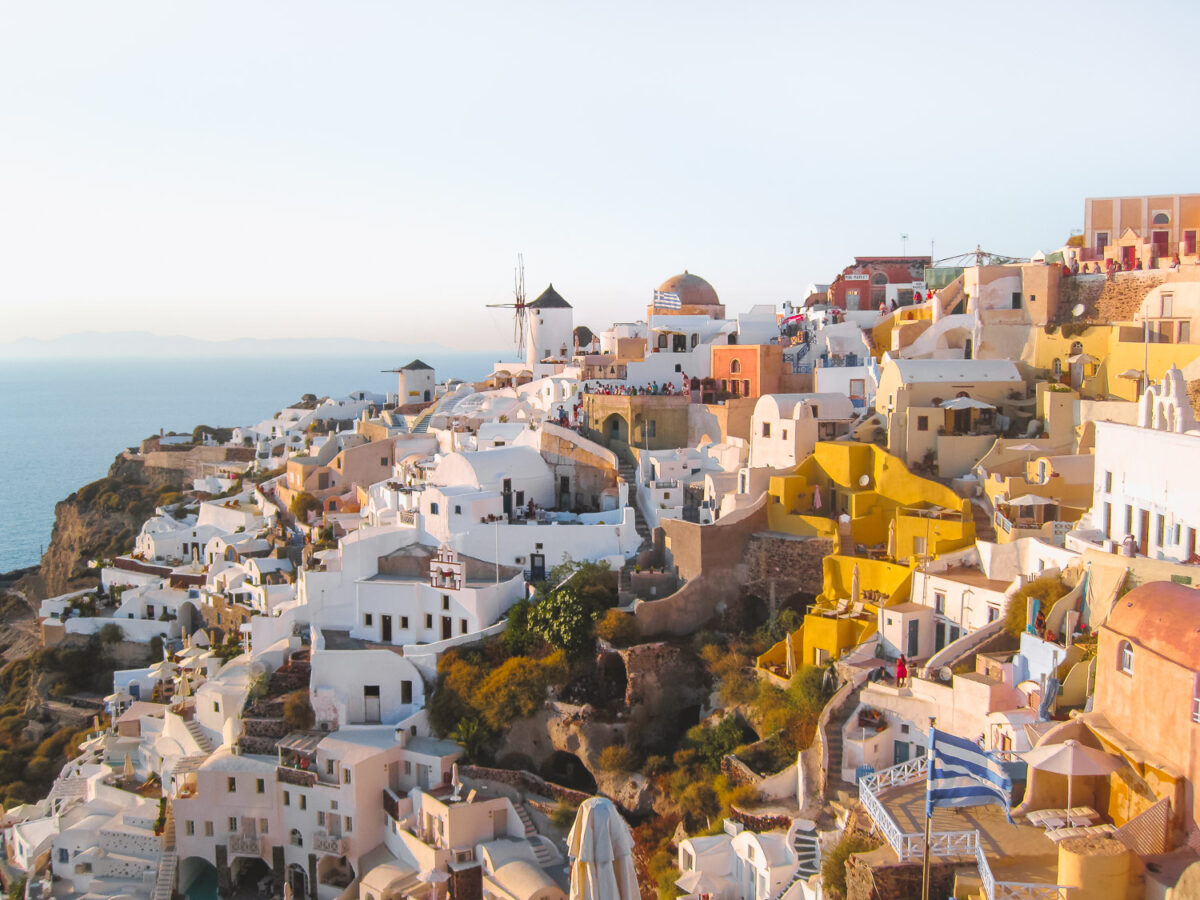ITINERARY
A week in Greece is certainly not enough time, so we decided to focus on the main highlights for our first trip. We spent the first half visiting sites of great historical and cultural significance and ended our trip relaxing on the tranquil beaches of Santorini.
DAY 1: ATHENS
Arrive in Athens. Buy bus tickets for Delphi. Spend the evening at the hotel rooftop or exploring the neighborhood of Plaka.
DAY 2: METEORA
Take the morning train to Kalambaka. Join the tour to take in sunset views of the monasteries. Visit the Monastery of Rousanou. End the evening with a panoramic sunset over the hills.
DAY 3: METEORA & ATHENS
Learn about the geological and cultural history of Meteora on a loop hike around the rocky pillars. Explore the Monastery of Great Meteoron. Relax in the evening over some drinks in the Makrygianni neighborhood of Athens.
DAY 4: DELPHI
Take the morning bus to Delphi to explore the tiered ruins of the ancient city. Later examine the well-preserved artifacts at the nearby museum. Back in Athens, eat at one of many restaurants and bars in Plaka.
DAY 5: FULL DAY IN ATHENS
Start the day with a visit to the famous Acropolis. Later study the Parthenon artifacts at the award winning Acropolis museum. Continue the day with visits to other historical sites – Panathenaic stadium, Ancient Agora, Roman Agora. In the evening, walk towards Monastiraki for souvenir shopping at the flea market.
DAY 6: SANTORINI
Take an early morning flight from Athens to Thira. Hike from Fira to Oia, exploring the towns, churches and the rocky cliffs of the volcanic caldera. After a beautiful sunset, spend the rest of the evening with dinner and drinks in Oia.
DAY 7: SANTORINI
Rent to a scooter to visit the historical ruins of Akrotiri. Learn about the great volcanic eruption that shaped Santorini. Spend the rest of the day relaxing at the iconic Red Beach. Return to Fira for another picturesque sunset.
DAY 8: SANTORINI
Take a bus to Kamari Beach on the east coast. Spend the entire day lazing around on this black sand beach. Later in the evening, enjoy the romantic sunset at Amoudi Bay. End the trip with alfresco dining at the bay or in the town of Oia.
DAY 9: HOME
Fly back to Athens and take a return flight home.
Athens is one of the world’s oldest cities and also the capital city of Greece. It is regarded as the cradle of Western civilization and the birthplace of democracy. In the past it was the center for arts, literature, and philosophy and in modern times Athens hosted the first ever Olympic games.
DAY 1: ATHENS
We flew the red eye to Athens, arriving in the capital on a Saturday evening. After clearing immigration we took a taxi to our hotel – Novotel Athenes.
It didn’t take us long to freshen up and get ready to go out. Our only goal for the day was to secure roundtrip bus tickets to Delphi for our trip 3 days later. As we gathered our things to leave, Kaushal realized his phone was missing, he had left it in the cab. It was hard to believe this happened in the first few hours of the trip. We rushed to the hotel lobby, hoping they could help us track down the yellow taxi company. But unlike New York there are several yellow taxi companies in Athens and no central lost and found. Now it was all up to the driver. We left our name and room number in case the driver tried to reach out.
Buses to Delphi are operated by KTEL. Since there wasn’t much information on the web, we had to get these tickets in person. From the hotel we took a 10min taxi ride to KTEL bus station – Terminal B and were easily able to buy tickets to Delphi.
With this out of the way, we decided to walk back. The hotel is situated in a quiet neighborhood, outside the city center. While this is not a popular tourist neighborhood, the main reason we stayed here was for of its proximity to the Athens Larissa railway station and KTEL bus terminal. As we walked back to the hotel we encountered several dilapidated buildings, shuttered storefronts, broken glass windows and graffitied walls. This wasn’t what we had imagined the capital to look like. Afterall it was one of the greatest historic cities like Rome, London or Paris. It was hard to tell if this was the effect of the recent recession or something else.
When we returned to our hotel, we were met with amazing news. The taxi driver had called and promised to return the phone later that night. We couldn’t be happier. We left a tip for the driver and headed up to the rooftop to celebrate our luck over drinks. The hotel rooftop has a small swimming pool, a gourmet restaurant and best of all uninterrupted views of the Acropolis.
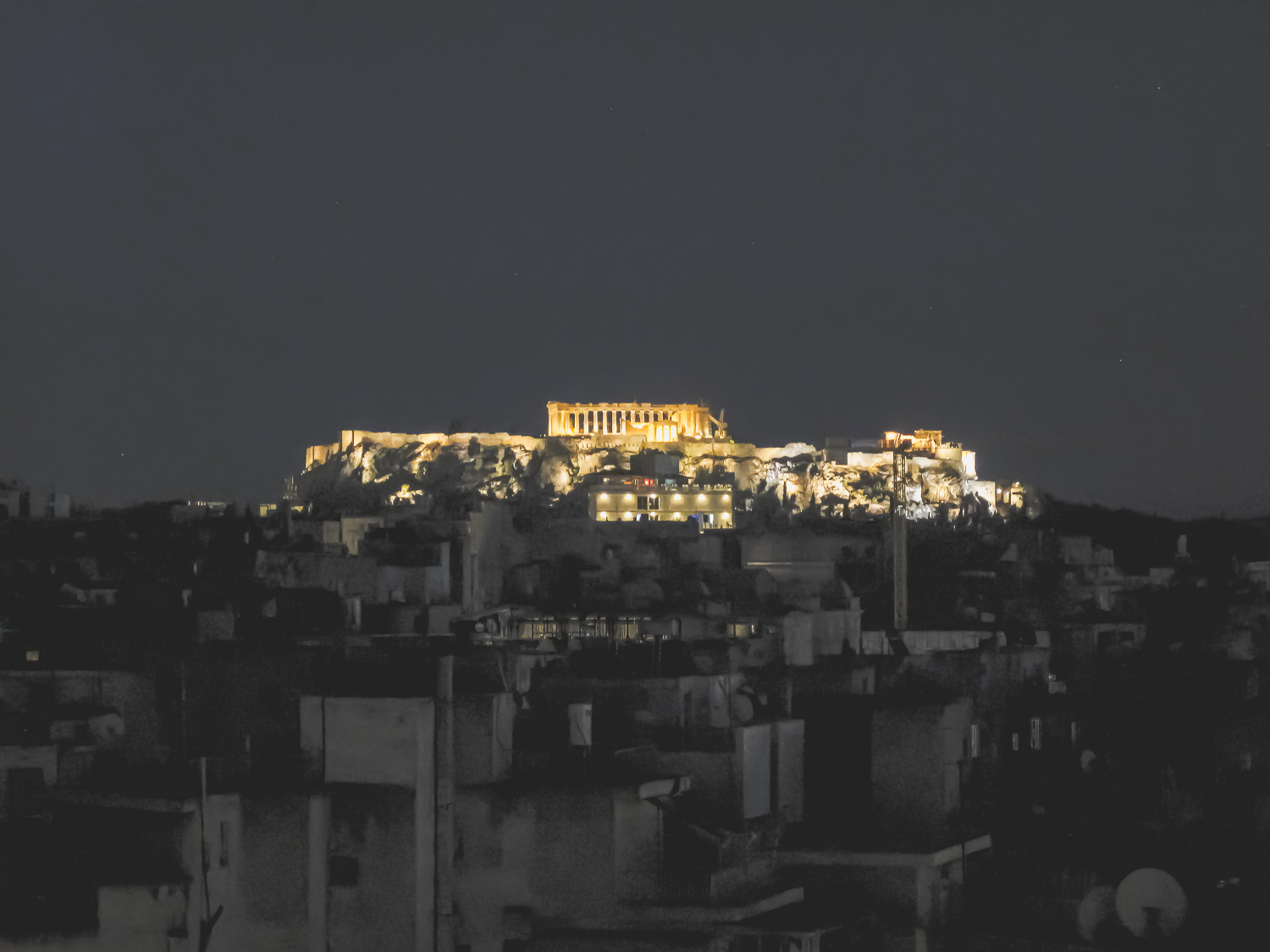
Jetlagged and tired we decided to eat dinner there while taking in the twinkling lights of Parthenon.
Meteora is a UNESCO world heritage site in Central Greece. Derived from the greek word metéōros meaning “raised from the ground, hanging, lofty” the name justly describes the natural stone columns rising from ground and the beautiful monasteries that sit atop. An interesting factoid – Meteora is also where Linkin Park got the name for their hit album.
DAY 2: METEORA
We knew we had to visit Meteora from the very first pictures we saw of monasteries resting high in the sky on towering rock pillars. So we reworked our itinerary to substitute Meteora for Mykonos (we’ll have to catch it on our next trip!).
Our train left Athens Larissa Railway station at 8:30 AM and we arrived in Kalambaka around noon. Kalambaka is the main town near Meteora and has most of the hotels and restaurants in the area. But instead of staying in the town we decided to stay closer to the rocks at the beautiful Doupiani house. It was the right decision. From our balcony we not only had a panoramic view of the hills but the place itself was extremely peaceful.
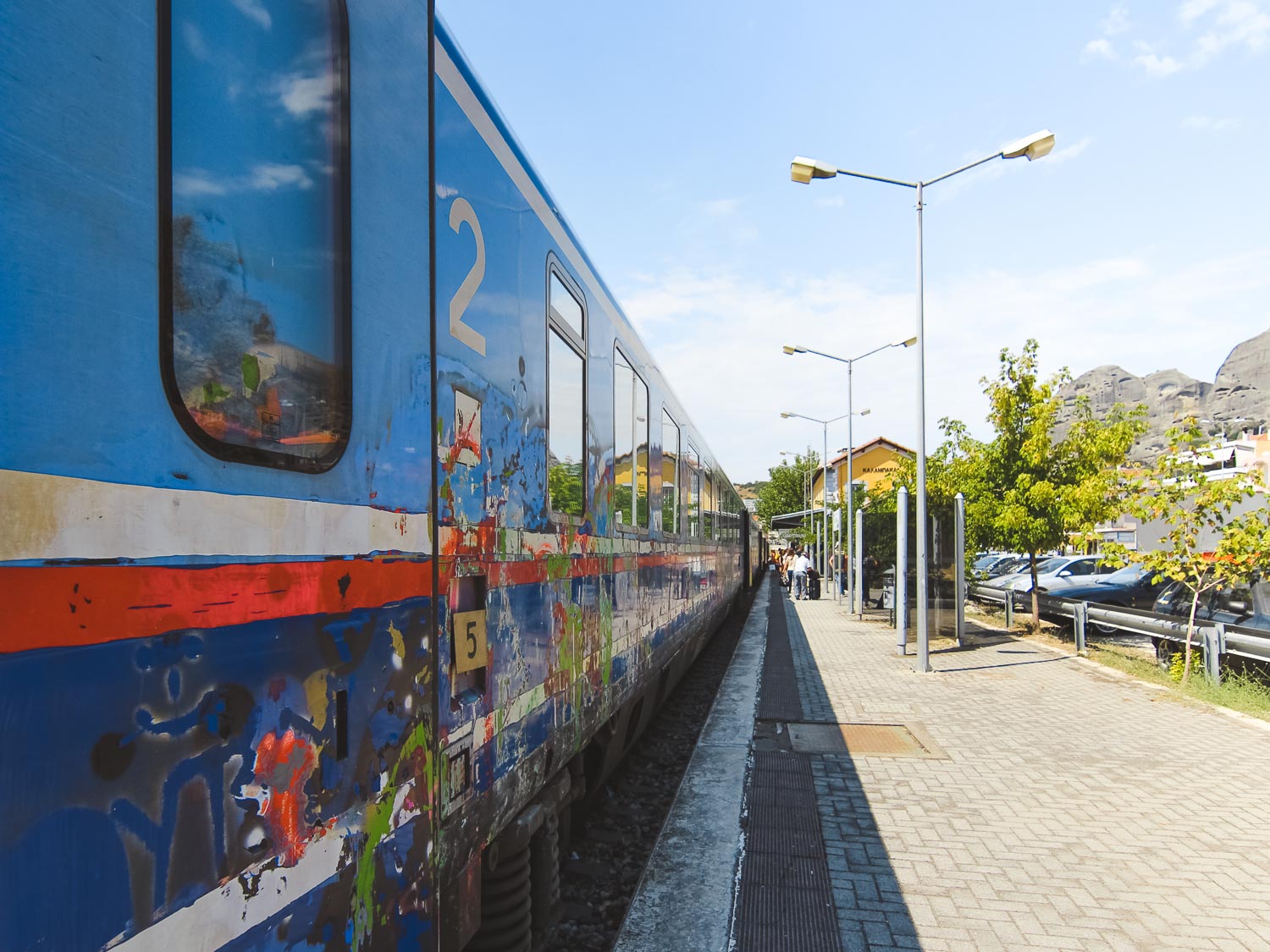
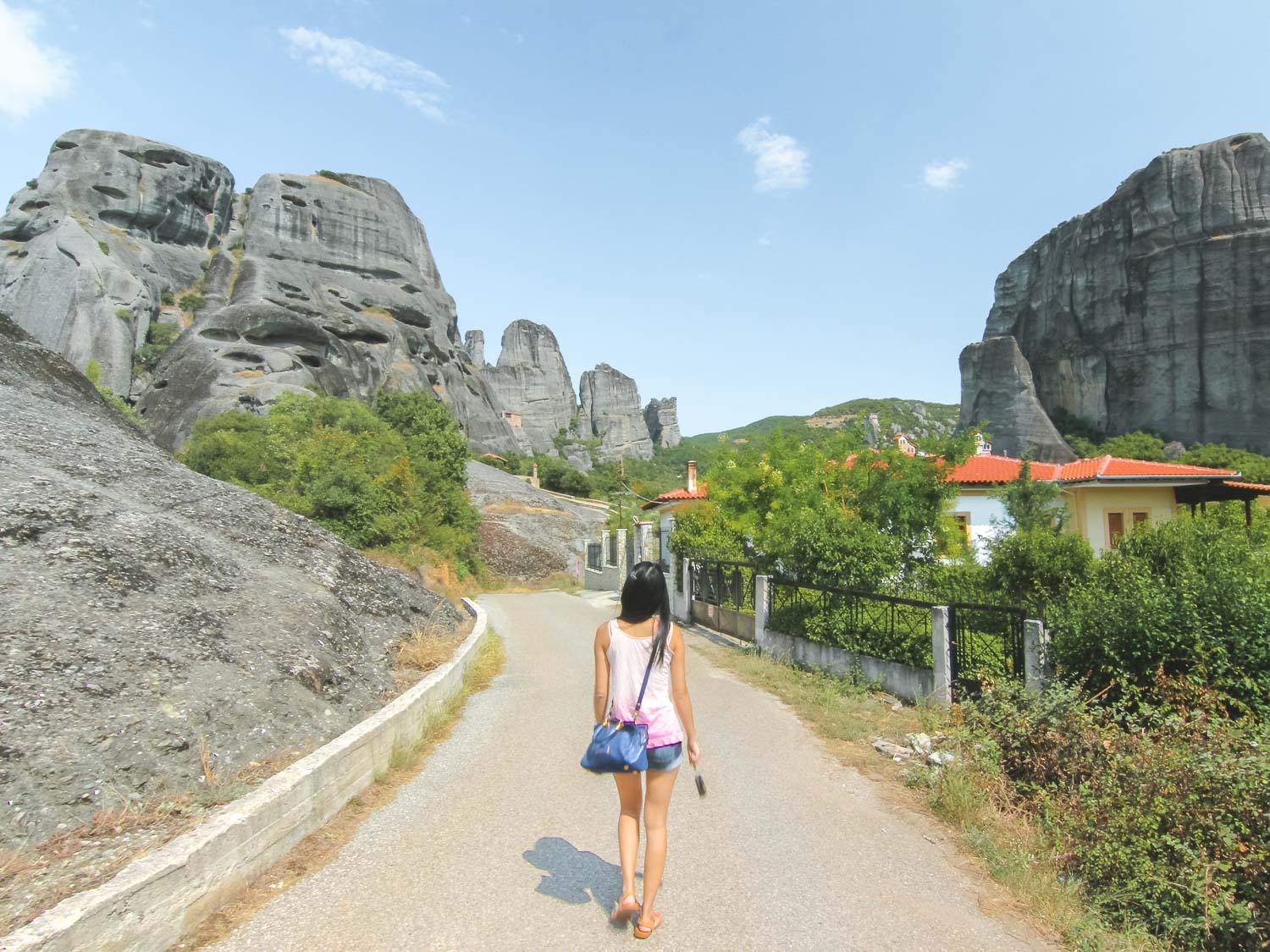
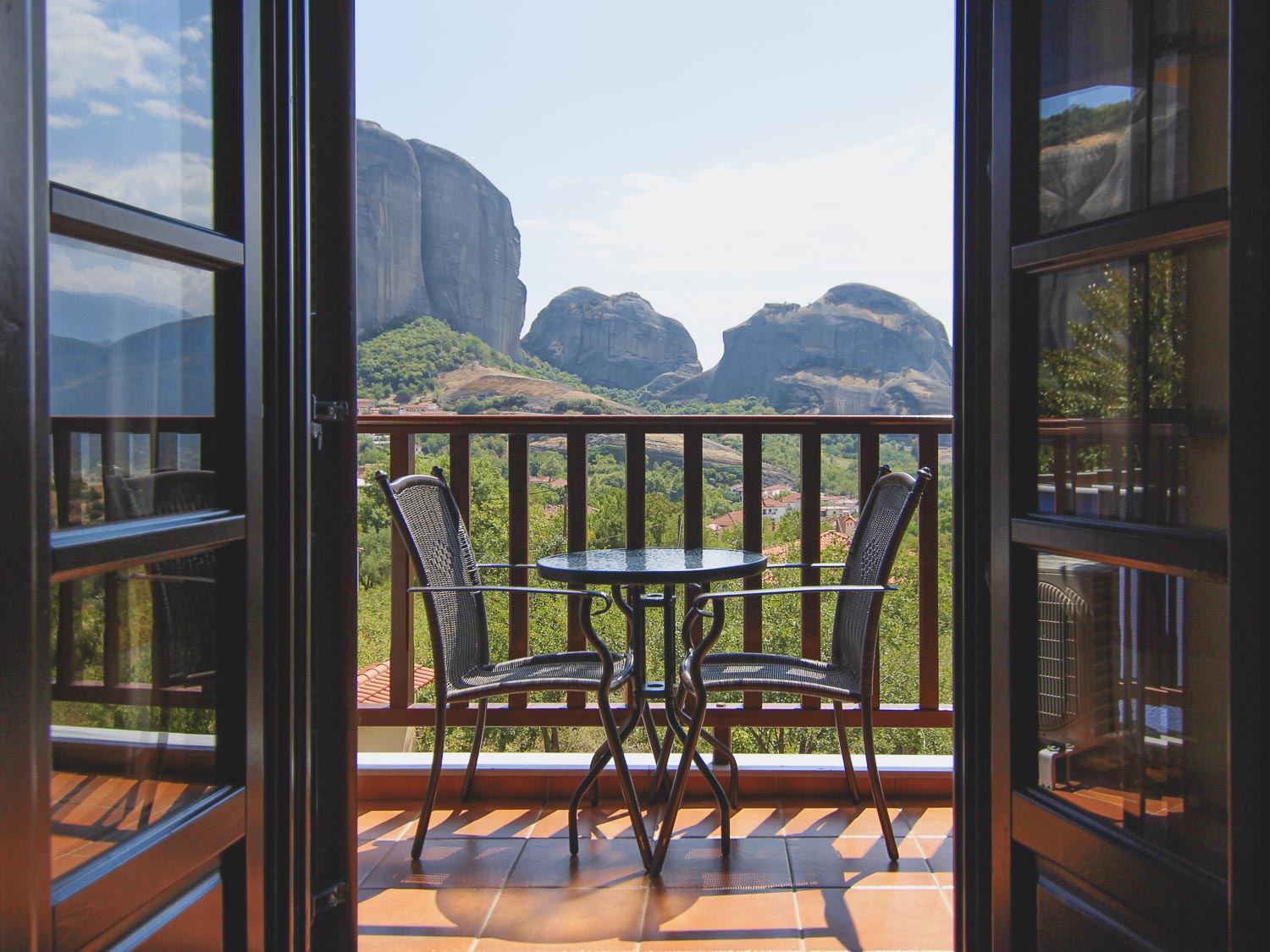
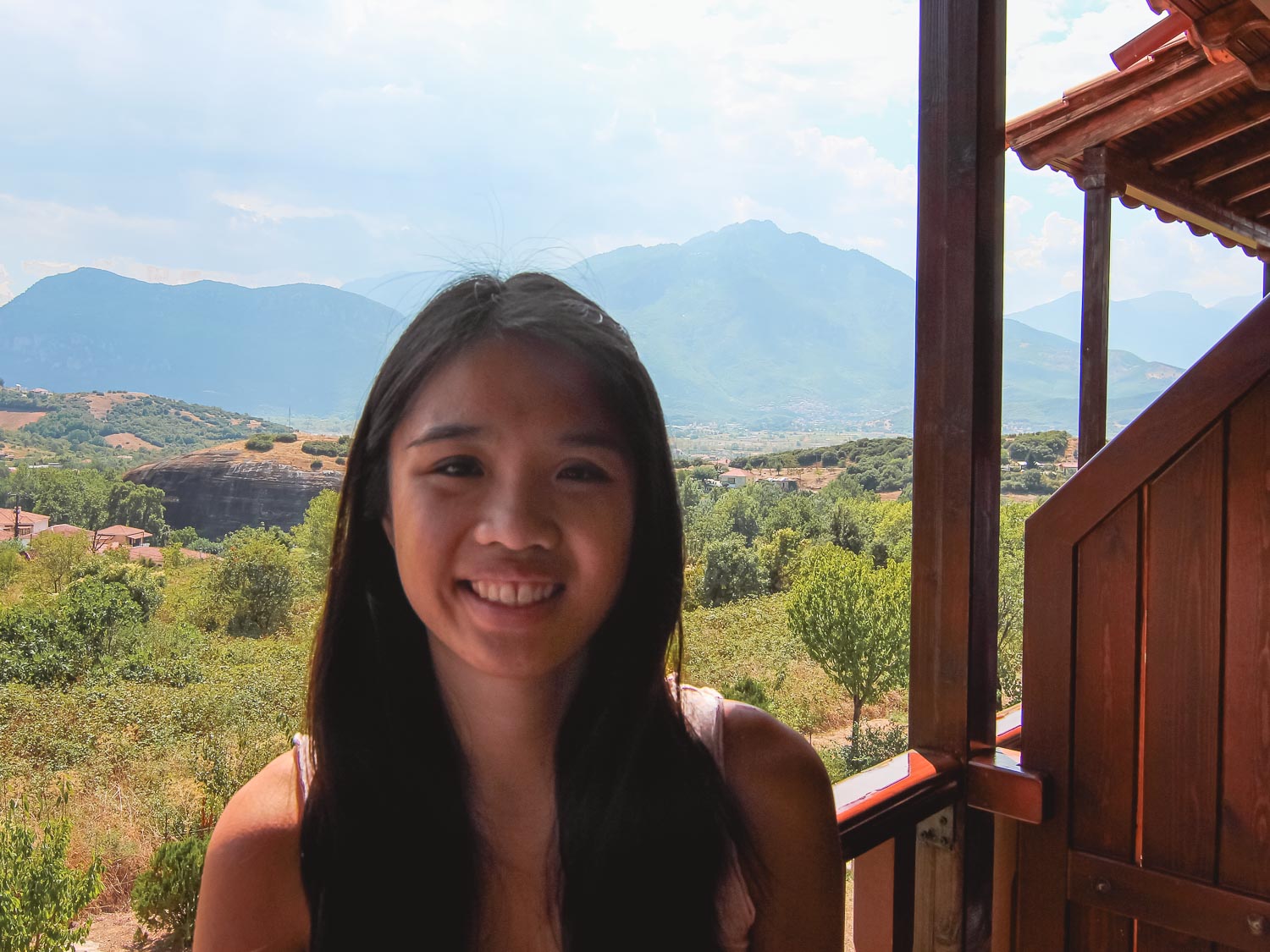
After we got settled in, we walked down towards Kalambaka and ate at our first greek restaurant, Taverna Meteora Vavitsas.
After lunch, our tour guide from Visit Meteora picked us up for a sunset tour of the monasteries. The tour groups are relatively small which was definitely one of our considerations in booking this tour. Our first stop in the hills was to look at the Monastery of Saint Nicholas Anapafsas, the smallest of all the monasteries. From the vista point, the monastery looked like an extension of the rock pillars, nestled above and around a small rock pillar.
Our next stop was a lookout point from which we could see 4 of the 6 monasteries, the Monastery of Saint Nicholas Anapafsas, the Monastery of Great Meteoron, the Monastery of Varlaam and closest to us, the Monastery of Rousanou. While we could see the road wrapping around the cliff on which the Monastery of Rousanou sits, the entrance wasn’t immediately clear. But as we got closer to the monastery, we could see trees obscuring the stairs that were built into the cliffside. Before the stairs were added, monks in the past used retractable ladders or pulleys to move up and down.
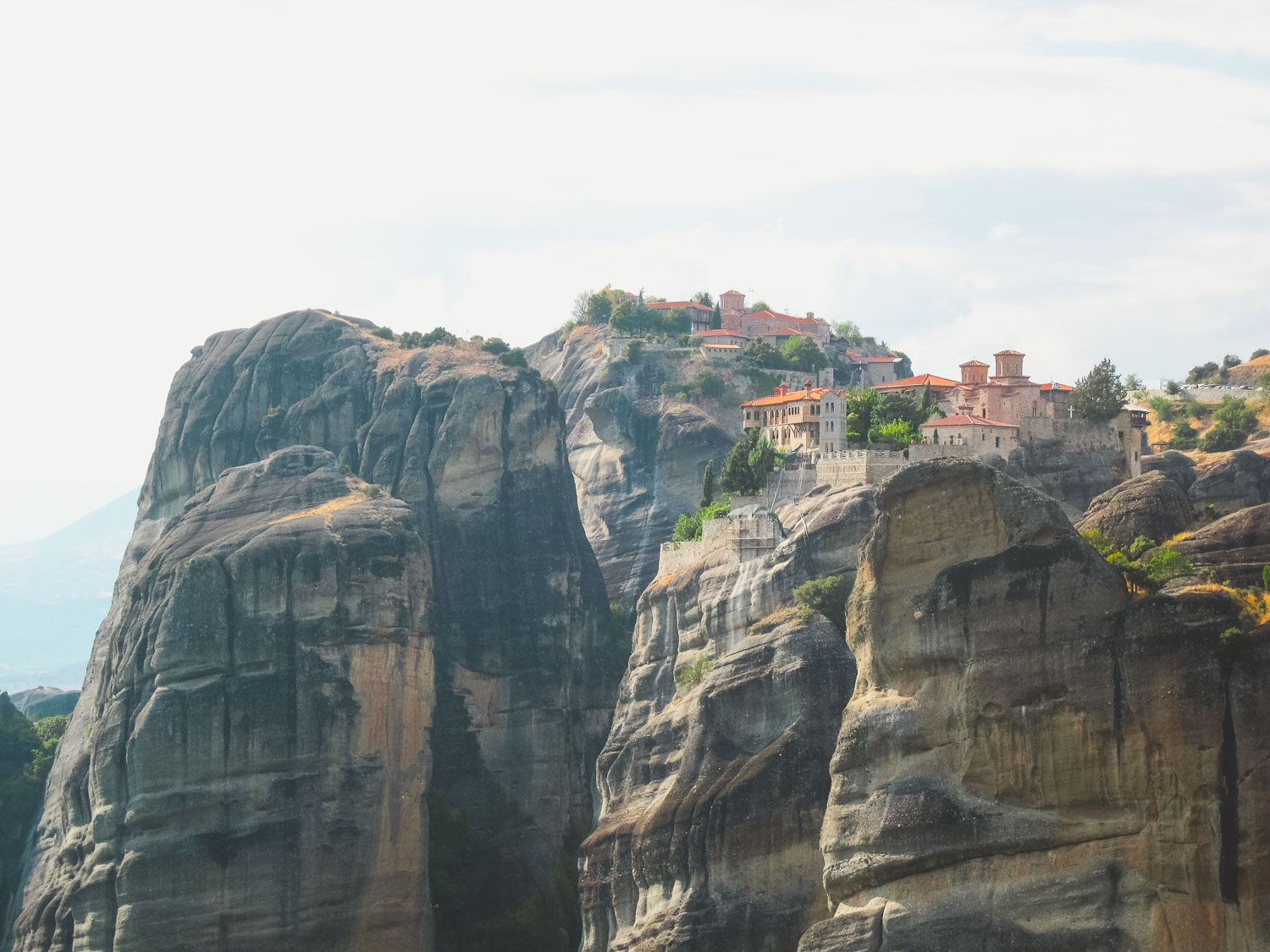
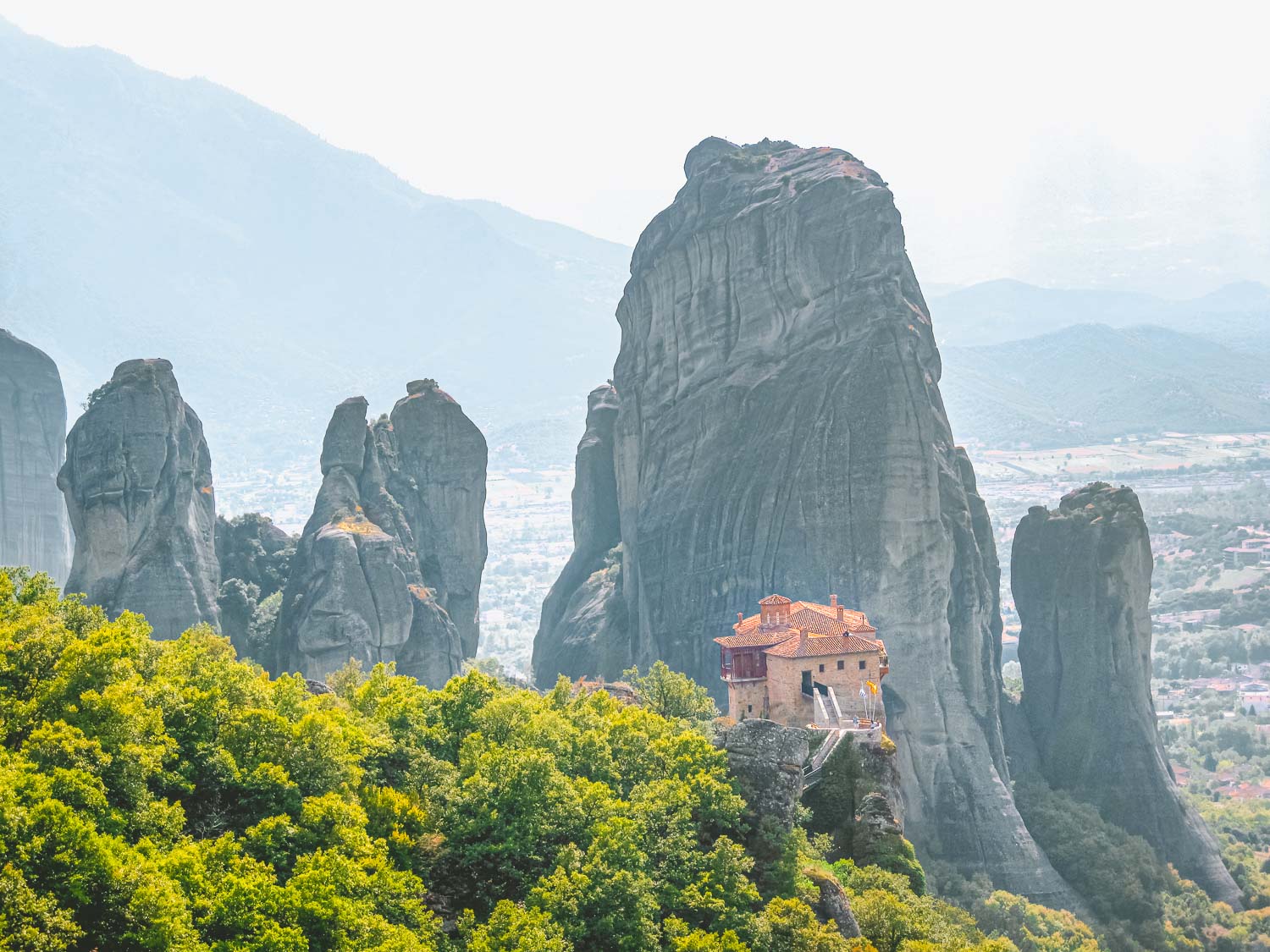
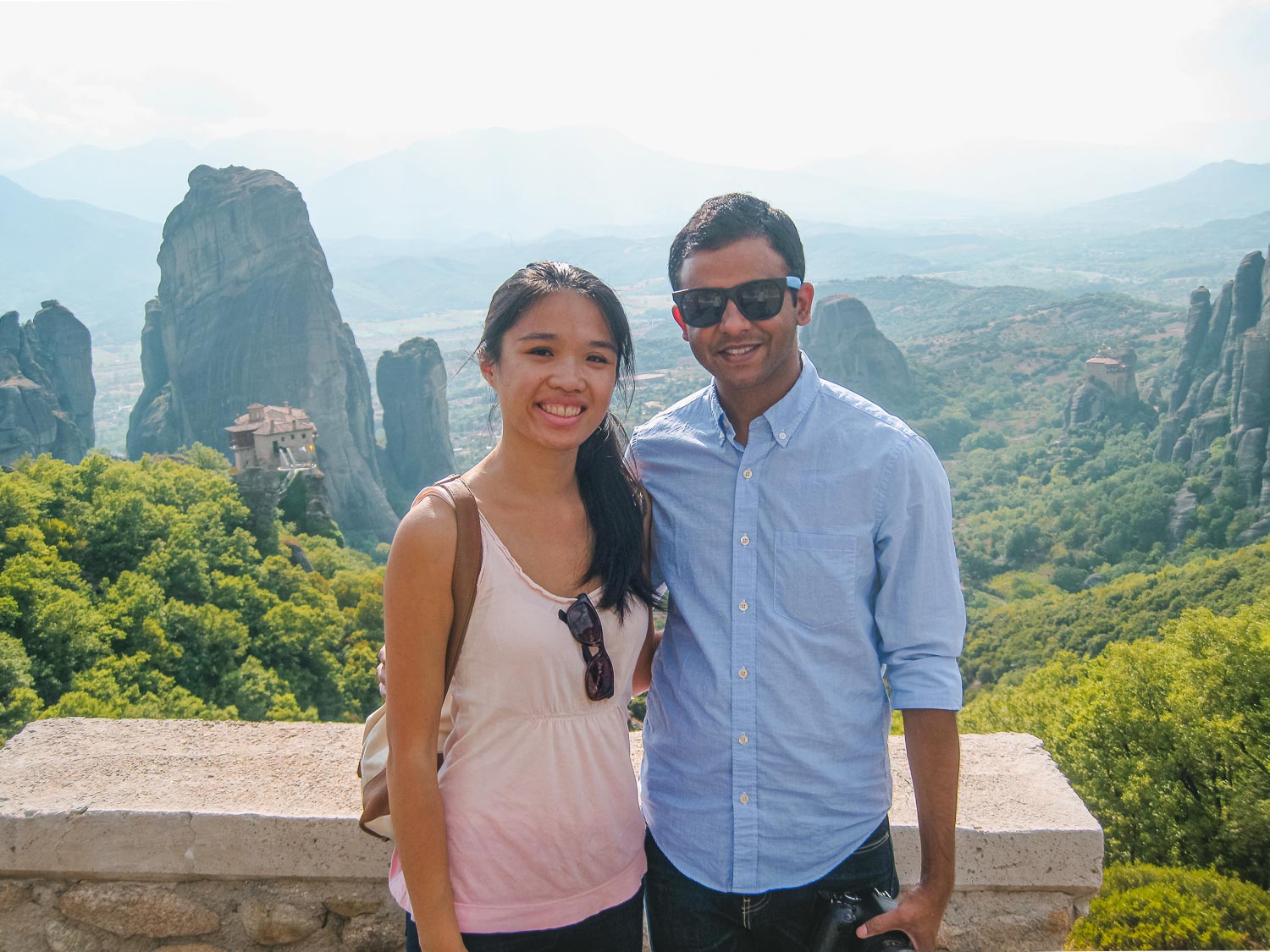
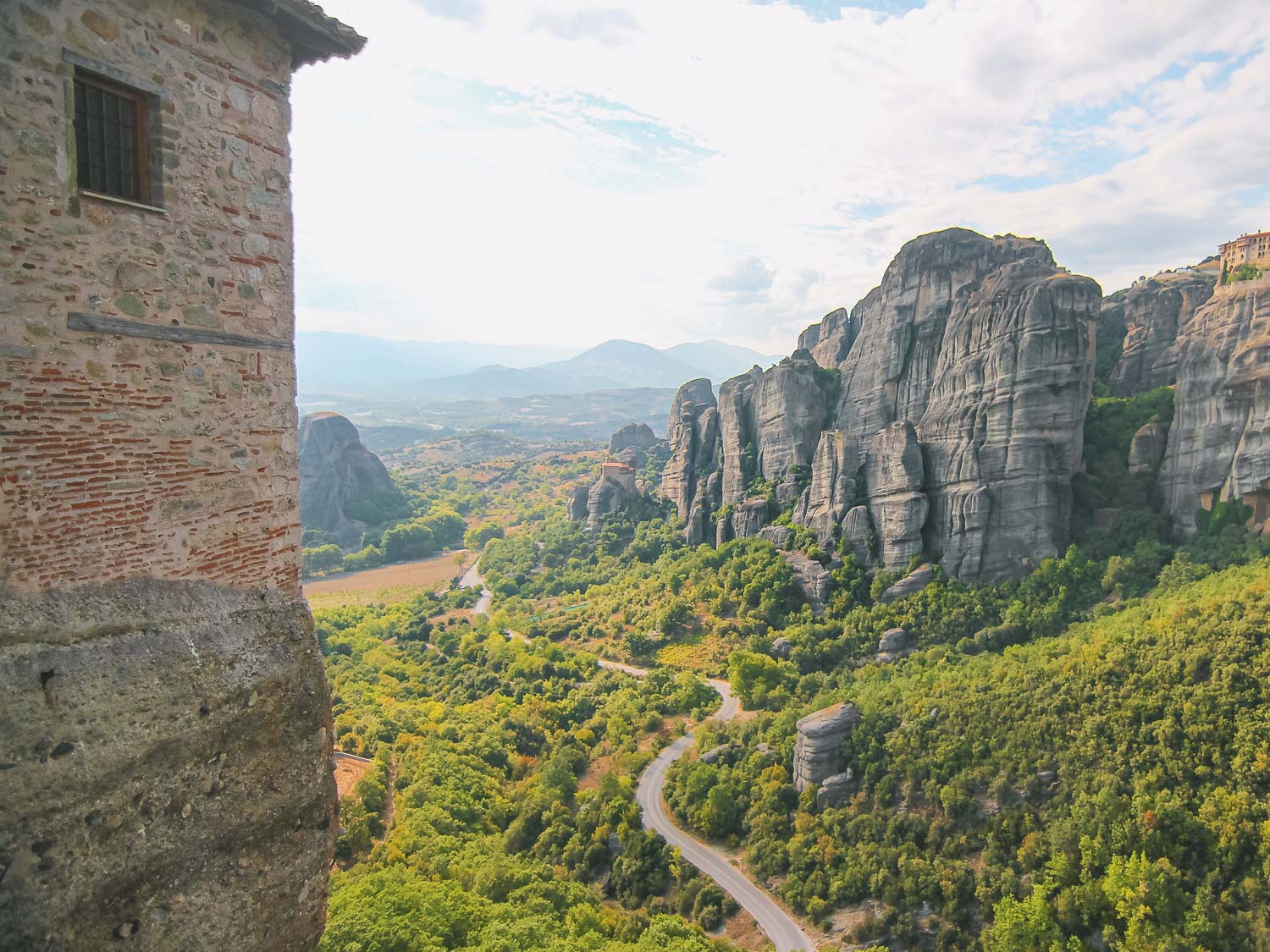
We took a short detour and visited the Monastery of Rousanou which can be reached by climbing a set of stairs and crossing a metal bridge. The monasteries have a strict dress code, men must wear trousers and long sleeves, and women must wear a long skirt. In case someone forgets to bring one, the monasteries will provide a skirt covering. On the inside, the rooms felt very open and projected a sense of calm, with most visible construction made of stone and wood. From the balcony we were truly able to appreciate the steep drops and the huge amount of effort it must have taken to build this place atop a mountain. If we could, we surely would have spent a night here.
From the Monastery of Rousanou, we drove up the hill towards another viewpoint to see the Monastery of Great Meteoron and the Monastery of Varlaam up close. The Monastery of Great Meteoron is the largest of the monasteries. From the viewpoint we could see a set of stairs snaking up the cliffs that led to a vast complex resting on the cliff edge. Not far away is the Monastery of Varlaam, the second largest monastery in the area, which occupies every inch of the cliff top. Varlaam monastery is slightly lower in elevation than Great Meteoron, so from the lookout it is much easier to see all the intricate details in its construction.
Right next to the Monastery of Varlaam is a rocky outcrop which provides another picture perfect view of the Monastery of Rousanou. After a bit of scrambling we arrived at the edge of the cliff where we had an uninterrupted view of the monastery. Nestled between the towering cliffs, the monastery seemed like an extension of the cliff itself. This was perhaps the best of the lookout points so far. We could have spent a lot more time there, but there were more things left on the itinerary.
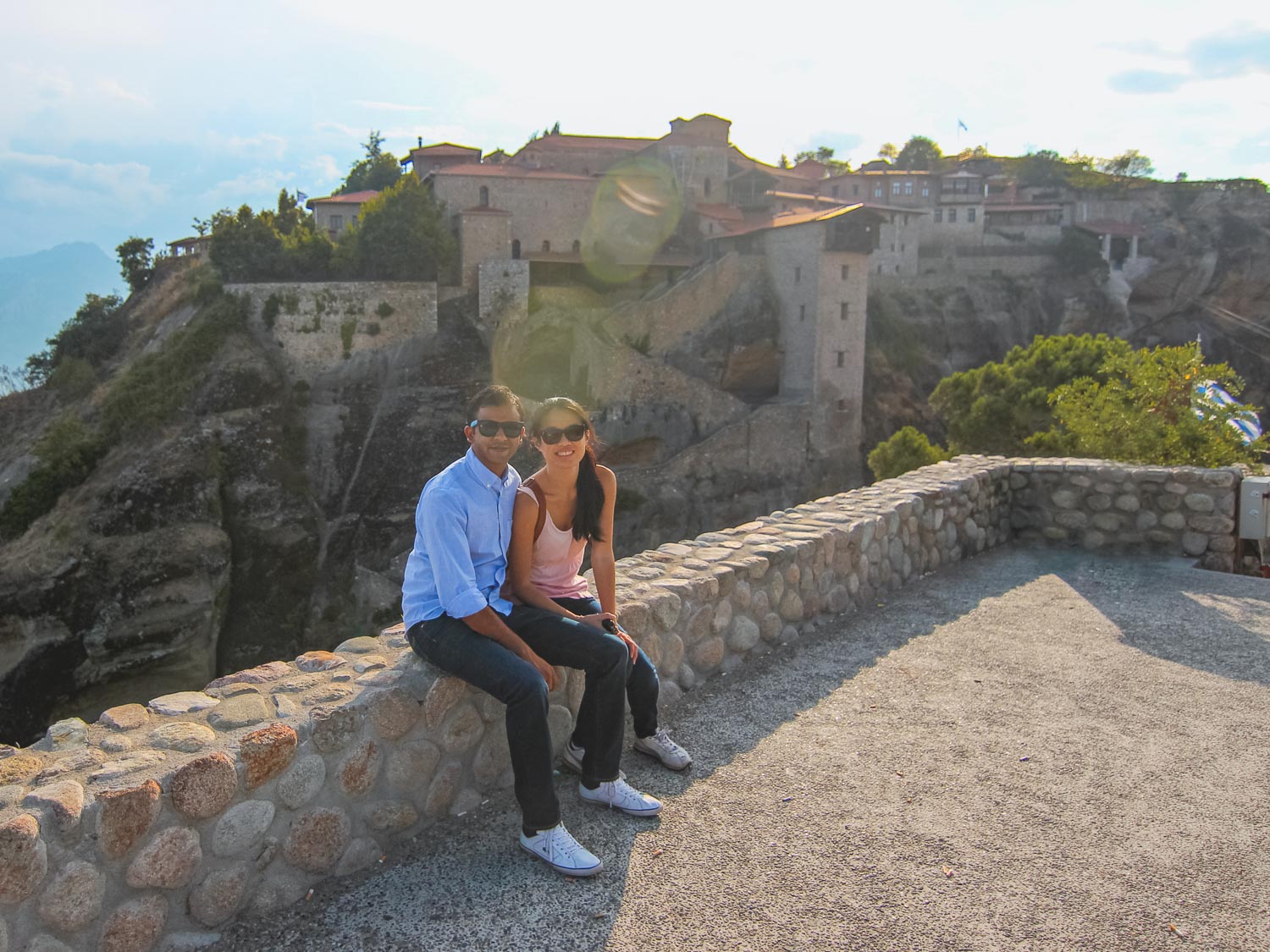
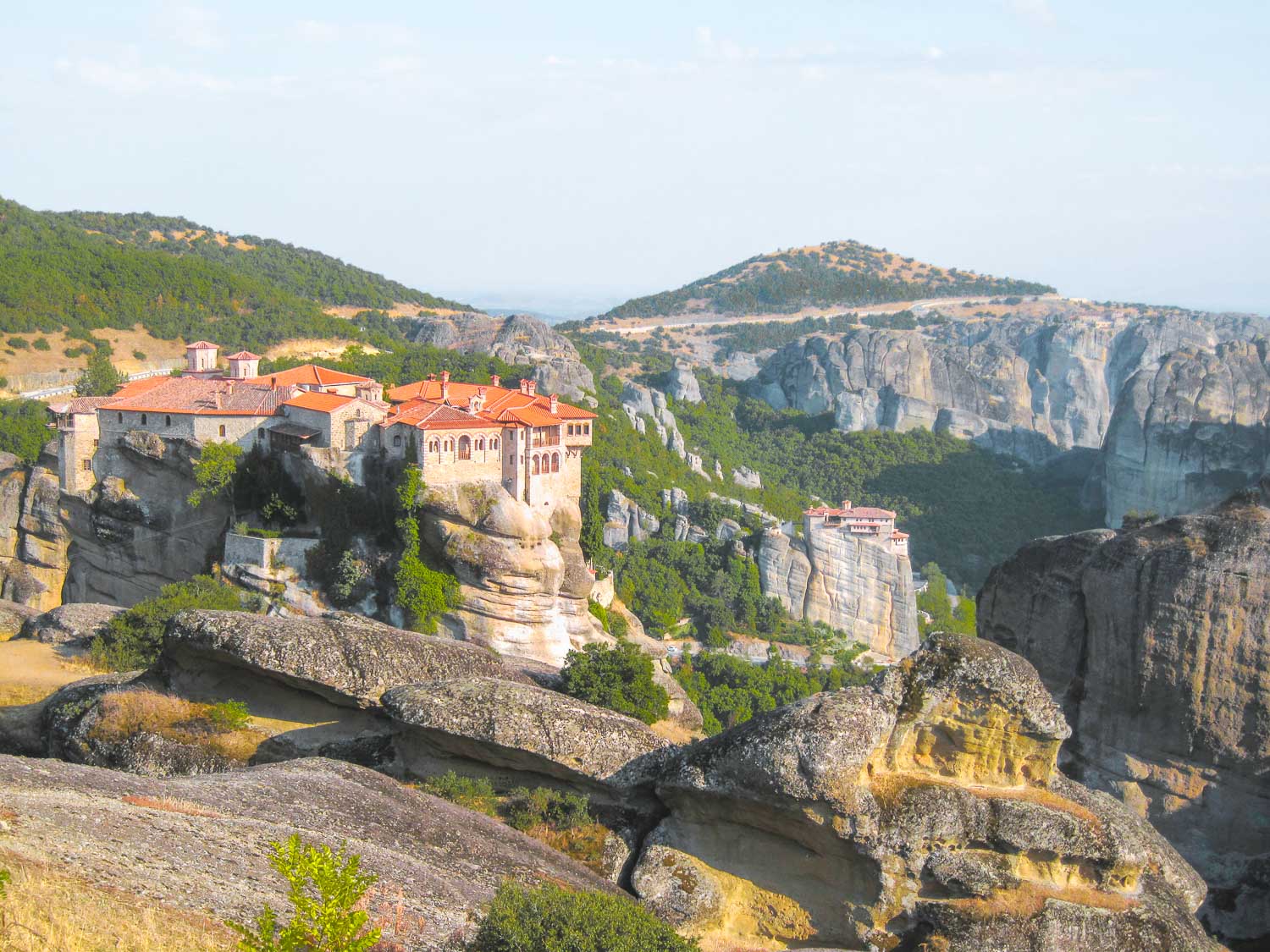
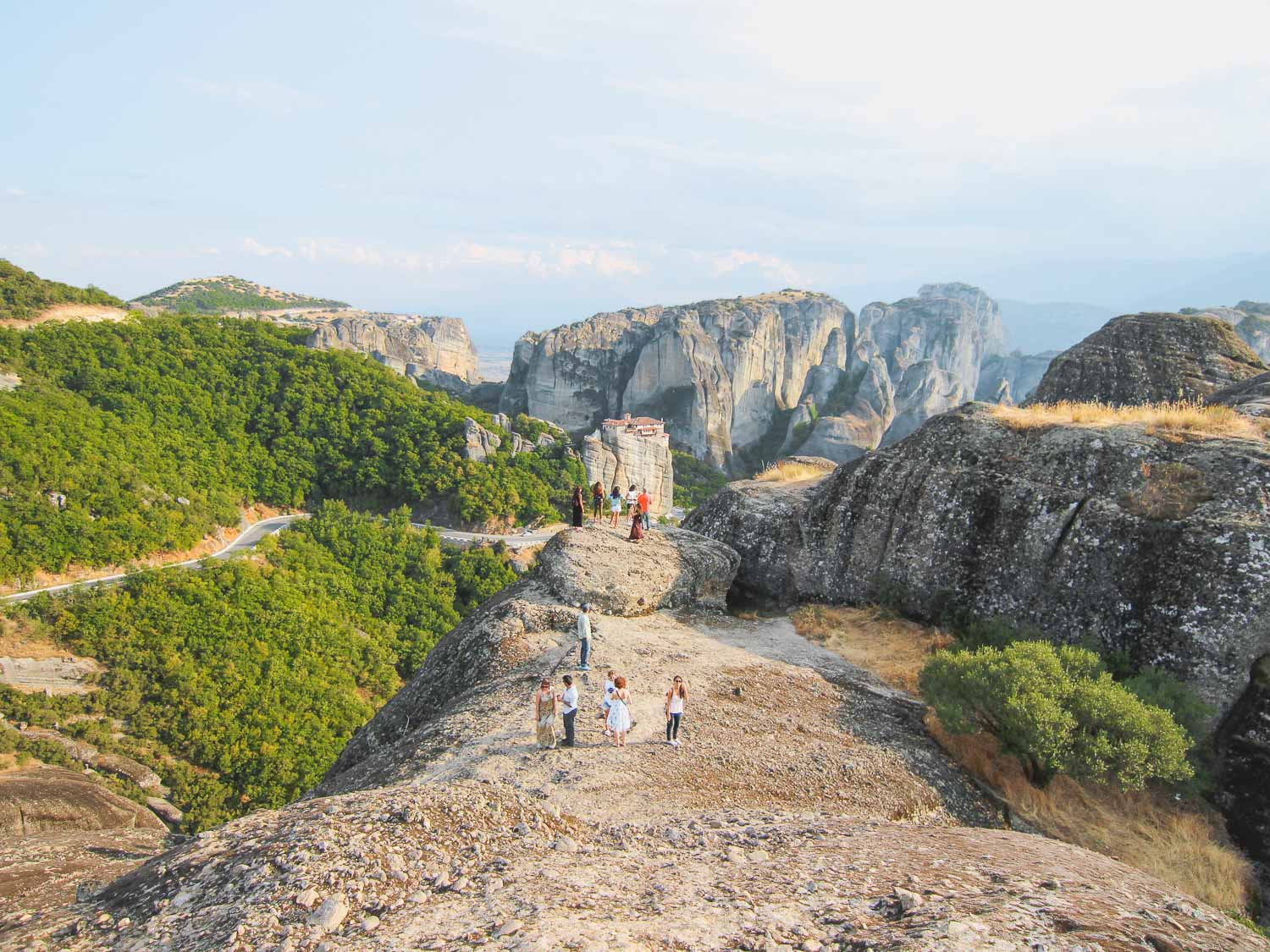
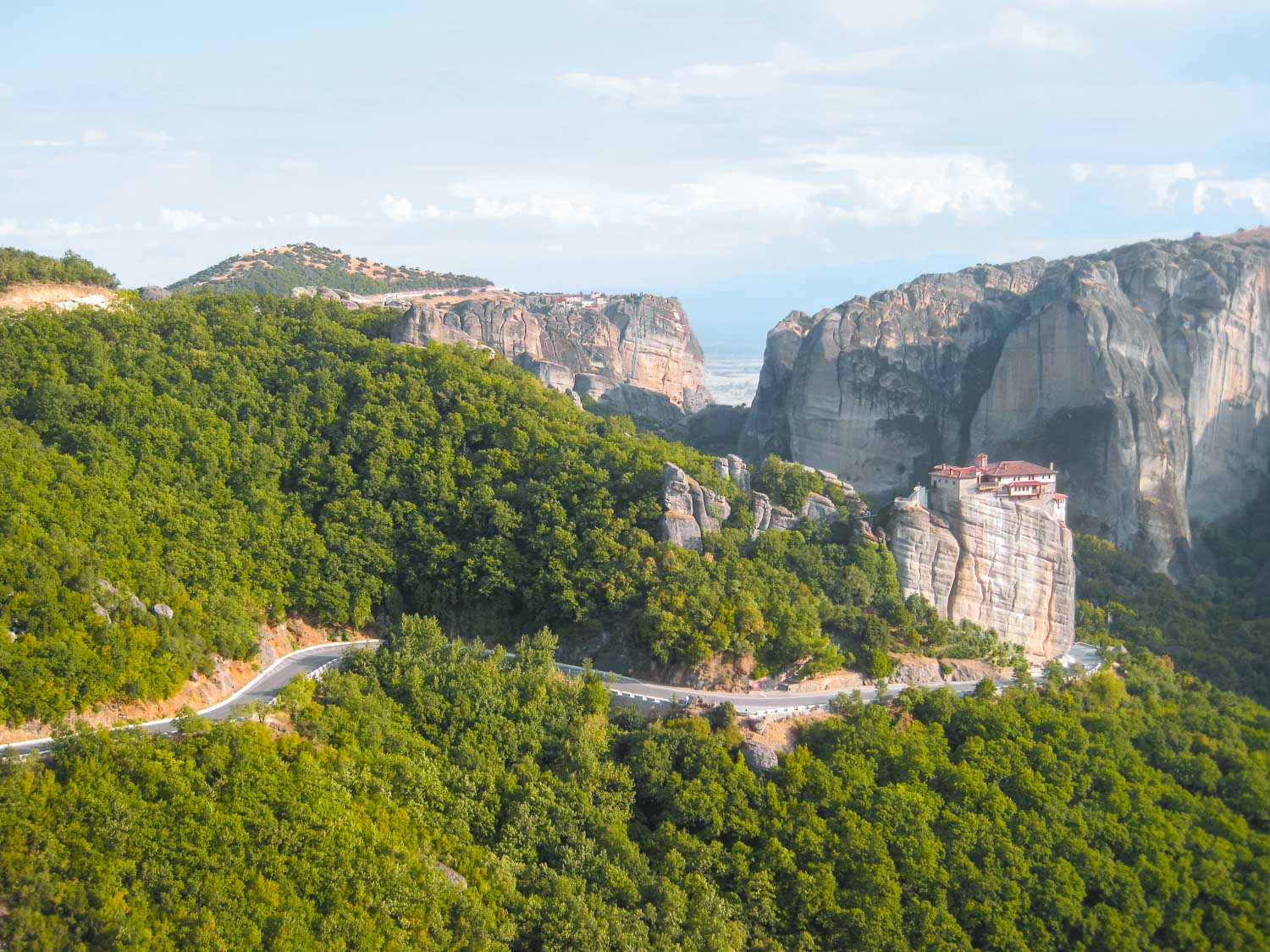
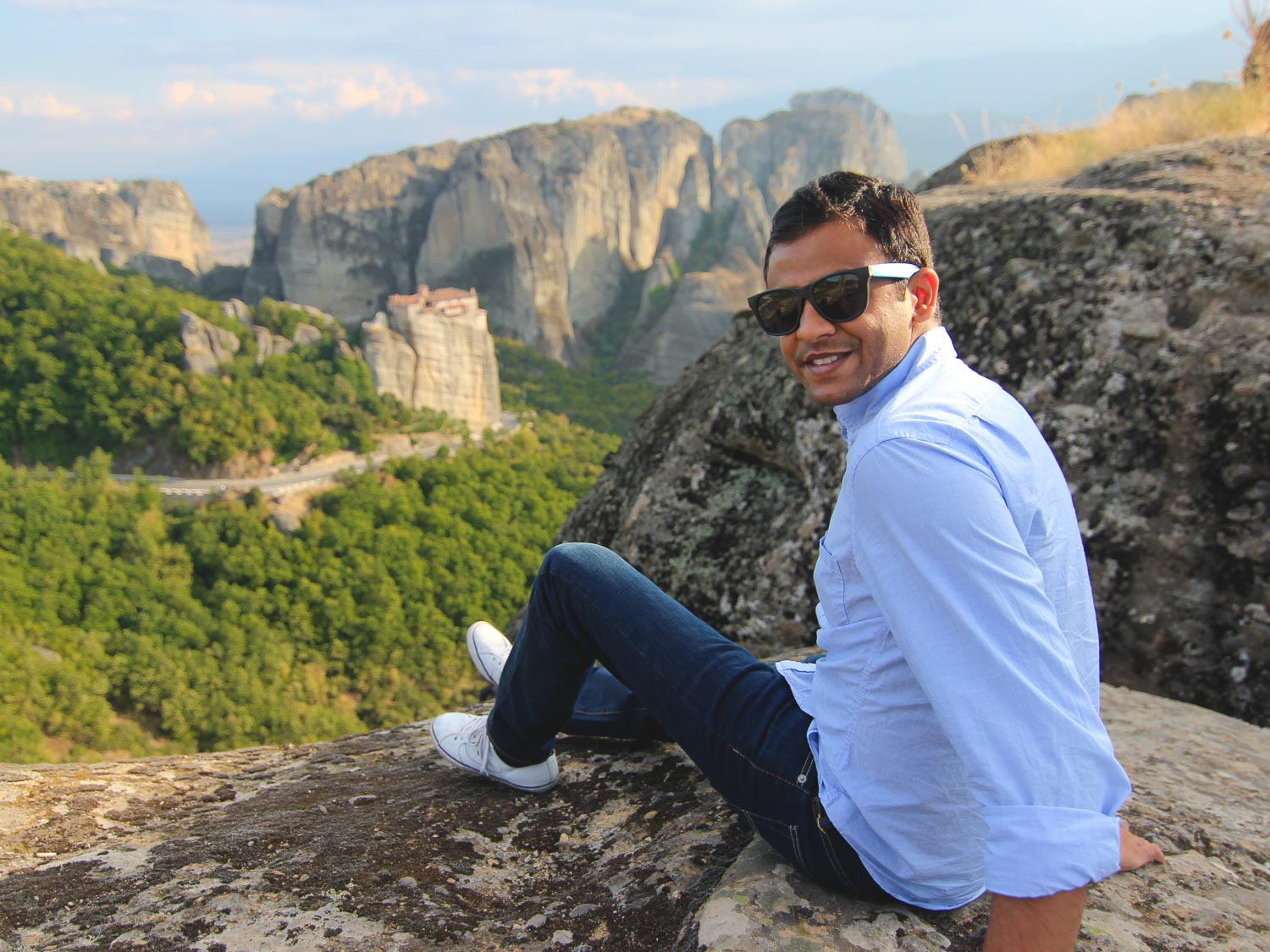
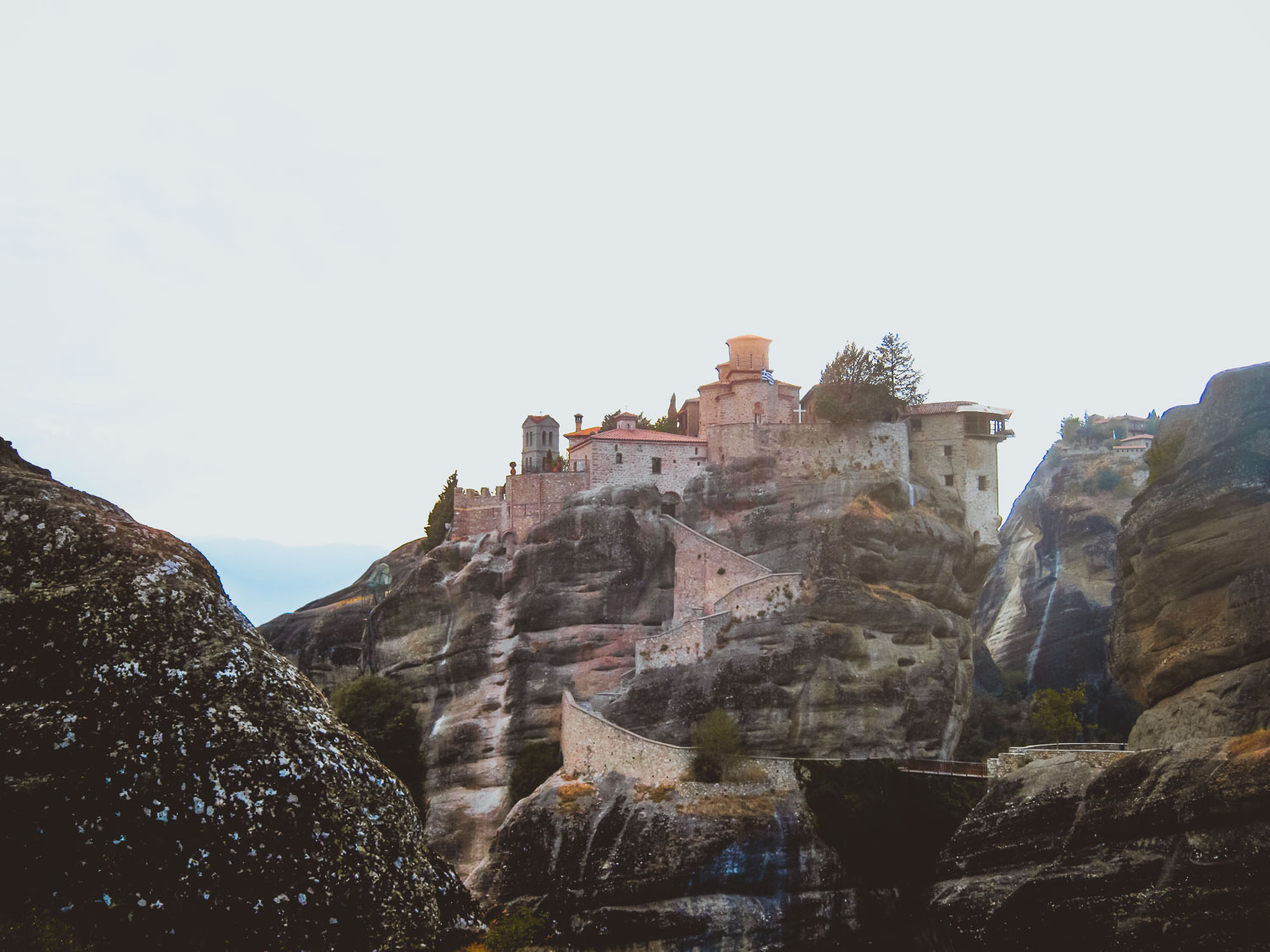
Next on the tour was the Holy Temple of the Dormition of the Virgin Mary, a byzantine era church in the old town of Kalambaka. This 11th century church was built to replace a late antique church, which itself was built over an ancient temple of Apollo. The long history is visible in the walls of the church with materials from different eras used in its construction, an excellent example of spolia. It was already evening by the time we left the church and the sun had started to set. On our way to the sunset point, we made another quick stop on an unmarked street to view the rocks of Meteora from afar. From here we could see the entire town of Meteora resting on the slopes of the sun soaked rocks that stand tall behind it.
After a short drive we finally arrived at the sunset point situated on top of a cliff. The point has 360 views of the sandstone towers and the valley below. On the right we could also see the Monastery of Rousanou and Saint Nicholas Anapafsas perched above the cliffs, basking in the last rays of the sun. We spent the rest of the evening admiring this unique geological formation and thinking about the monks who made this place home. It was the perfect ending to a long day. As the sun dipped below the horizon we got back in the van and made our last stop to see the Monastery of St. Stephen.
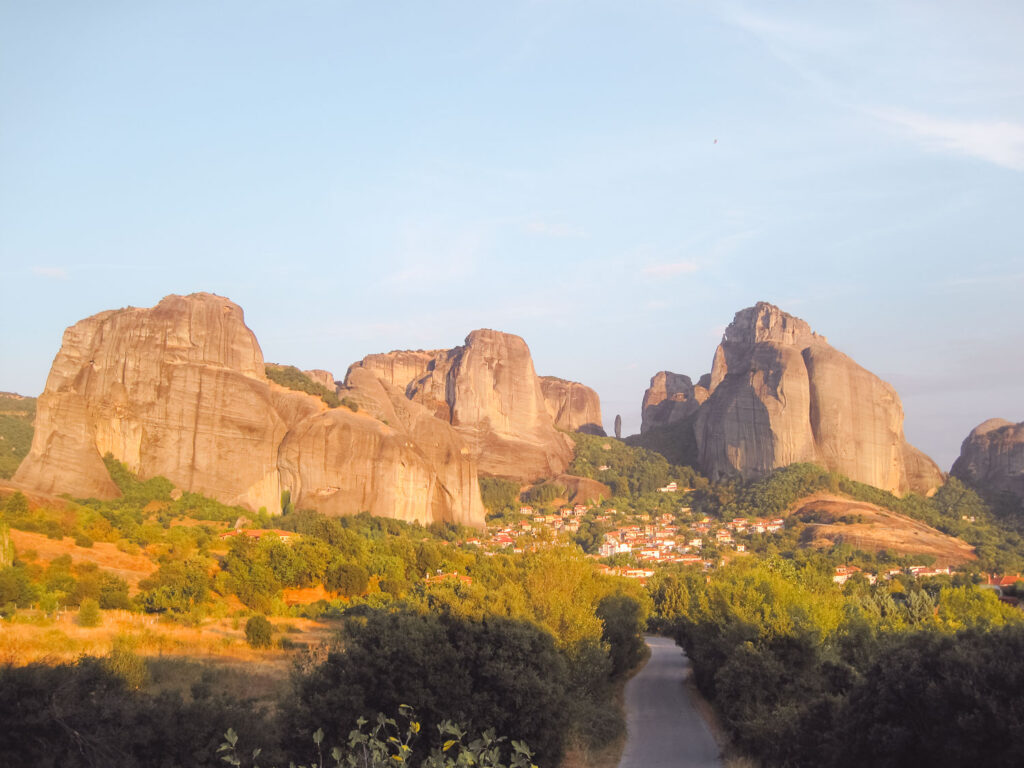
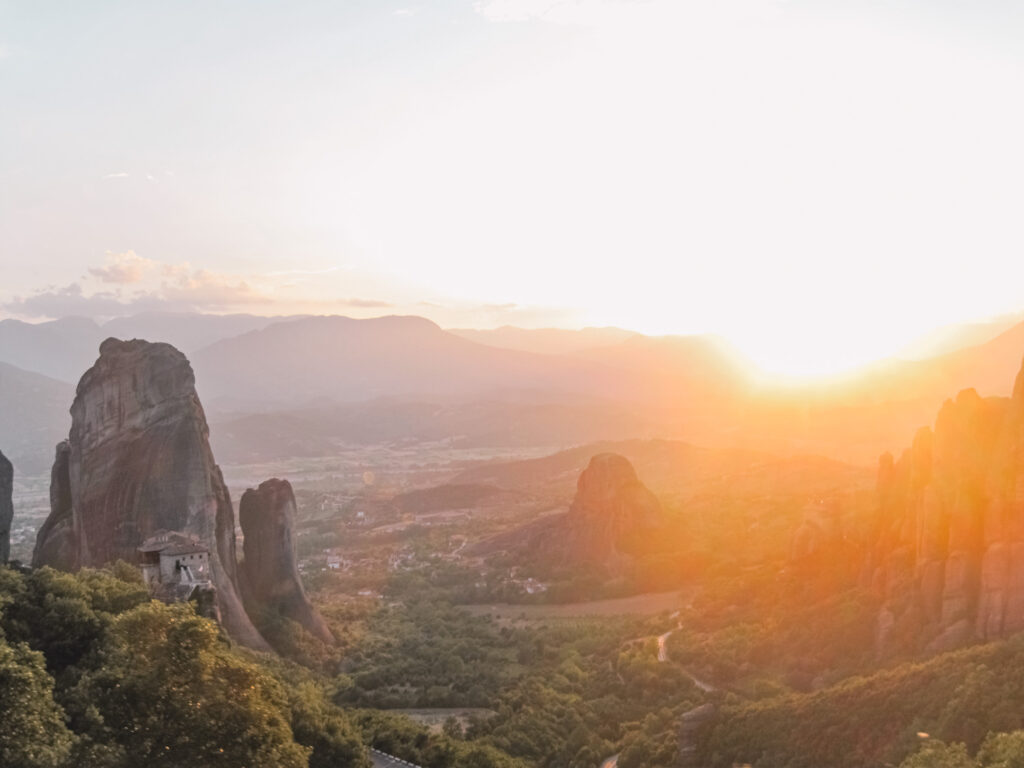
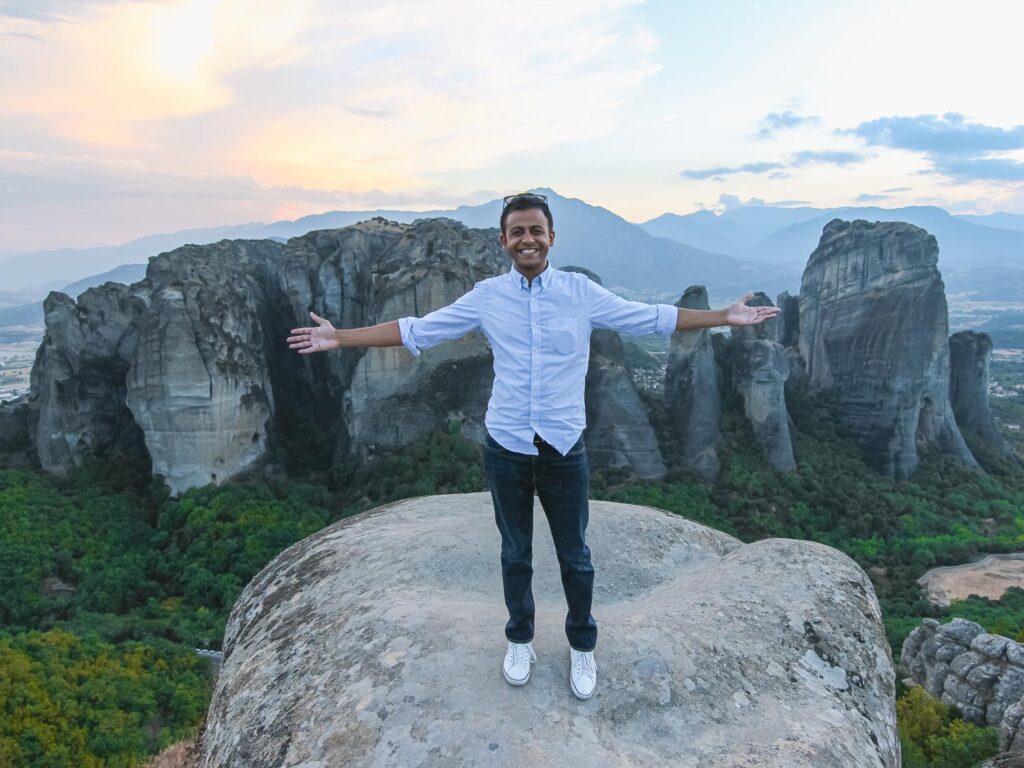
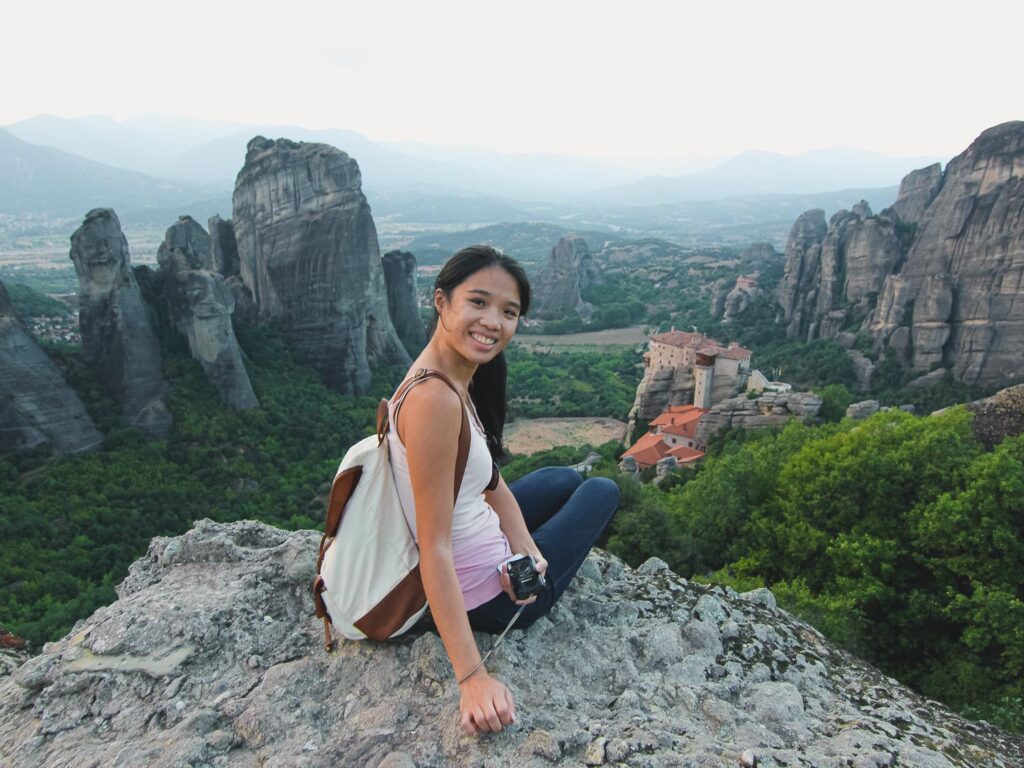
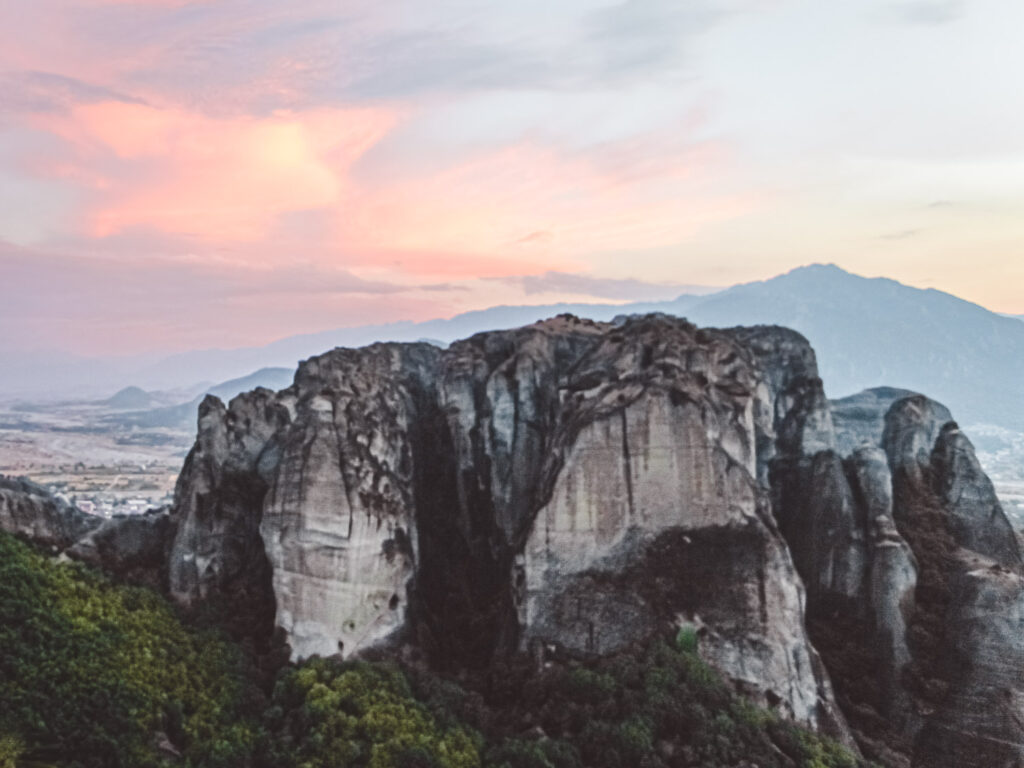
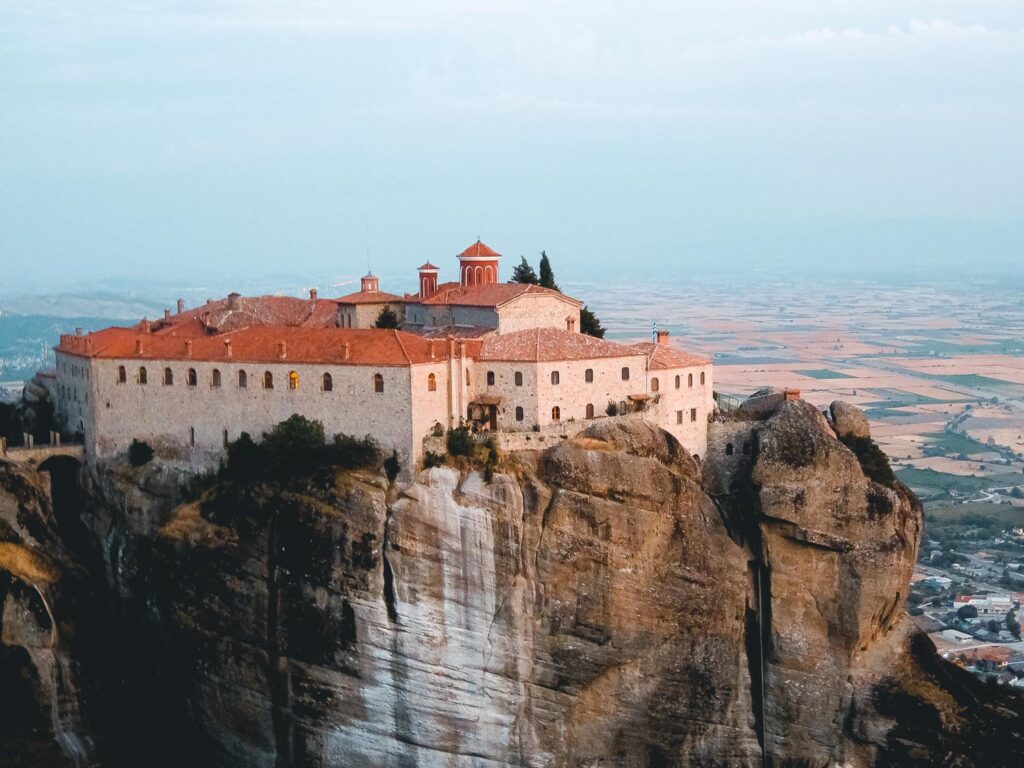
The only monastery we didn’t spend much time seeing was the Monastery of the Holy Trinity. This monastery was featured in the James Bond movie, For Your Eyes Only and when viewed from a specific point one can see the dramatic drops of the cliff on which it is built. Perhaps this is our reason to come back to Meteora again.
We ended our day with a quiet dinner back at the hotel under a starlit sky.
DAY 3: METEORA
After a delicious breakfast on the patio, we were ready for the hiking tour of Meteora. The tour started right next to our hotel at the base of the Doupiani Rock. We joined our guides from Visit Meteora and a small group of people for an upward climb towards the rocks. This is a 3.3 miles gradual hike that loops in and around the rocky outcrops.
As we walked through this “rock forest” our guide pointed out caves in the sandstone cliffs which were once homes to early monk settlers. He also explained the geology of these rocks, pointing out the layers of stone, sand, and mud deposits, which meant that these rocks were once below the water. Millions of years of erosion by wind and water had ultimately led to the creation of these dramatic rock pillars. We continued our hike North towards the hidden Monastery of Ypapanti.

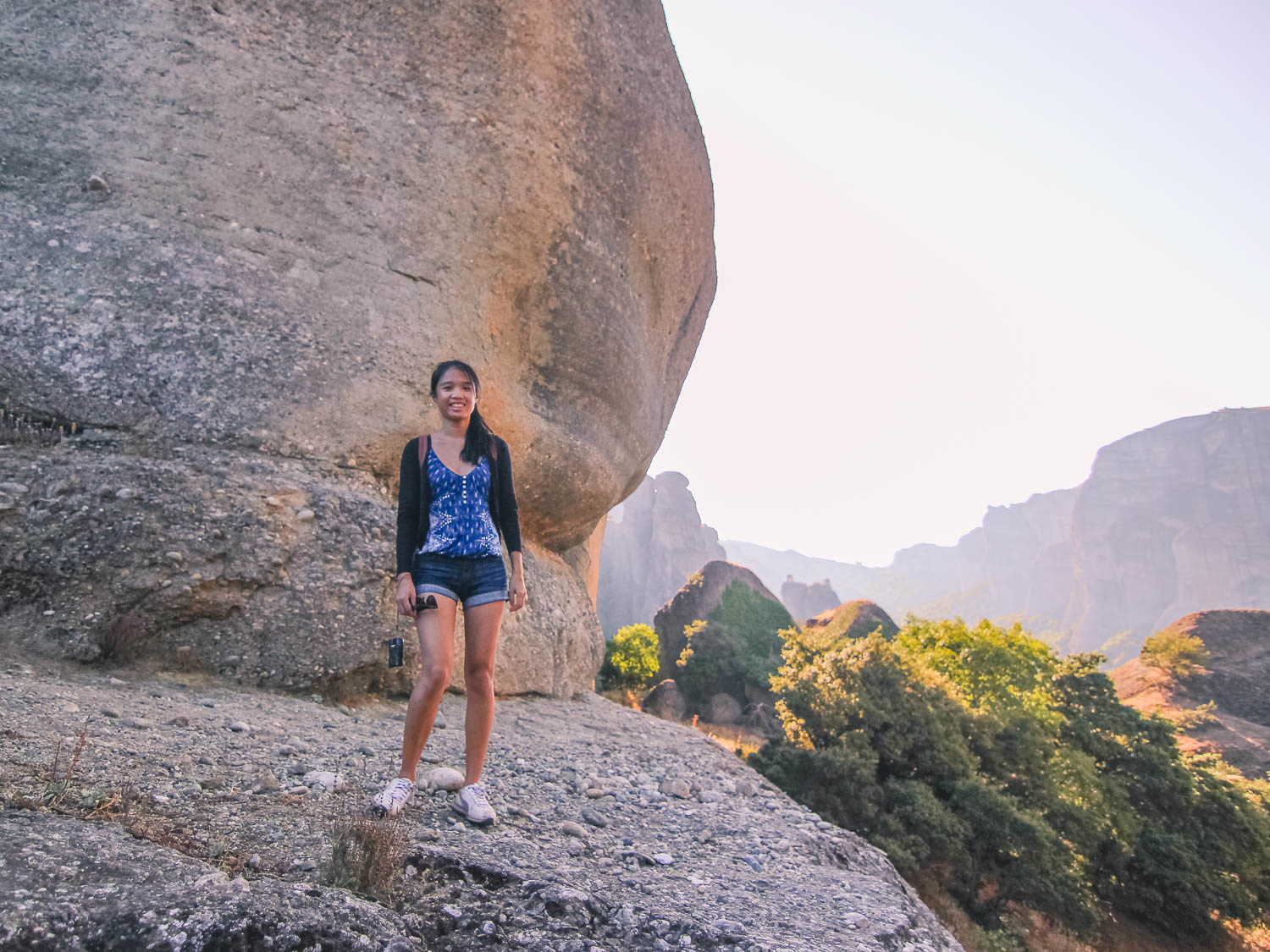
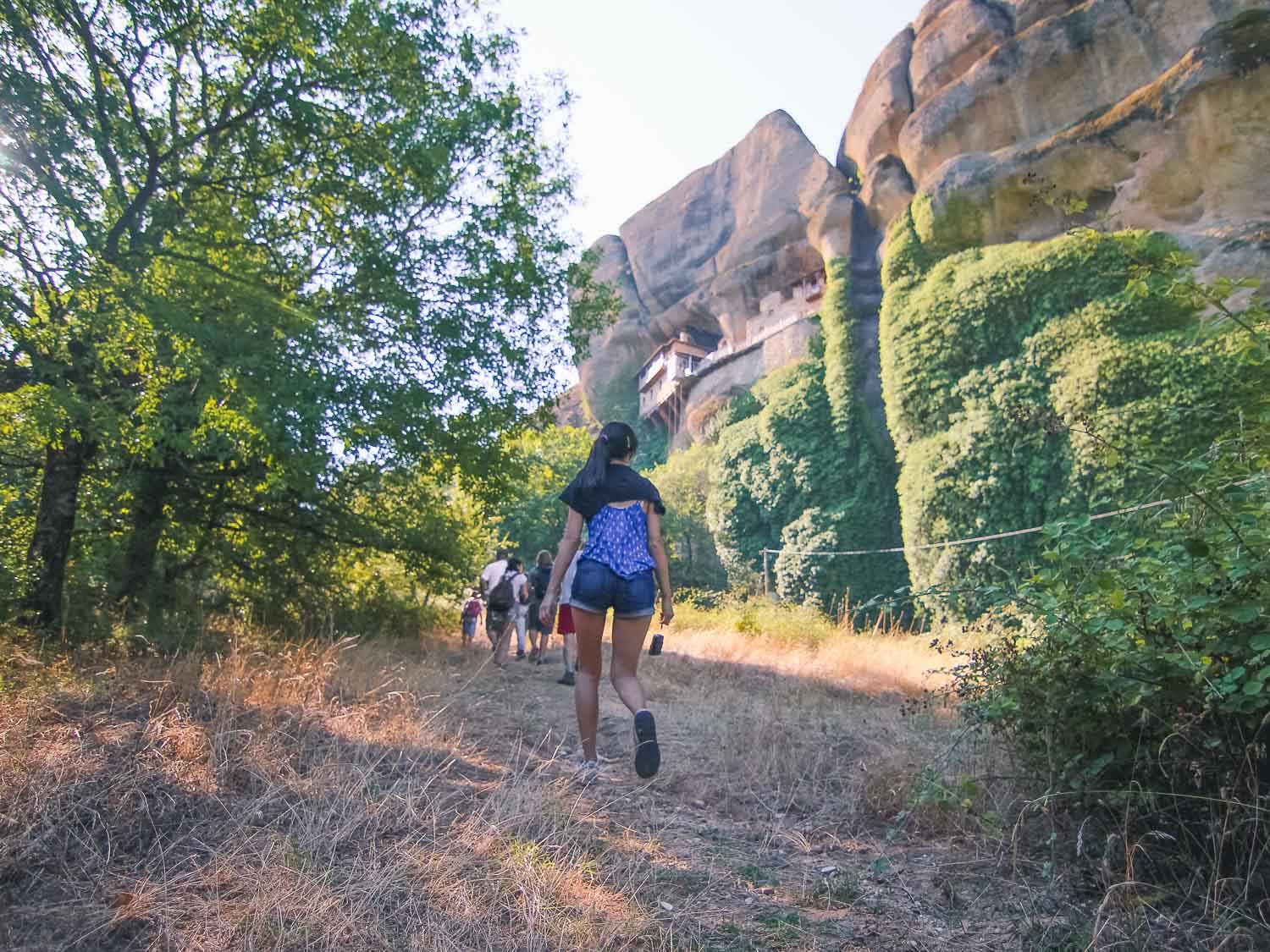
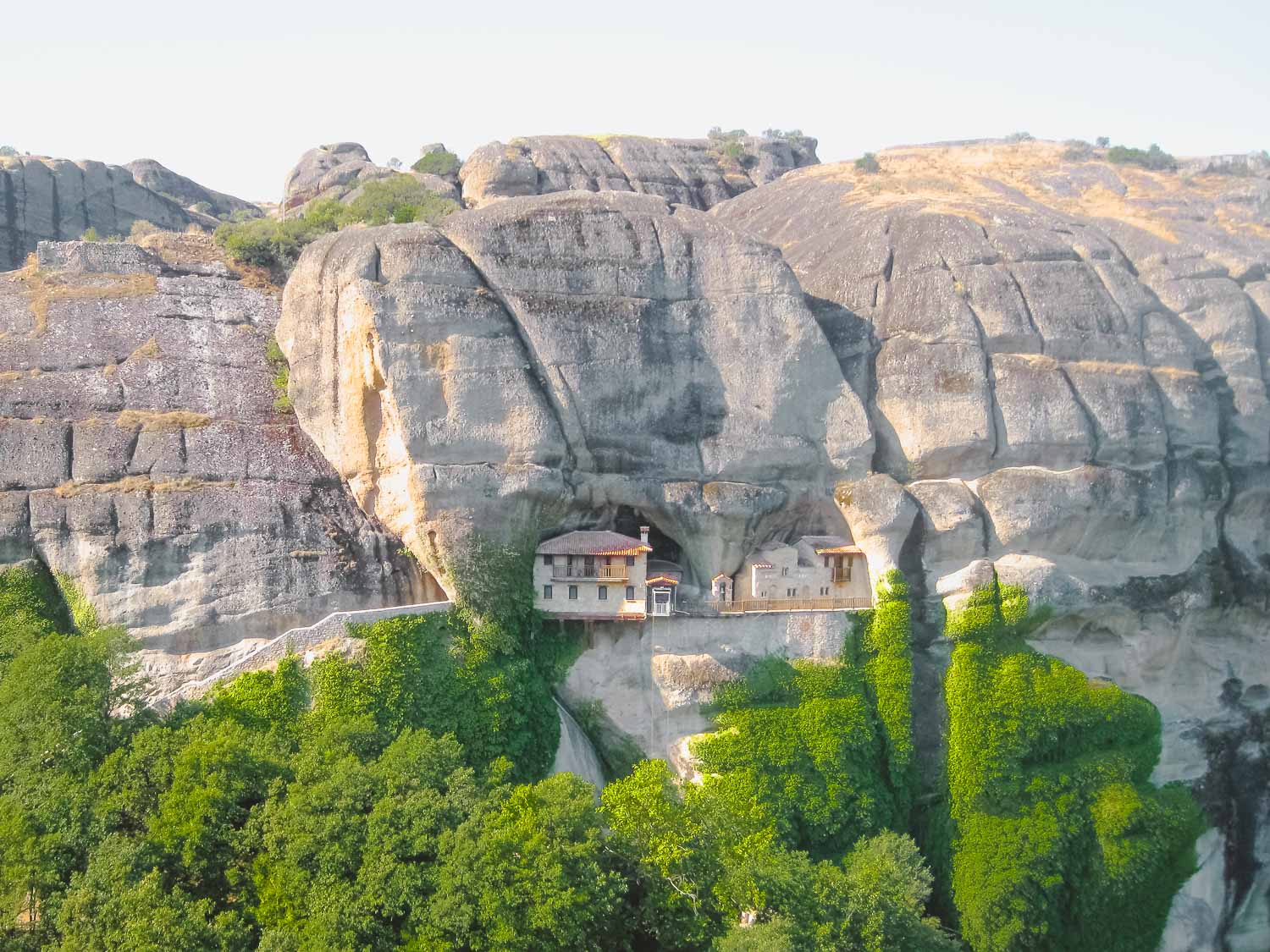
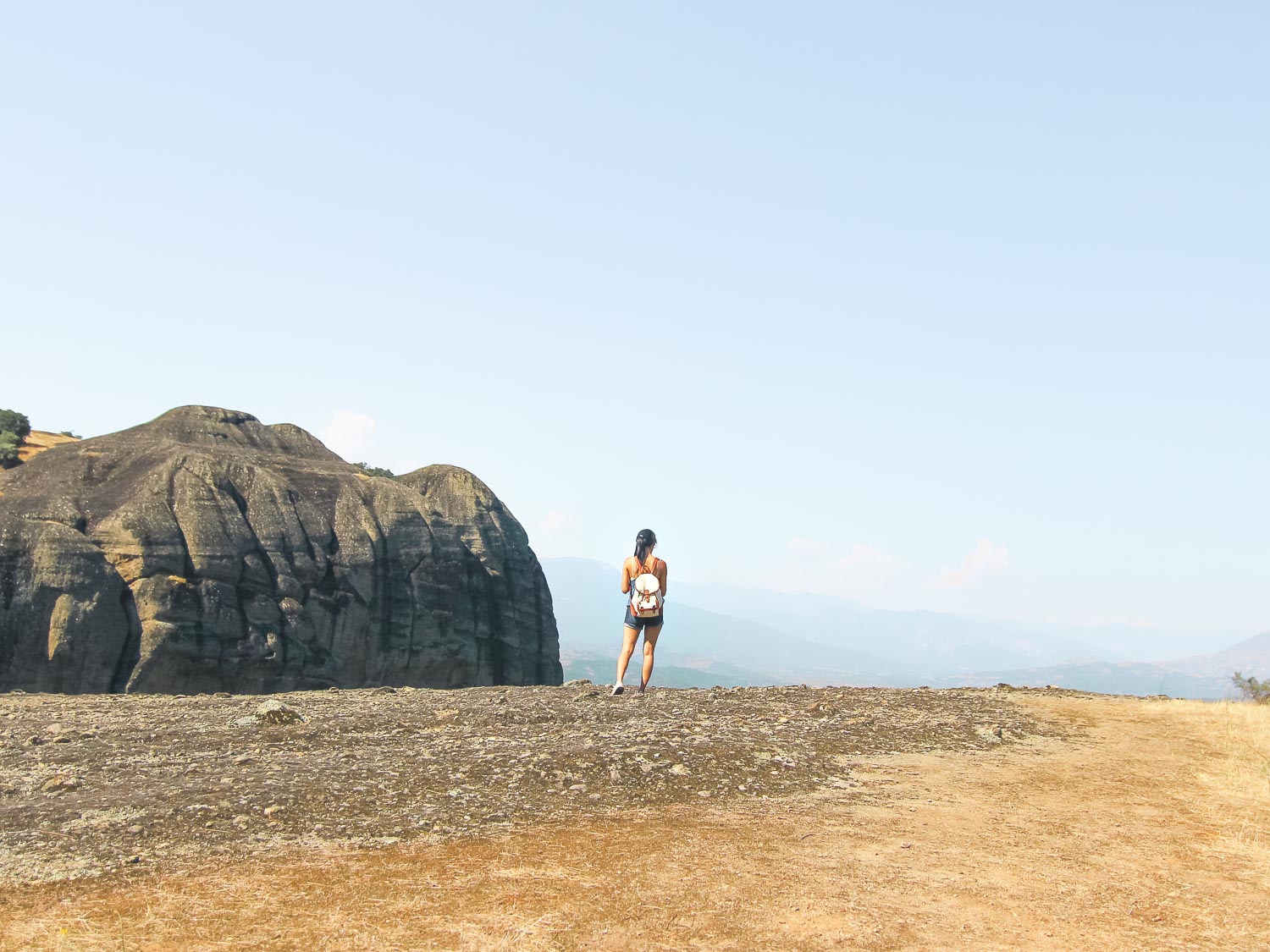
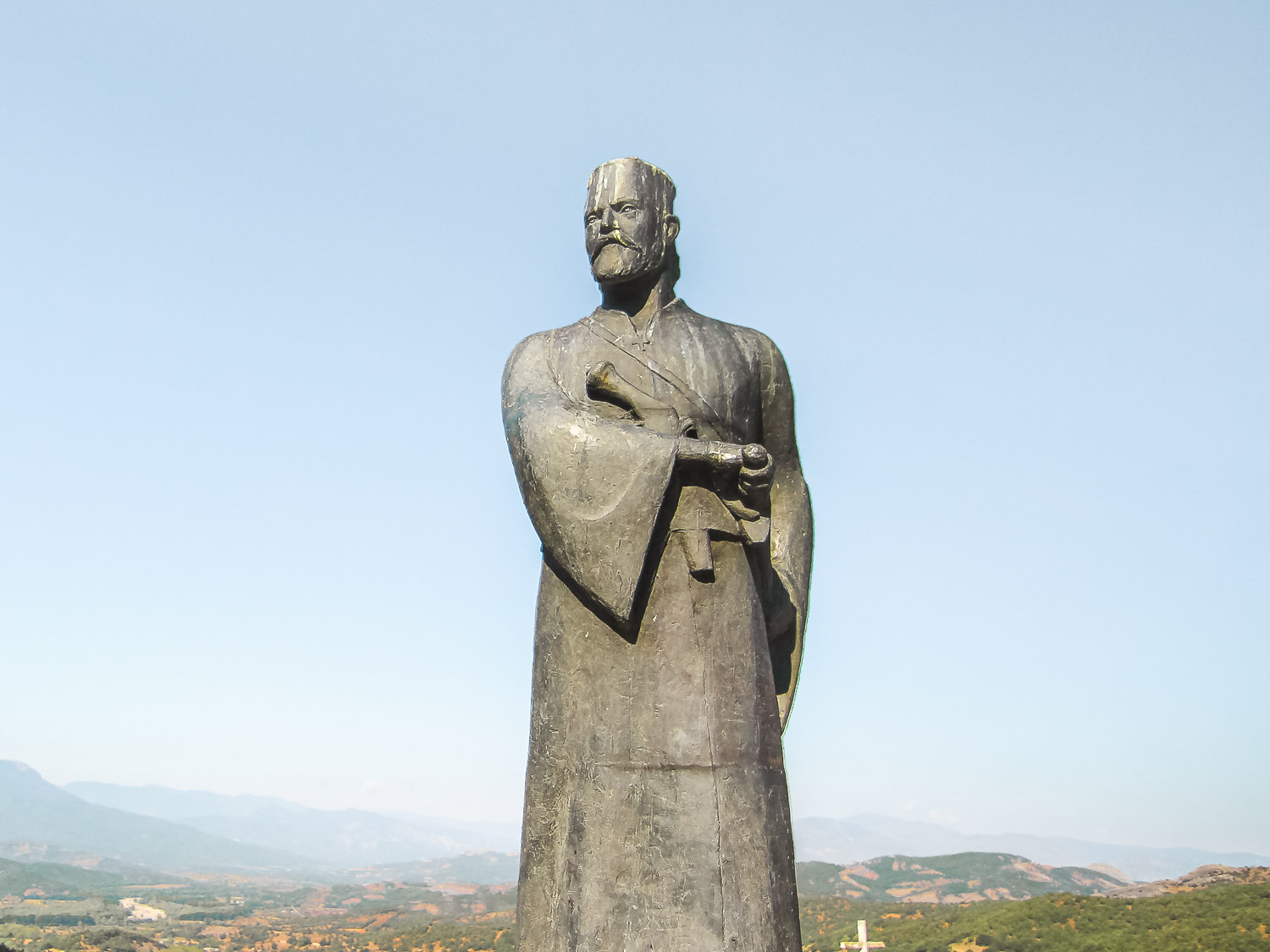
Unlike other monasteries, The Monastery of Ypapanti is built in a large rock cavity and looks glued to the rock face. This is one of the oldest monasteries and while tourists are allowed inside, we continued onward. We hiked until we reached a large open area where we had a clear view of the monastery. From here we could truly appreciate the ingenuity of the monks in how they utilized the rock opening. At the top there is also a statue of Thymios Vlahavas, a local hero who led an uprising against the Ottoman governor Ali Pasha.
We took a short break in the shade while our guide told us more about the history of Meteora. He said that Meteora had been inhabited since the early humans took shelter in the rocky caves. Later, hermit monks who sought a life of solitude lived in the rock cavities high above the ground. In the 14th century, a group of monks fleeing the attack of Turkish raiders in the North, took shelter in these inaccessible rock pillars and built the monasteries that we see today. During WWII, these monasteries were attacked and pillaged and slowly fell into disuse. Our guide said that once there were 24 monasteries, but now only 6 of them still remain. It is hard to imagine what that would have looked like, but we were glad to be witnessing the marvels of the ones that survived.
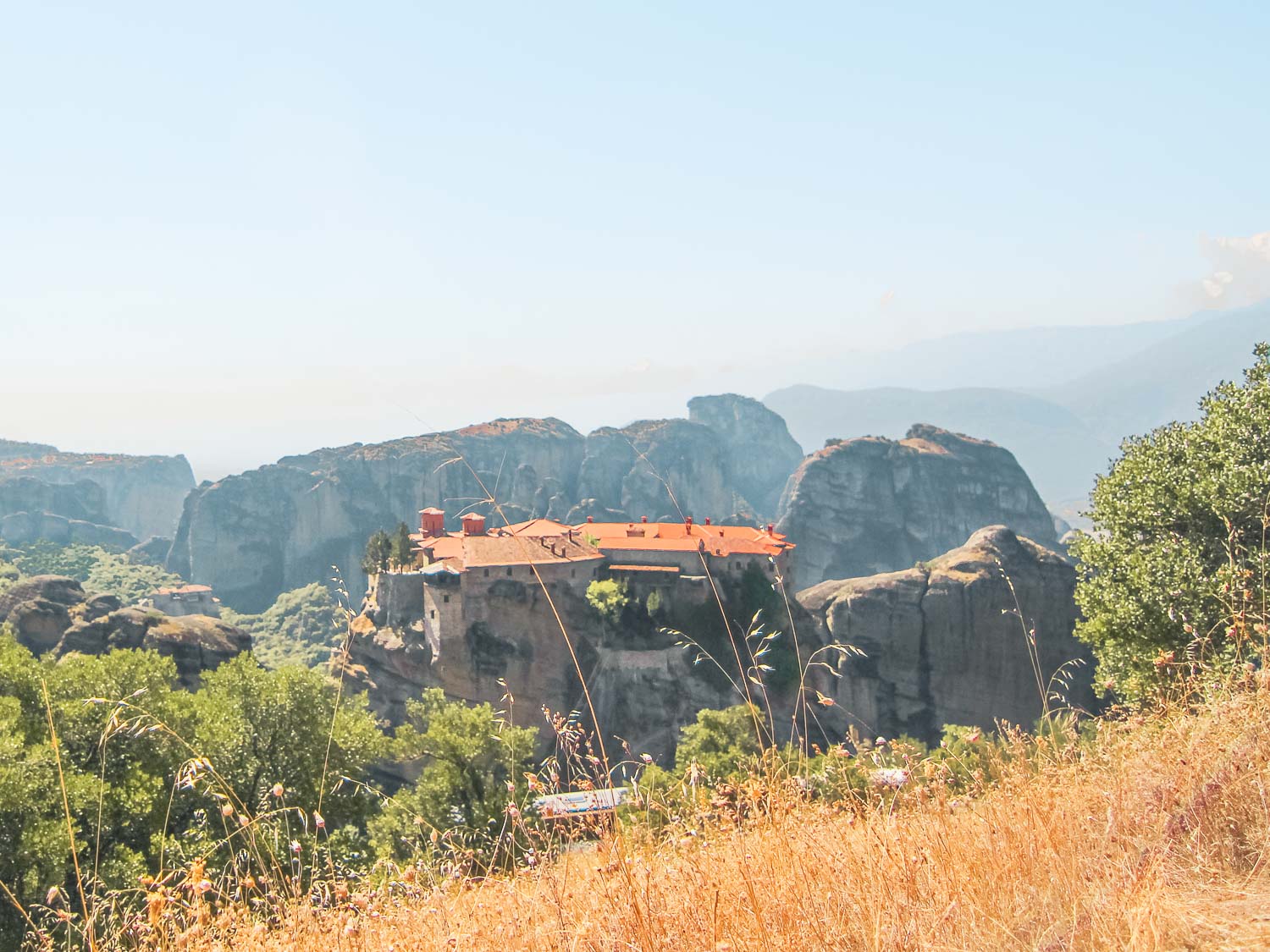

From here we started a slow gradual hike to the top of the hill. On the other side, we found ourselves standing right above the Monasteries of Varlaam and Great Meteoron.
We descended towards the Monastery of Great Meteoron and then took the stairs up to the monastery. Aptly named “Megalo Meteora”, climbing 146 stairs to this “great place suspended in air” quite literally took our breath away. The ascent ends in a shaded courtyard which was a welcome relief from the scorching sun. We had free time to explore the monastery and went from room to room at our own pace. We saw the beautiful frescos in the Katholikon, the wood carved crosses and religious manuscripts in the museum, and the old skulls of monks preserved in the ossuary. We also thoroughly explored the beautiful outdoor courtyard and admired the panoramic views of the neighboring towers.
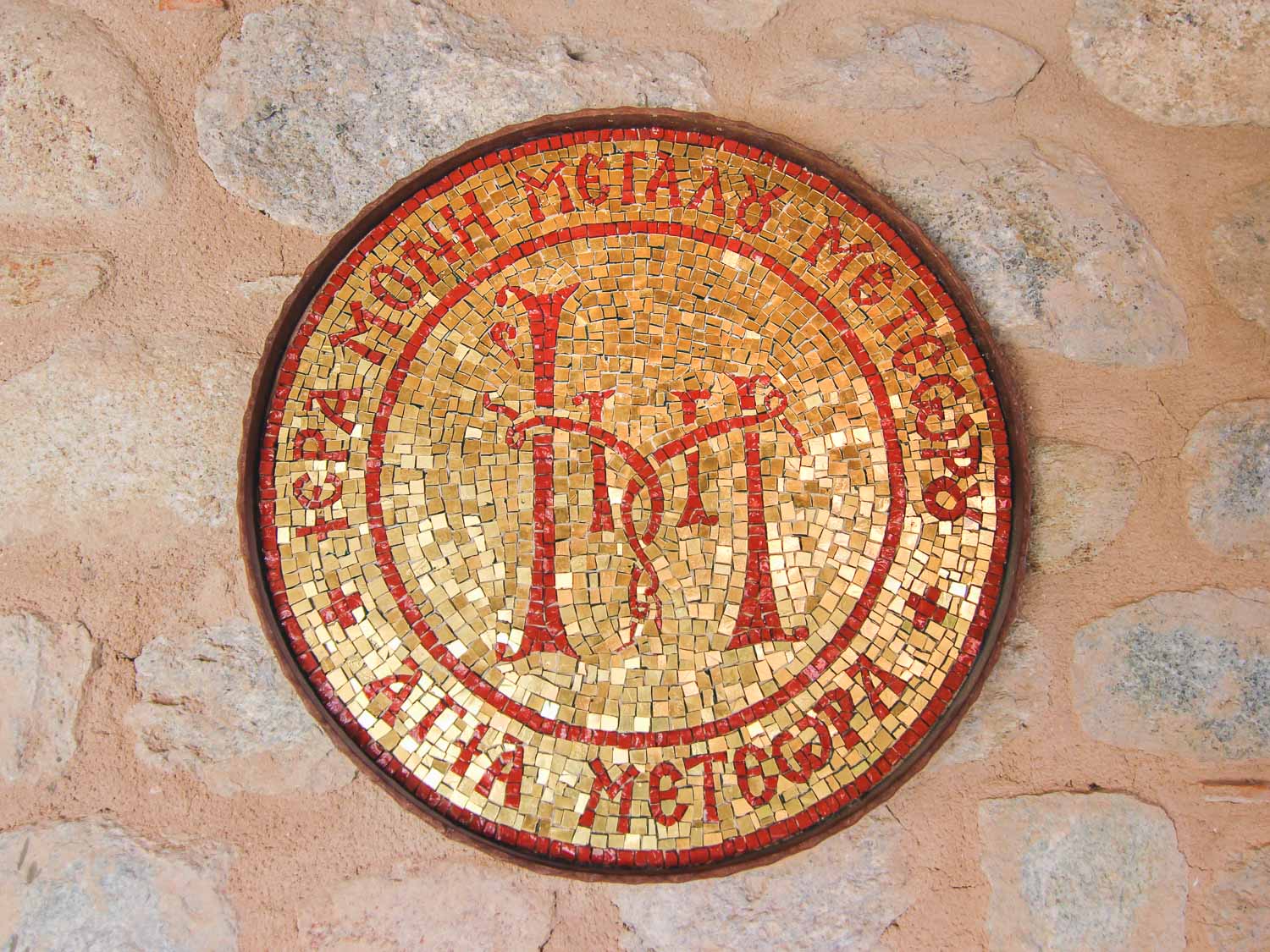
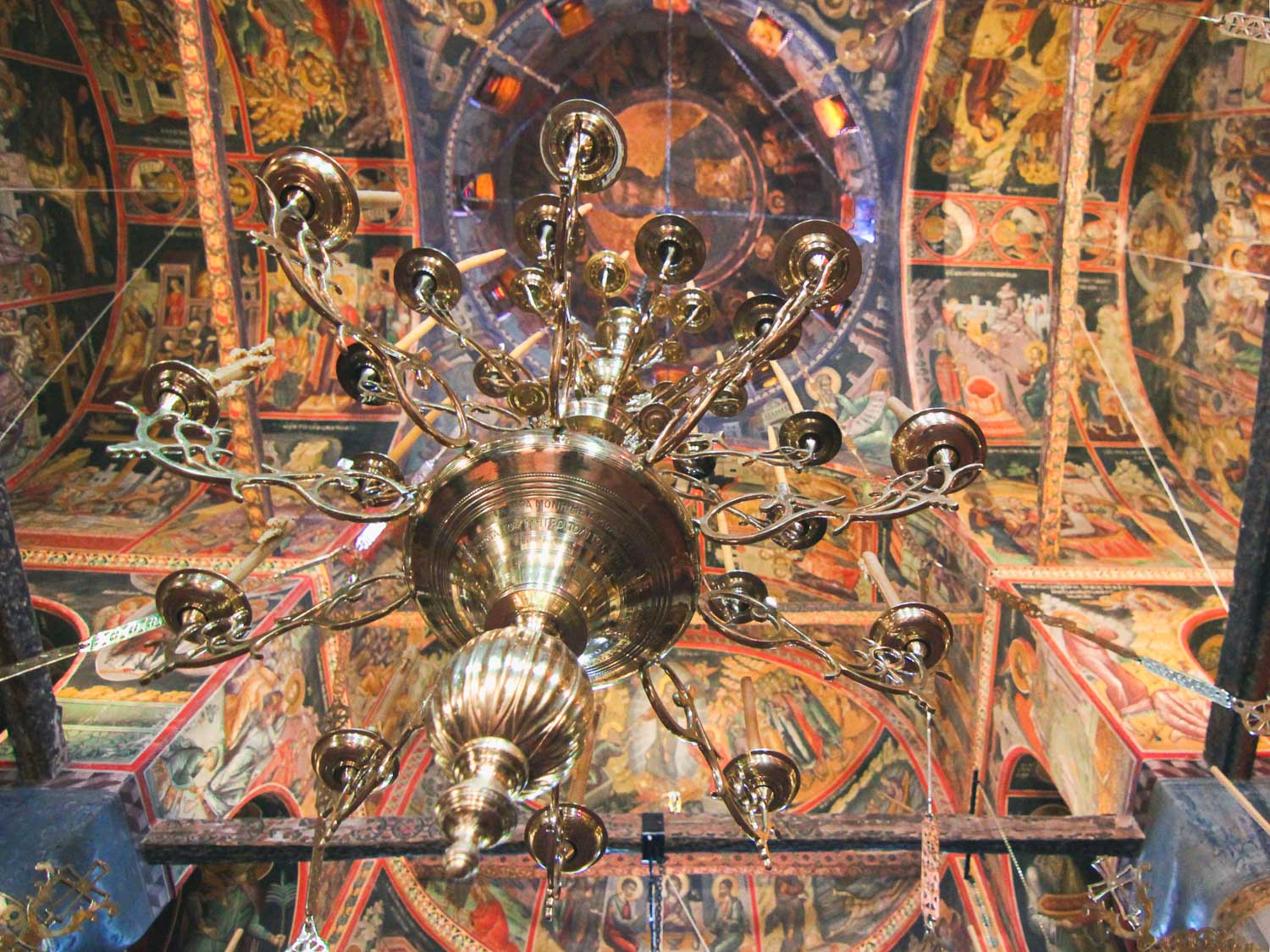
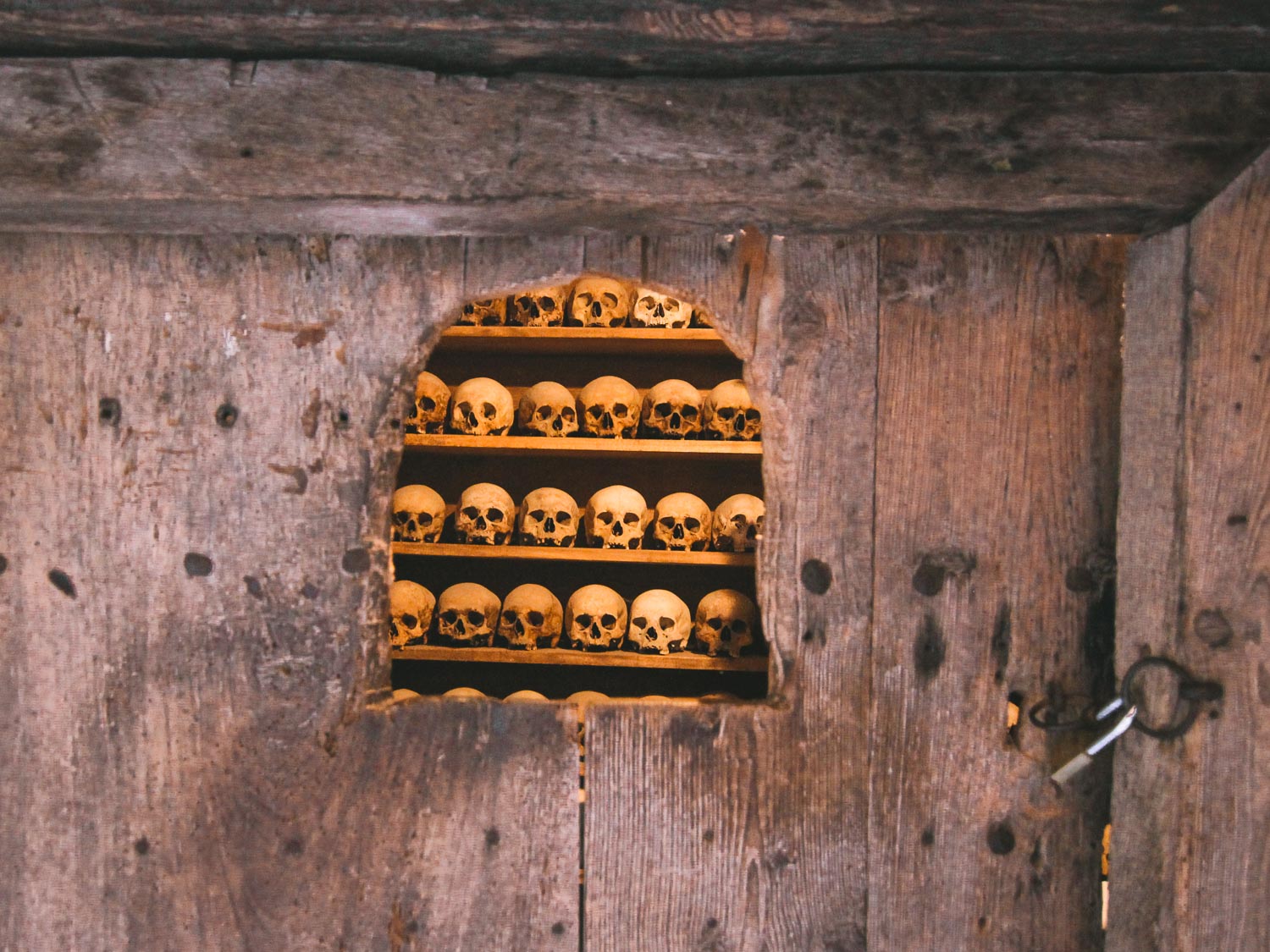
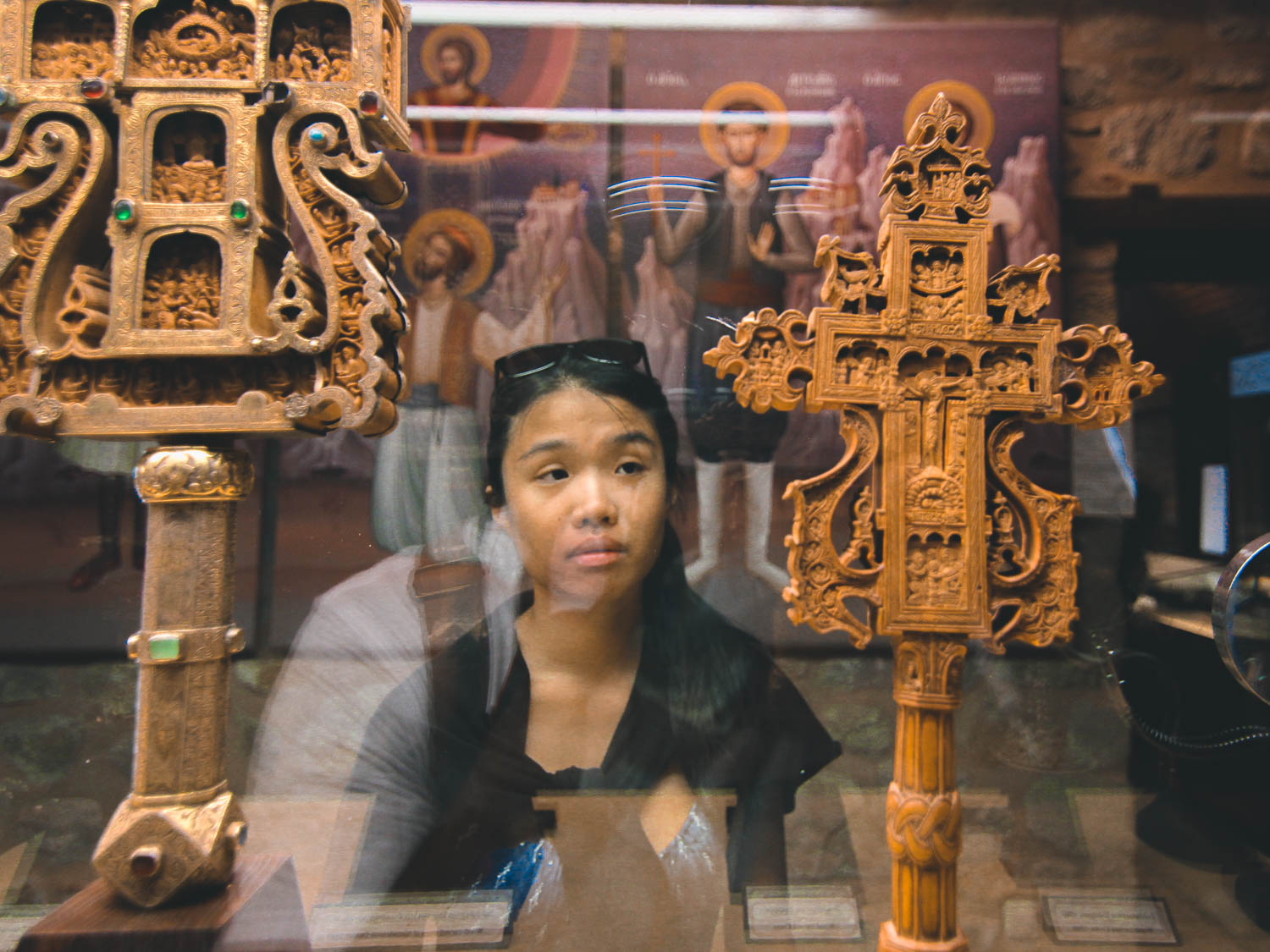
We met our guide again after descending the stairs and then continued downhill through an ancient trail used by the monks. From the trail we could see the cantilevered rooms of the Monastery of Varlaam hanging on the cliff above us. After 40mins of hiking through the forest we were back at the hotel. We checked out and asked our guide to drop us in Kalambaka for our train.
With some time on our hands, we walked around looking for a sim-card. This was our third day in Greece and we still didn’t have internet or local calling. Unfortunately all the stores were closed for siesta, a custom neither of us had experienced before. Luckily we found an open restaurant and grabbed a late lunch at Archontariki Taberna before our 5:30 PM train back to Athens.
It was late by the time our train arrived in Athens. From the station we took a taxi to Divani Palace, our stay for the next few days. Divani Palace is right in Makrygianni, next to the Acropolis. This neighborhood was bustling with tourists, a stark contrast to where we had previously stayed in Athens. We walked over to the Makrygianni street which has a row of restaurants and bars that stay open late into the night. It was midnight by the time we got there and the restaurants were still serving food. After a delicious meal and a couple of beers at Old School, we called it a night.
According to the ancient Greeks, Delphi was the center of the world. It was also the home to the great Oracle, known to have prophetic powers. Delphi gets its name from Delphyne, the dragon who lived there and was slayed by Apollo himself. Today it is a UNESCO world heritage site.
DAY 4: DELPHI
Planning our trip to Delphi was difficult due to the lack of online information about buses and travel times. We contemplated booking a guided day trip, but ultimately decided against it because we didn’t want to be rushed or be overwhelmed with a constant stream of historical information. Instead we read up on the Wiki page and followed the advice on TripAdvisor about how to travel to Delphi. Since we had already bought the tickets and investigated the schedule on the first day, today was much easier. We knew exactly when we needed to be at the station.
Our bus left KTEL Terminal B at 7:30 AM and we arrived around 10 AM. As soon as we got off at the Delphi bus stand, it started to rain heavily. We had no ponchos or umbrellas and no internet connection to check how long this rain was going to last. So after waiting for a few minutes we dashed into town and bought a couple of umbrellas. Lucky for us the rain only lasted 5 more minutes, and soon the sun came out through the clouds.
The bus had dropped us near the town but the archaeological site and the museum were a short ways up the road in the direction of Athens. We bought tickets to both the site and the museum and decided to see the archaeological site first. The entire site can be accessed by Via Sacra, a street that runs across the town.
The site consists of many stops along a pathway that winds up a hill. The site of Delphi was leveled by earthquakes and frequent landslides, so not much of it remains. Right at the entrance are a row of uneven columns, surrounded by stone slabs that were a part of multiple treasuries built along Via Sacra. At the first turn, we came across the most complete structure on the site, the Athenian treasury, built to commemorate their victory at the Battle of Marathon.
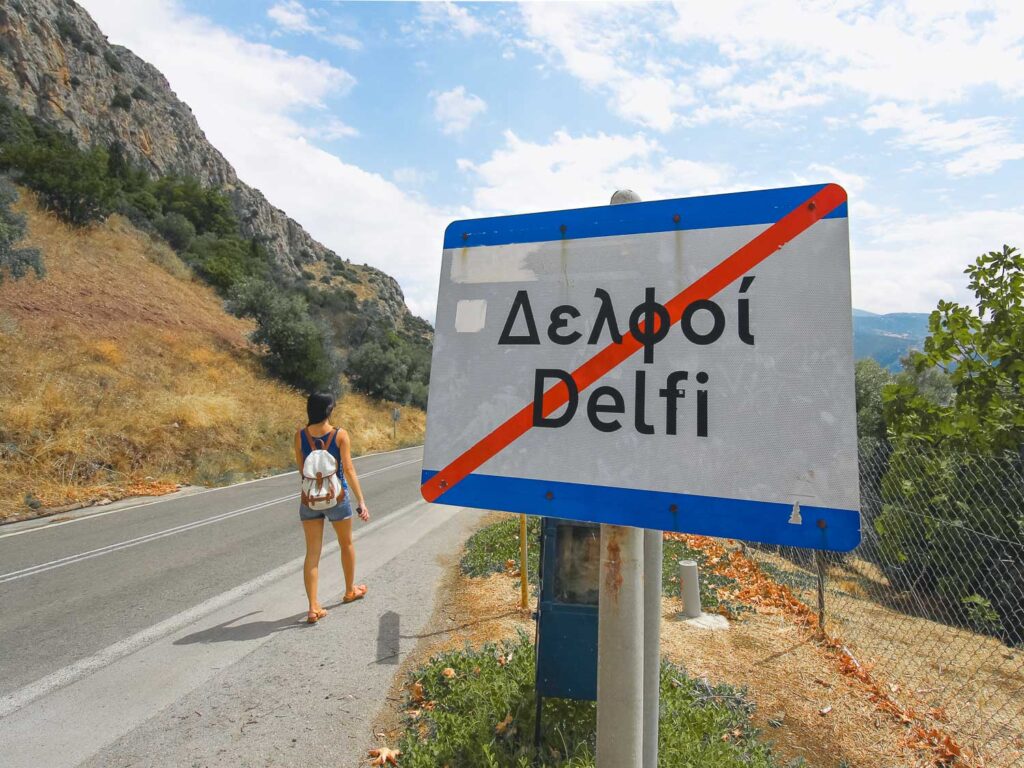
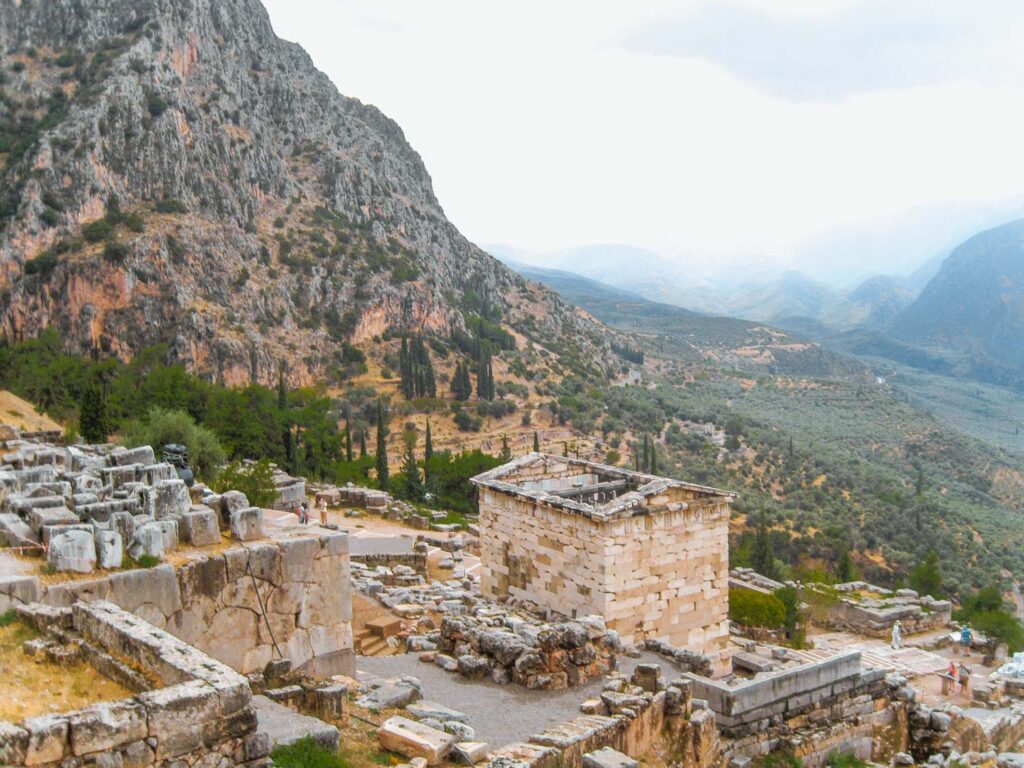
As we continued onward we saw more incomplete columns positioned on both sides of the street. But thanks to Kelsey’s minor in art history, this wasn’t all that boring. We routinely stopped to admire the column ornamentations and discussed the differences between the Doric, Ionic, and Corinthian columns.
Right in the middle of the site are the remains of the great temple of Apollo. This is where the kings and the public would come to seek advice from the Oracle. The Oracle of Delphi was among the most powerful women at the time and was consulted on important matters, such as a decision to go to war. In a state of trance from inhaling ethylene gases, the Oracle would murmur words that foretold the future. If the future turned out favorably, the kings would in turn build monuments or make huge donations to show their appreciation. The temple of Apollo was rebuilt multiple times throughout its history but today only a few Doric columns remain. Judging by the few surviving columns and the large floor plan, this temple must have been quite a spectacle.
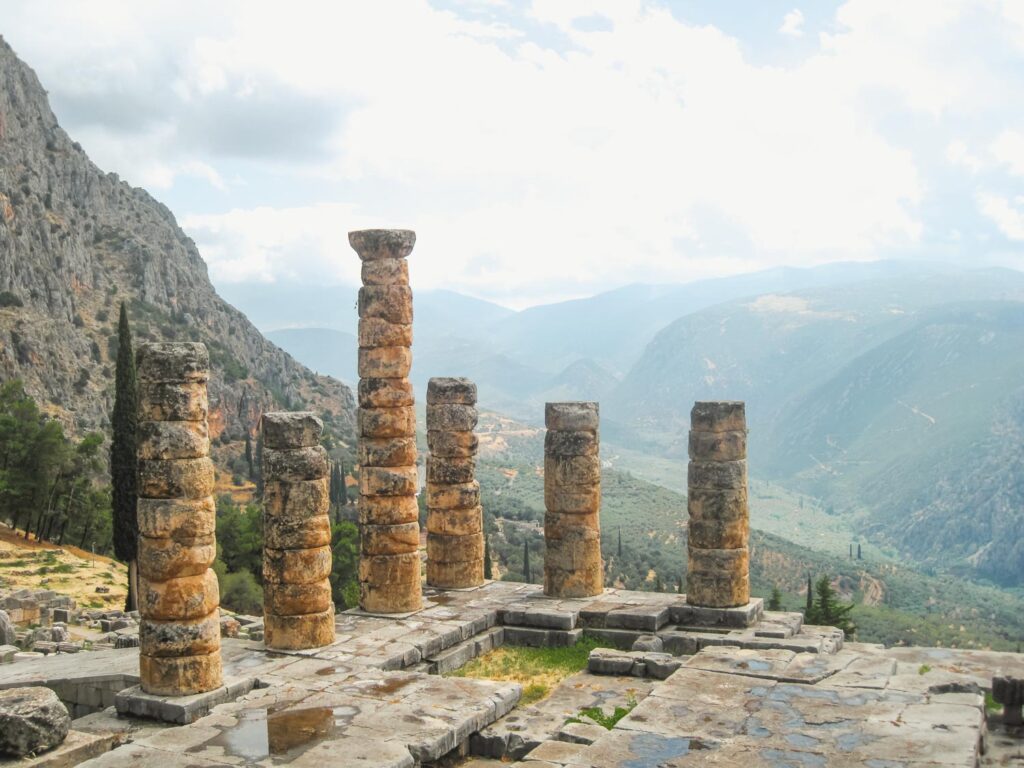
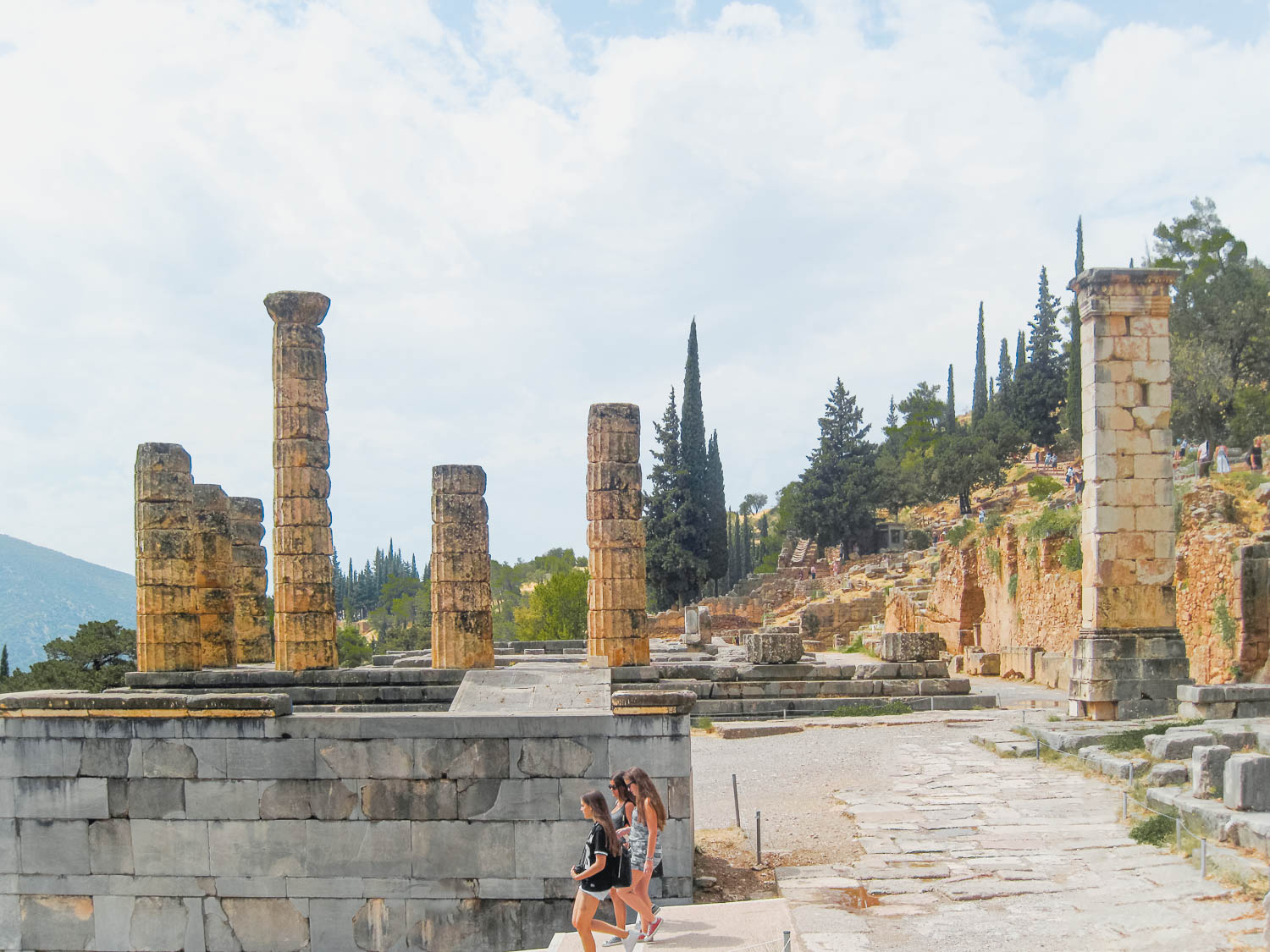
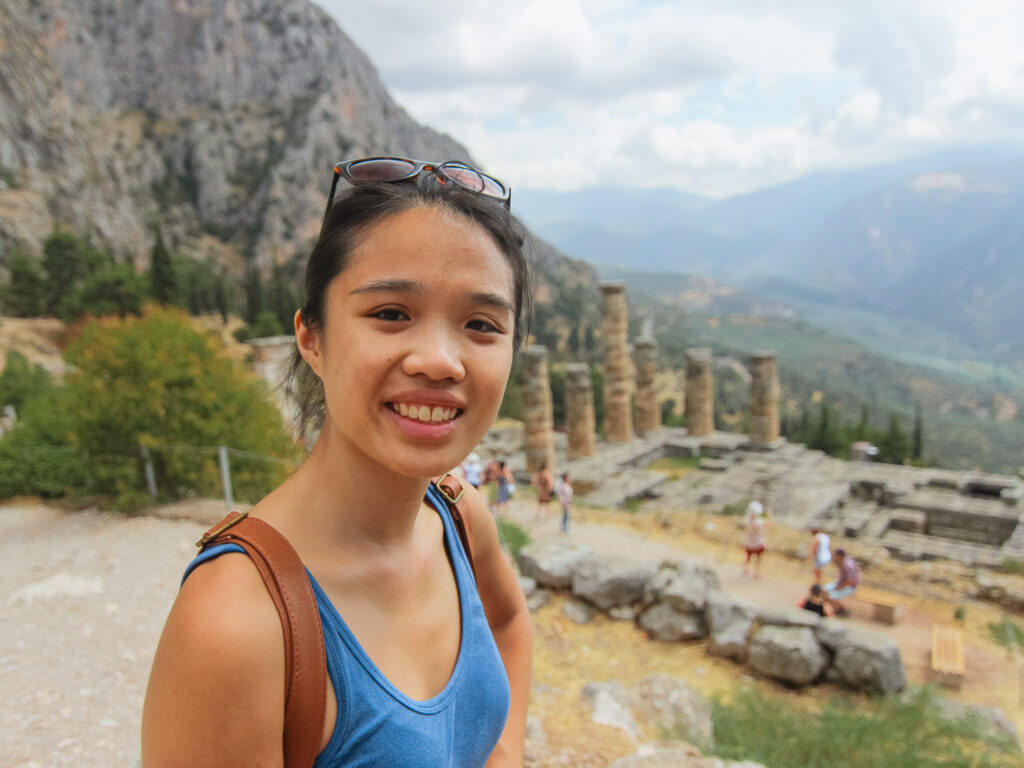
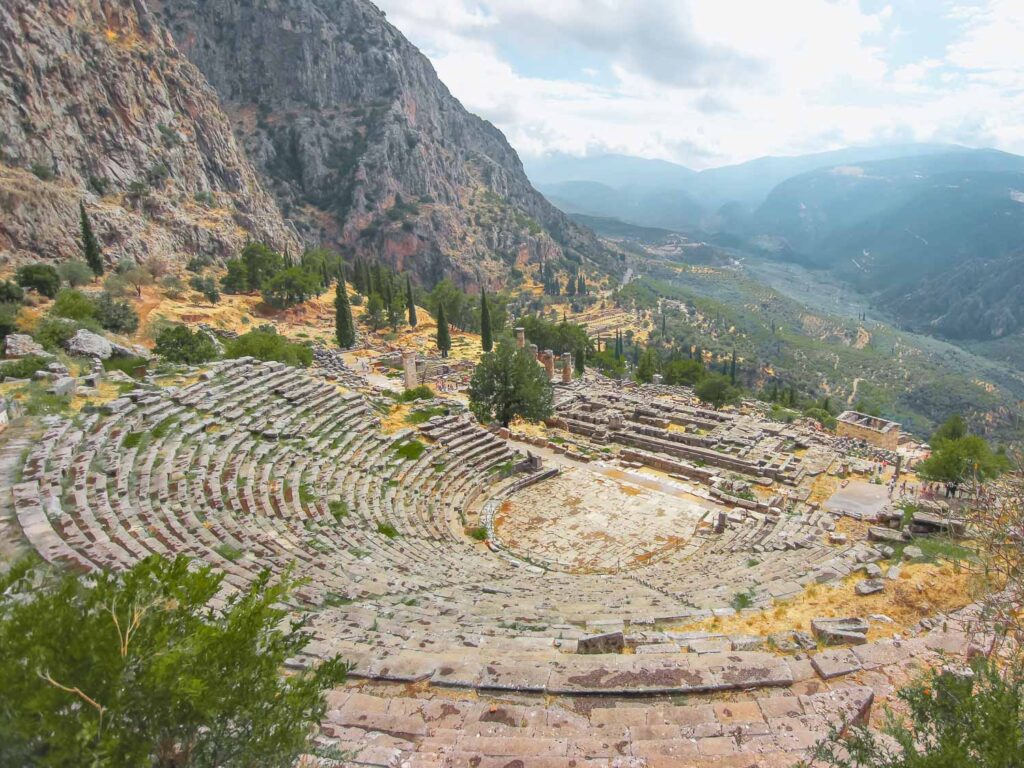
Up along Via Sacra is perhaps the most beautiful of the remaining structures – the theatre. The theatre is embedded in the hillside and rises up along the natural slope of the hill. It has a seating capacity of more than 5,000 people with the beautiful Mount Parnassus as the backdrop. Up until recently the theatre was used for theatrical performances but that stopped to preserve the structure from further damage. Further up from the theatre is a stadium and hippodrome which was once the site for Pythian games, similar to the games in Olympia. These games were held every 4 years in honor of the god Apollo killing the serpent-dragon and saw athletes competing from all over the kingdom.
All of these ruins can be easily accessed along the single winding path. However, down the road another part of this archaeological site hosts the Sanctuary of Athena Pronaia and a circular temple “tholos”.
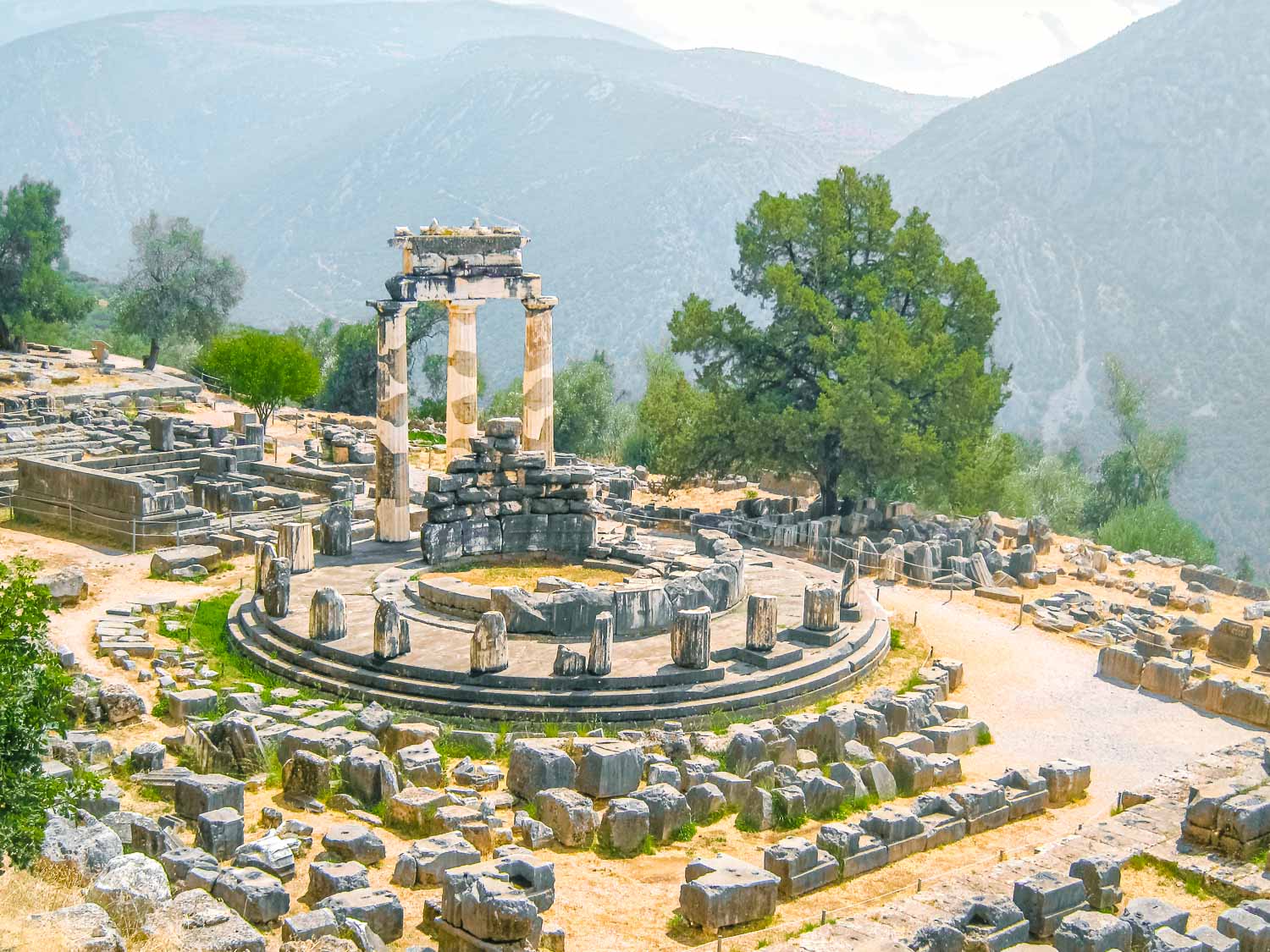
Chances are that this is the image that comes up when searching for Delphi. While not much remains, the three Doric columns supported by a frieze provides a hint for what this place could have looked like in its prime.
After 3 hours of touring the site, we returned to the museum. The museum holds an extensive collection of artifacts unearthed during excavations at the site. Among these artifacts is a religious stone from the Temple of Apollo named omphalos (meaning navel), as it was believed that Delphi was the center of the earth. After an hour of looking at these artifacts our energy started to fade.
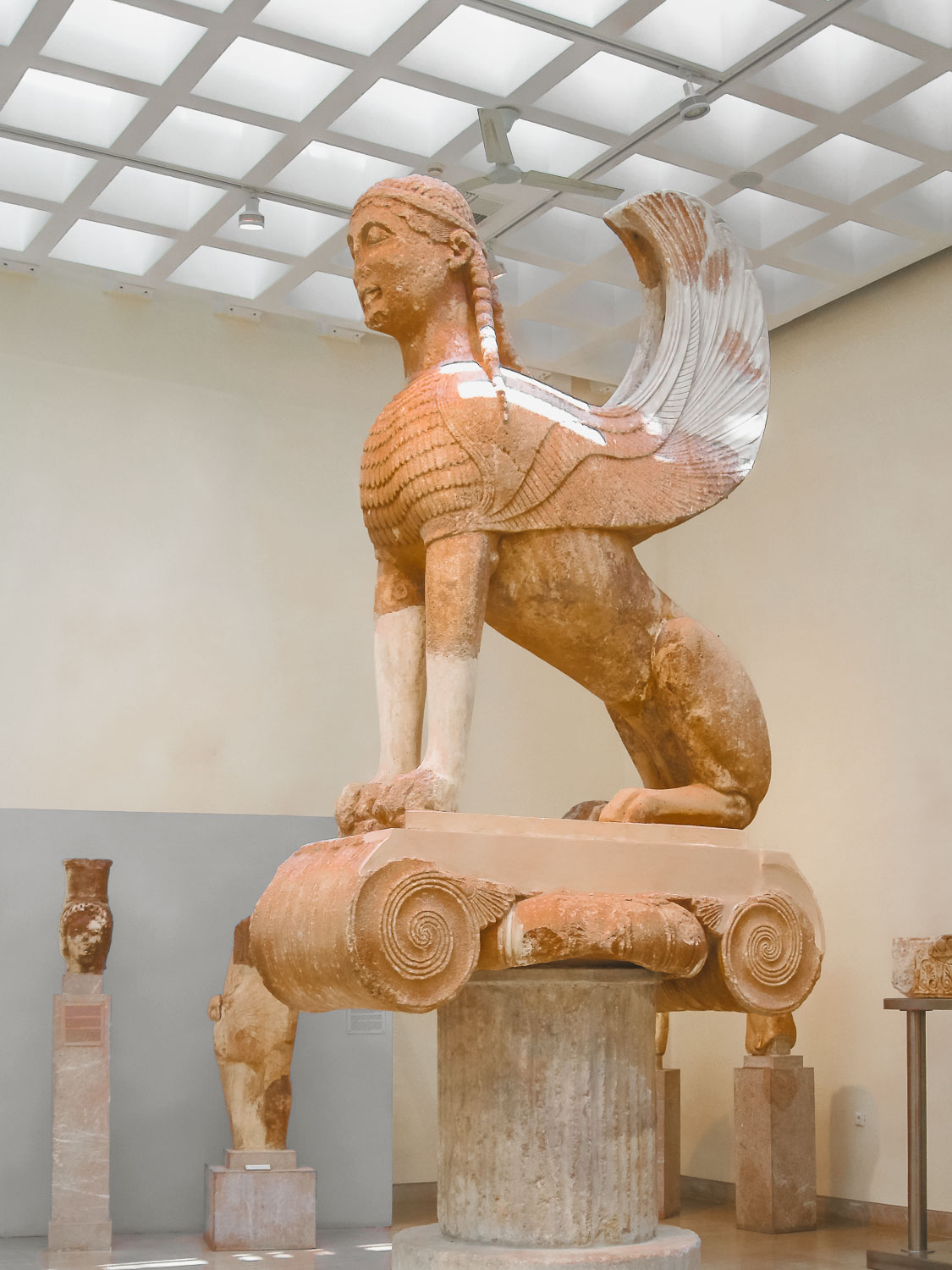
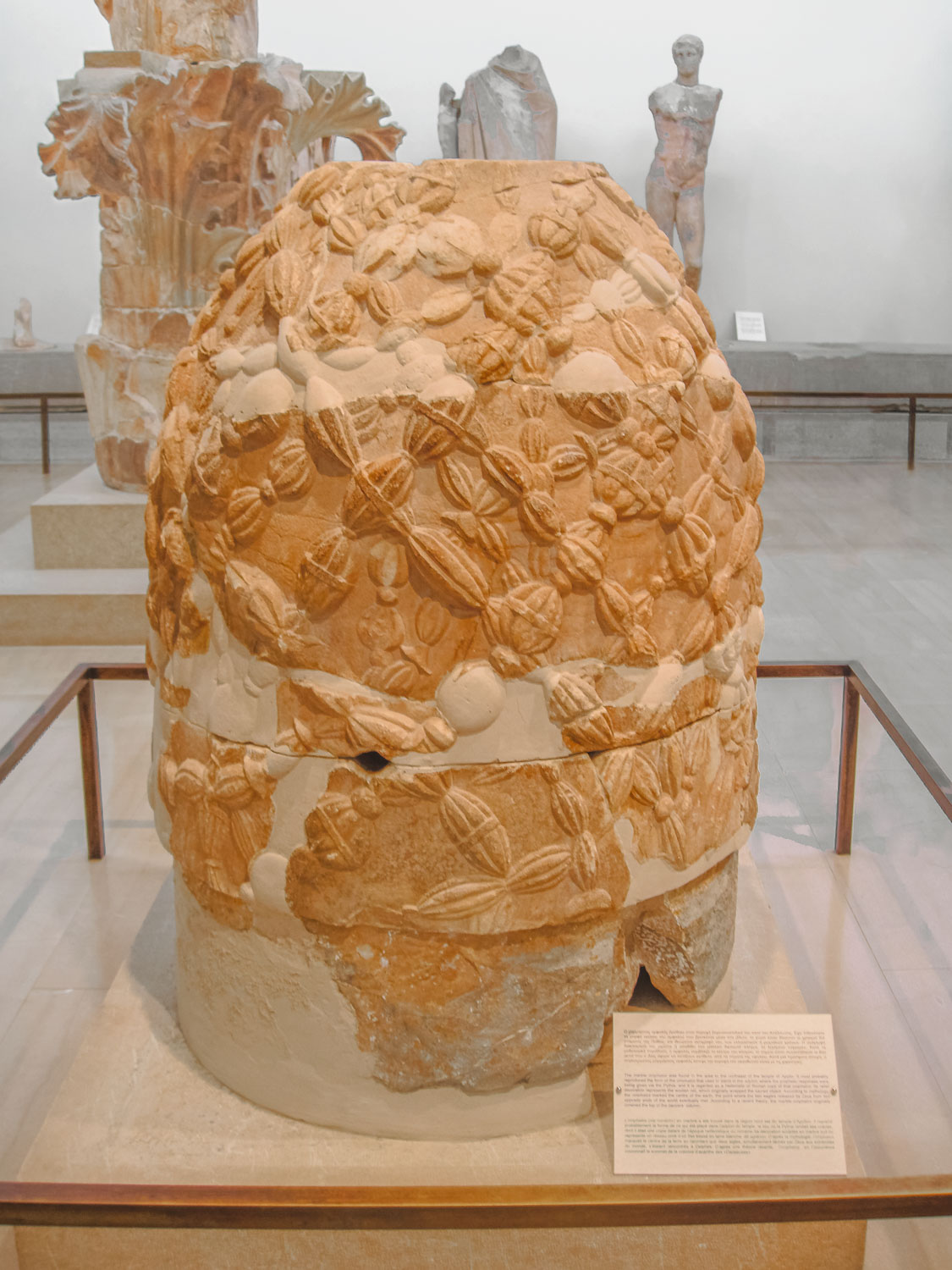
We walked back towards the town and ate at the very first restaurant Υδρία Δελφοί. The food and the beer tasted much better after a long hike in the sun. After lunch we walked around the town and then took the 5:30 PM bus back to Athens.
We arrived right next to Hadrian’s Arch. After taking a couple of photos of it and the nearby Temple of Zeus, we again tried our luck at finding a local sim-card. Finally we found a mobile store near our hotel and now for the first time we had the internet on the go. It seemed like such a luxury. We spent the rest of the evening wandering Plaka, a labyrinth of souvenir shops, jewelry stores, and outdoor restaurants. It certainly was the most happening neighborhood we’d seen. Tired from our long day, we ended the night after dinner and drinks at the Café Diogenes.
DAY 5: ATHENS
This was our first full day in Athens. Today we didn’t have any bus or train to catch so we woke up without an alarm. After getting breakfast at the Roua Cafe we started our hike towards the Acropolis. The Acropolis is a UNESCO world heritage site and is considered a symbol of democracy. After the win over the Persians in the battle of Eurymedon during 468 BC, the great democratic leader Pericles started a construction campaign that resulted in some of the most magnificent structures of the ancient world, some of which are still standing today.
By the time we got to the Acropolis ticket office, there was already a huge crowd and several tour groups queued up to get into the citadel. It was 10:30 AM and we instantly regretted our decision to wake up late. After we finally managed to get our tickets, we walked with the crowds towards the grand entrance, the Propylaea. On the way up we stopped to admire the restored Roman theatre – Odeon of Herodes Atticus. The theatre is still in use today and hosts concerts and other performances. Continuing up the stairs of the Propylaea, we passed a fully restored greek temple dedicated to Athena Nike, but we couldn’t get very close due to all the scaffolding on the entrance. While most of the entrance was still under restoration, we were still able to admire its monumental size by glimpsing the tall doric column on the other side.
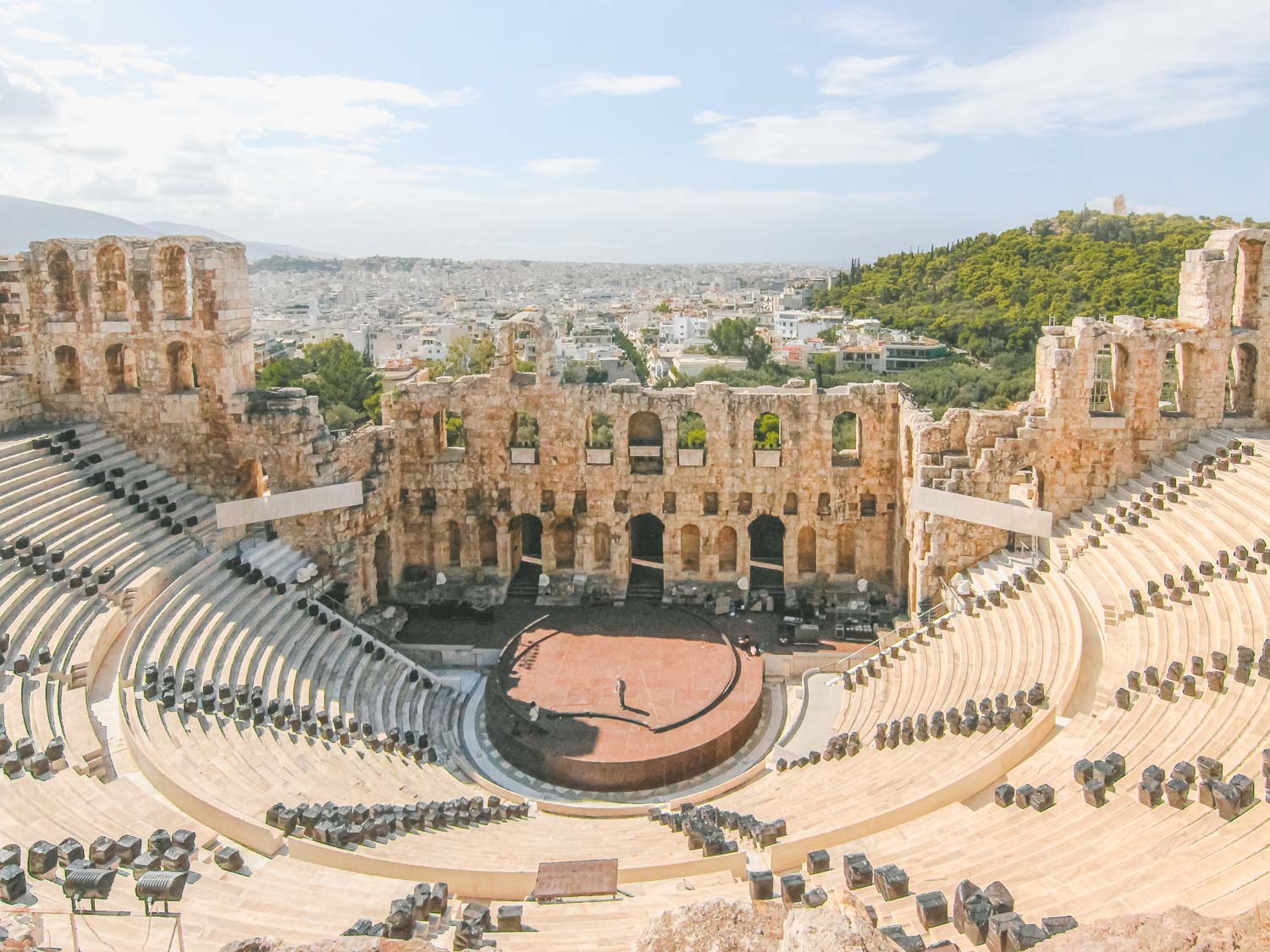
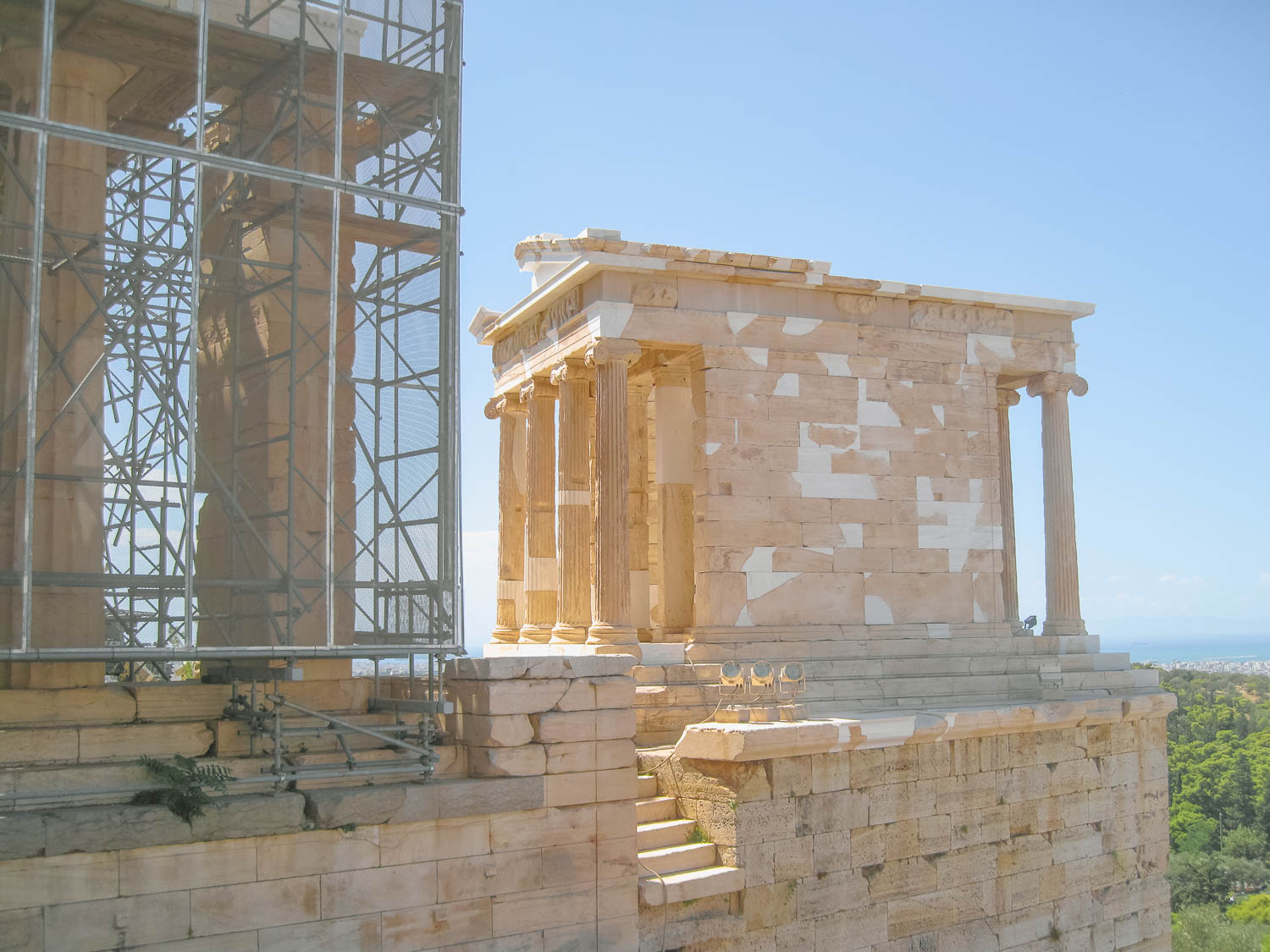
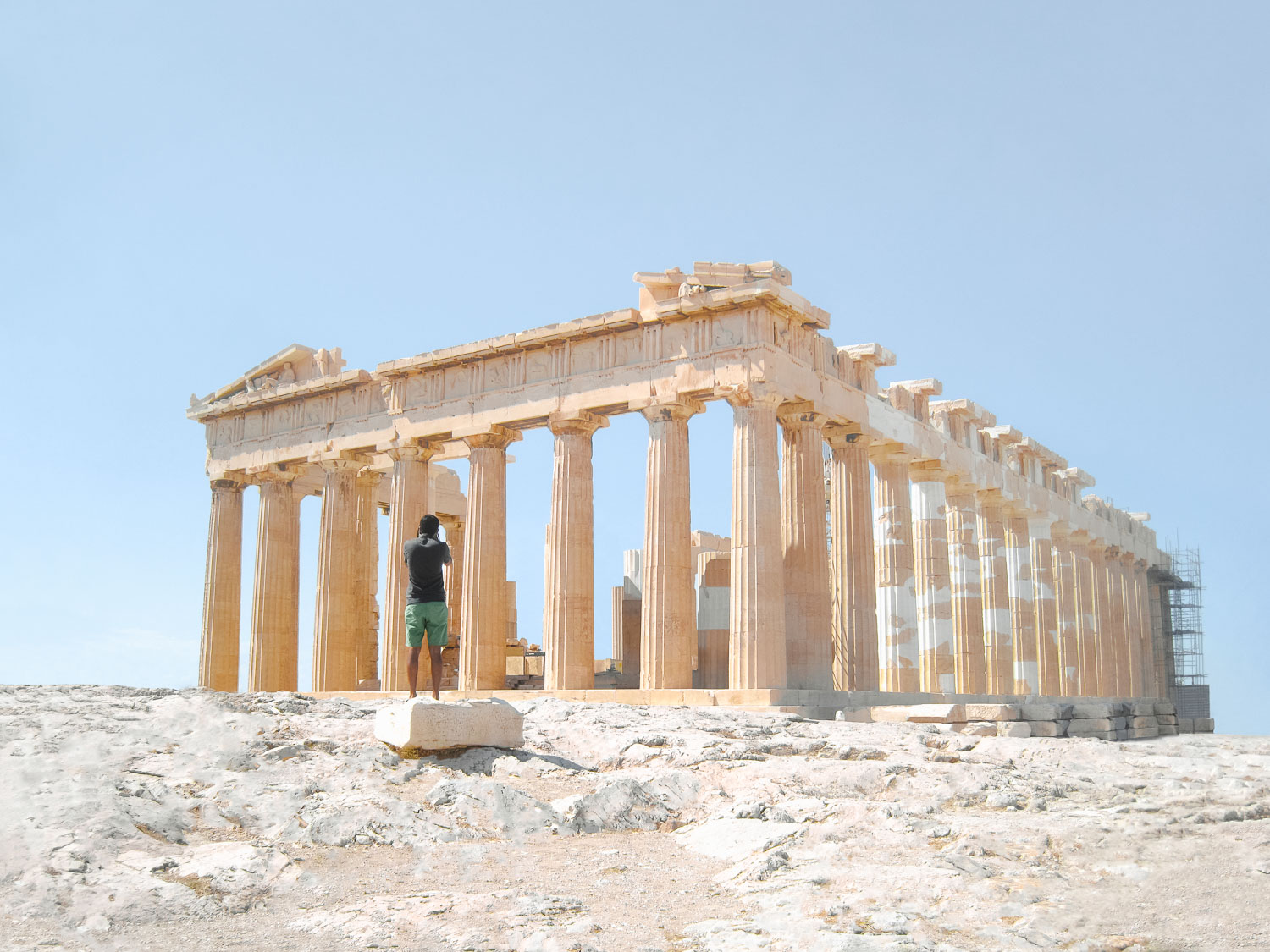
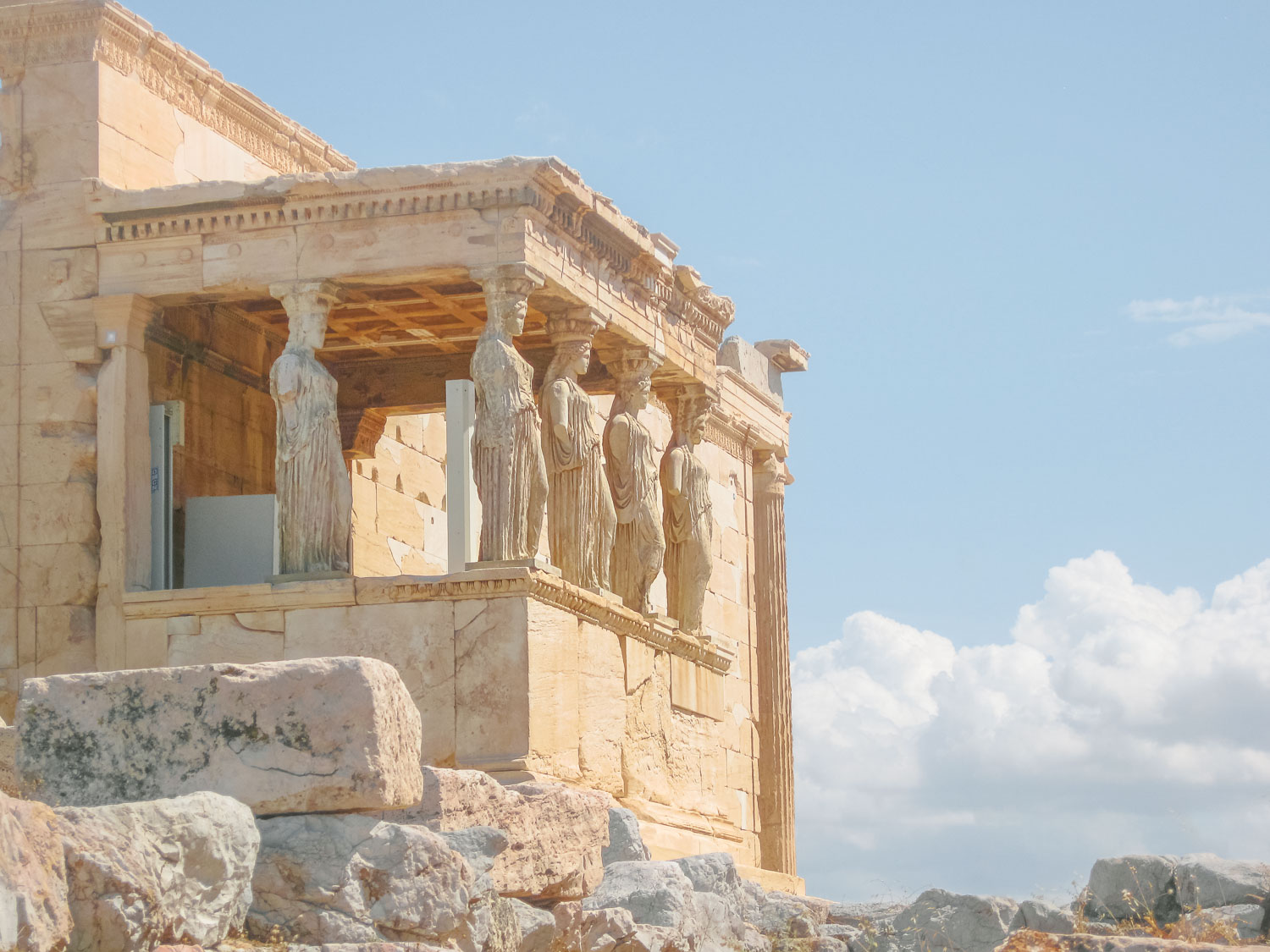
Right in front of the Propylaea is the crown jewel of the Acropolis – the Parthenon. This is what Kelsey had been dying to see. Originally dedicated to goddess Athena, this massive temple has served multiple purposes over the years, a treasury, church, mosque, and ammunition storage. It was built and destroyed several times in the past and today is one of the greatest restoration sites. Even with the ongoing work, we were mesmerized by the sheer size and beauty of this structure. The western side of the temple is more restored and one can admire the fluted, 3-story tall doric columns and partly reconstructed pediment that rests on top. We walked around the perimeter imagining what it would have been like to walk the halls and come face to face with a huge statue of goddess Athena. It certainly could be the 8th wonder of the ancient world.
The Acropolis also provides a panoramic view of the city and the partially restored Theatre of Dionysus, which is situated below the Acropolis hill. While there are several archaeological remains on the Acropolis site only a few structures have been restored, one of which is the Erechtheion – a Greek temple dedicated to both Athena and Poseidon. The most distinguishing feature of this temple is the “Porch of the Maidens”, where six draped female figures (caryatids) stand as columns. The original figures are now in the nearby Acropolis Museum, with the exception of one which was taken by Lord Elgin along with other Parthenon artifacts that became decorations in his Scottish mansion. These artifacts now reside in the British Museum.
From the citadel we walked down to the award winning Acropolis Museum, which houses the artifacts excavated from the Acropolis and the nearby sites. Designed to replace a prior smaller museum, the new Acropolis museum has been designed very thoughtfully through multiple rounds of competition. During construction Roman ruins were unearthed at its base and instead of building over them, this innovative building design manages to showcase the ruins through glass floors and special vantage points.
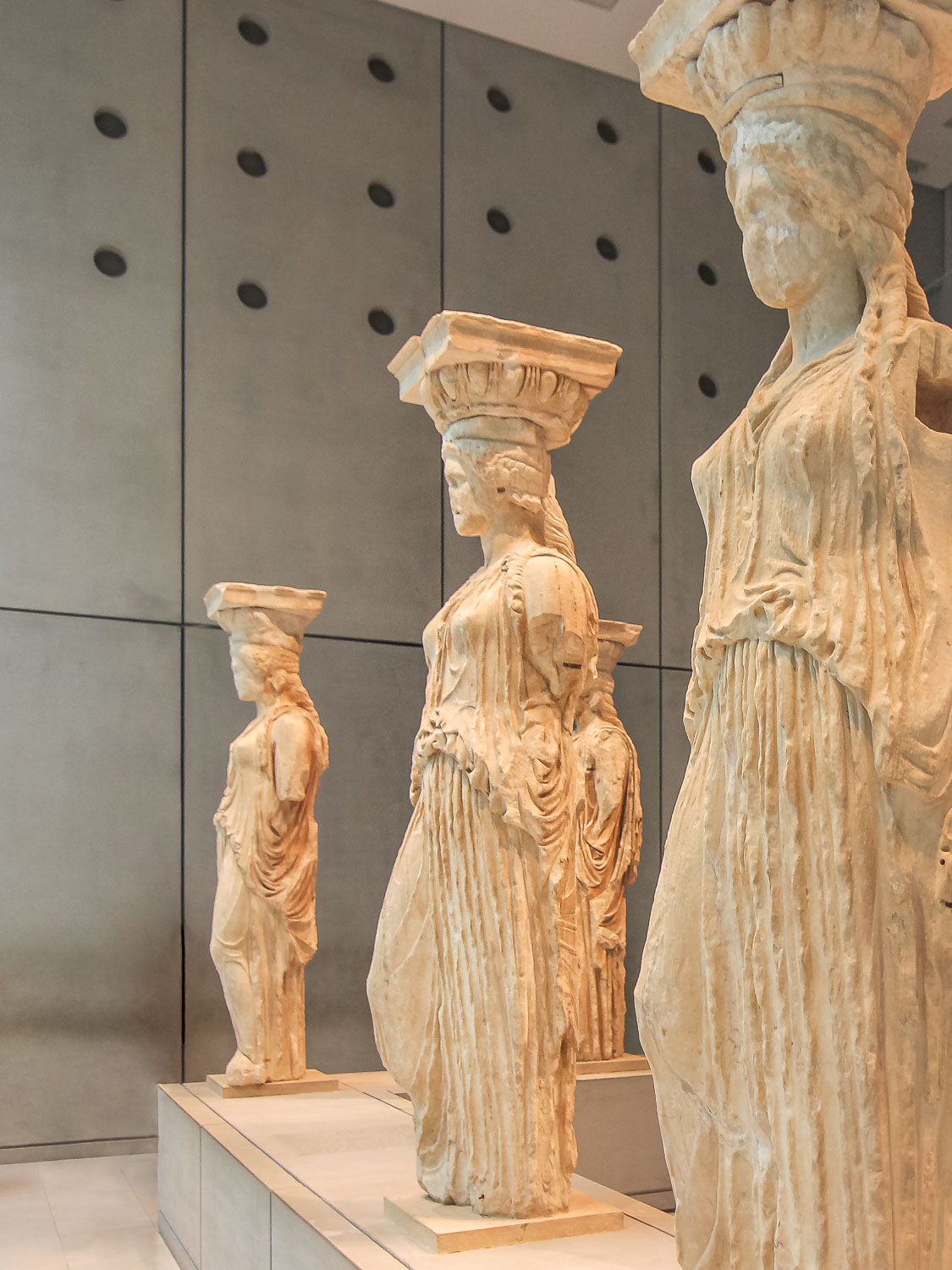
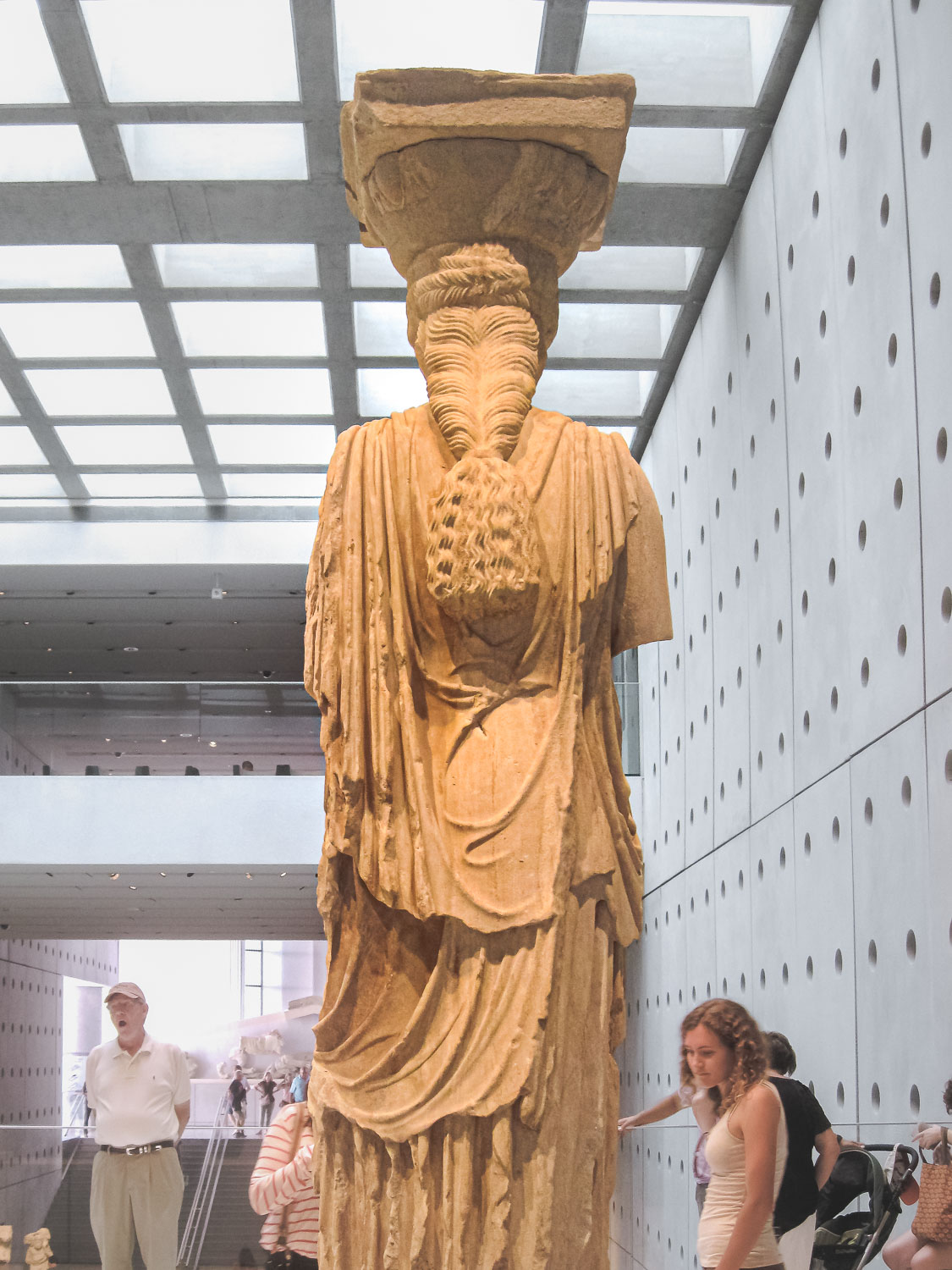
The top floor of the museum is especially impressive. With floor to ceiling windows that let in a ton of natural light and views of the Acropolis site, the artifacts are displayed in a structure that mimics the Parthenon, making it easy to imagine where the artifact belonged on the original building. The 2 levels of detailed friezes and expressive pediment sculptures are so beautifully crafted, depicting dramatic stories from Greek mythology and history that gave us a whole new sense of the Parthenon’s grandeur in its prime. The museum is a must see.
After hours of looking at the artifacts, we took a break for a long relaxed lunch at Spezie. By this time we had gotten used to the laid back service in Greece, a notable difference from what we’d been used to in New York. After lunch we took a taxi to the historical Panathenaic Stadium, which hosted the first modern Olympic games in 1896. Made completely of marble, this stadium has been used since the Roman times but still looks in perfect shape, ready for many more events. With no one around, we lived our Olympic dreams – we ran out of the tunnel, and addressed the imaginary crowd, took a victory lap, and stood on top of the podium (obviously the No.1 spot). As silly as it was, it was a lot of fun and the closest we’ll get to Olympic glory.
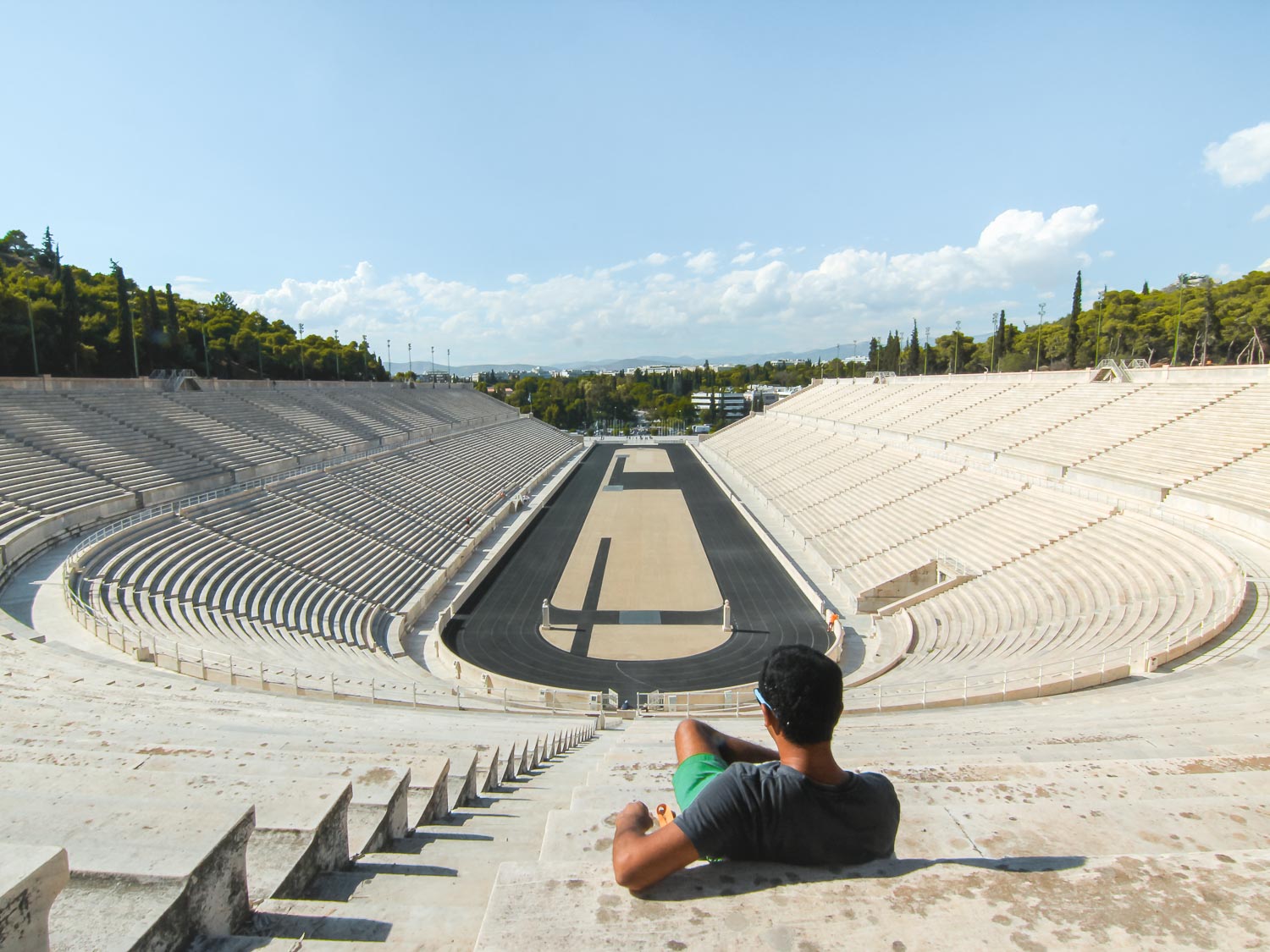
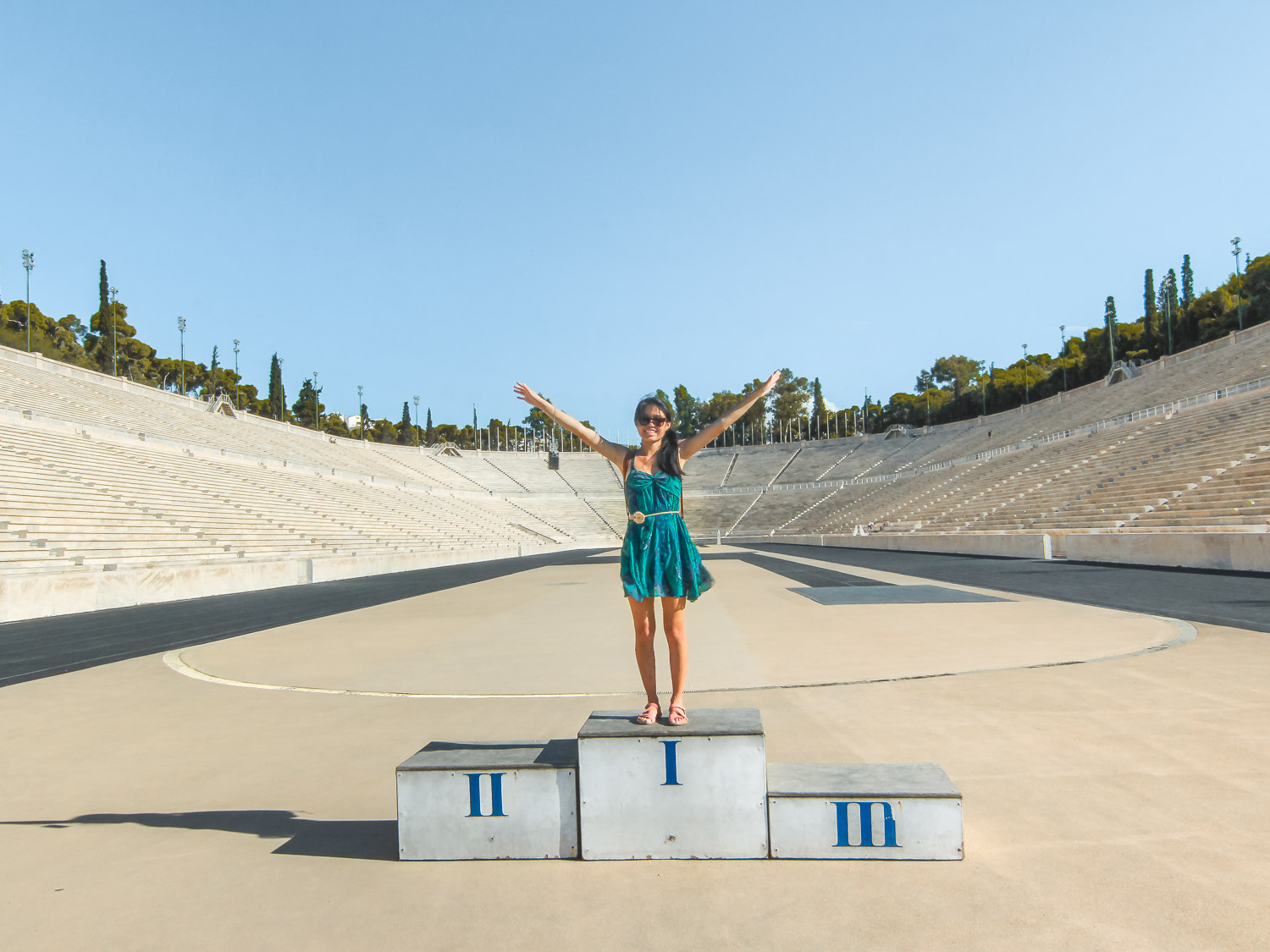
Our historical quest wasn’t over just as yet. From the stadium we headed back towards the Acropolis to visit the Roman Agora. It was once a bustling marketplace but today only a few columns remain. Even the area around the Agora is in a state of decline with most walls bearing graffiti all over. Right next to the Roman Agora is the Ancient Agora, which once housed several temples and was used by Athenians to carry out political, business, and other literary activities. We walked through the restored Stoa of Attalos, a colonnaded covered walkway which now contains the artifacts from the Agora. From the Stoa, we could see the Temple of Hephaestus, the Greek god of metalworking and craftsmen. It is in great condition and from a distance it looked like a miniature of Parthenon. With the hot sun beaming down and our energy waning, we decided to cut our Agora tour short and turn back.
Our evening was spent exploring the flea markets near Monastiraki Square. Monastiraki is a lively neighborhood that feels more local (than Plaka), although still very touristy. Monastiraki square is extremely busy and has a metro station along with several iconic landmarks such as the ruins of Hadrian’s Library, Tzistarakis mosque, and Church of the Pantanassa. Nearly all of the streets north of Monastiraki Square are much quieter and covered in Graffiti. After an hour of strolling up and down the flea market we acquired several trinkets along with two beautiful hand painted vases, one featuring Athena and Poseidon and the other with Apollo and Hestia.
From Monastiraki we walked back to Makrygianni, and ate dinner at Makrigianni 3 while admiring the lights on the Acropolis. Back at the hotel we packed up and prepared to leave for Santorini.
Part of the Cyclades, Santorini is a collection of islands in the Southern Aegean sea. The tiers of white and blue buildings along the peak of a crescent-shaped caldera are instantly recognizable and have been a draw for tourists all around the world.
DAY 6: SANTORINI
We took the morning flight from Athens and arrived in Santorini around noon. Although part of Greece, the life and the economy of Santorini is very different from the capital. While Athens was going through a recession, business in Santorini was booming, much of it attributed to tourism. We soon found this out when we tried to hire a taxi to our hotel. Everything in Santorini was much more expensive and so at first we thought we were getting cheated by the high taxi fares.
In Santorini, we stayed at the Santorini Palace Hotel in the island capital, Fira. This beautiful white-washed hotel is a terrace away from the cliff, but not on the cliff itself. On the island, booking a hotel room on the cliff side with an ocean view, better yet an ocean view with a private pool is the way to go. But by the time we started looking at places, all of the reasonably priced places were sold out and the rest were simply outside our budget. Nevertheless we were happy with our room, especially our sun-soaked terrace.
We ate at the nearby Mama Thira Taverna, a greek restaurant overlooking the sea below. Our plan for the day was to hike from Fira to Oia, roughly from the middle of the island to the Northern end along the volcanic rim. This 6.4 mile hike provides fantastic opportunities to view the caldera from multiple angles and admire the ever changing landscape from both the inhabited and uninhabited parts of the island.
We started our hike at 3:15 PM right next to our hotel. The first part is a gradual uphill climb on the pathway that runs from Fira to Imerovigli. Throughout this part we had panoramic views of white-washed houses stacked on top of each other along the crater rim. Most of these houses have smooth rounded ceilings and occasional blue accents, which makes for a postcard worthy photograph. By the time we reached Imerovigli we had seen numerous churches, bell towers, and houses with pools overlooking the sea. We surely could have used a dip in the pool especially with the sun beating down on us.
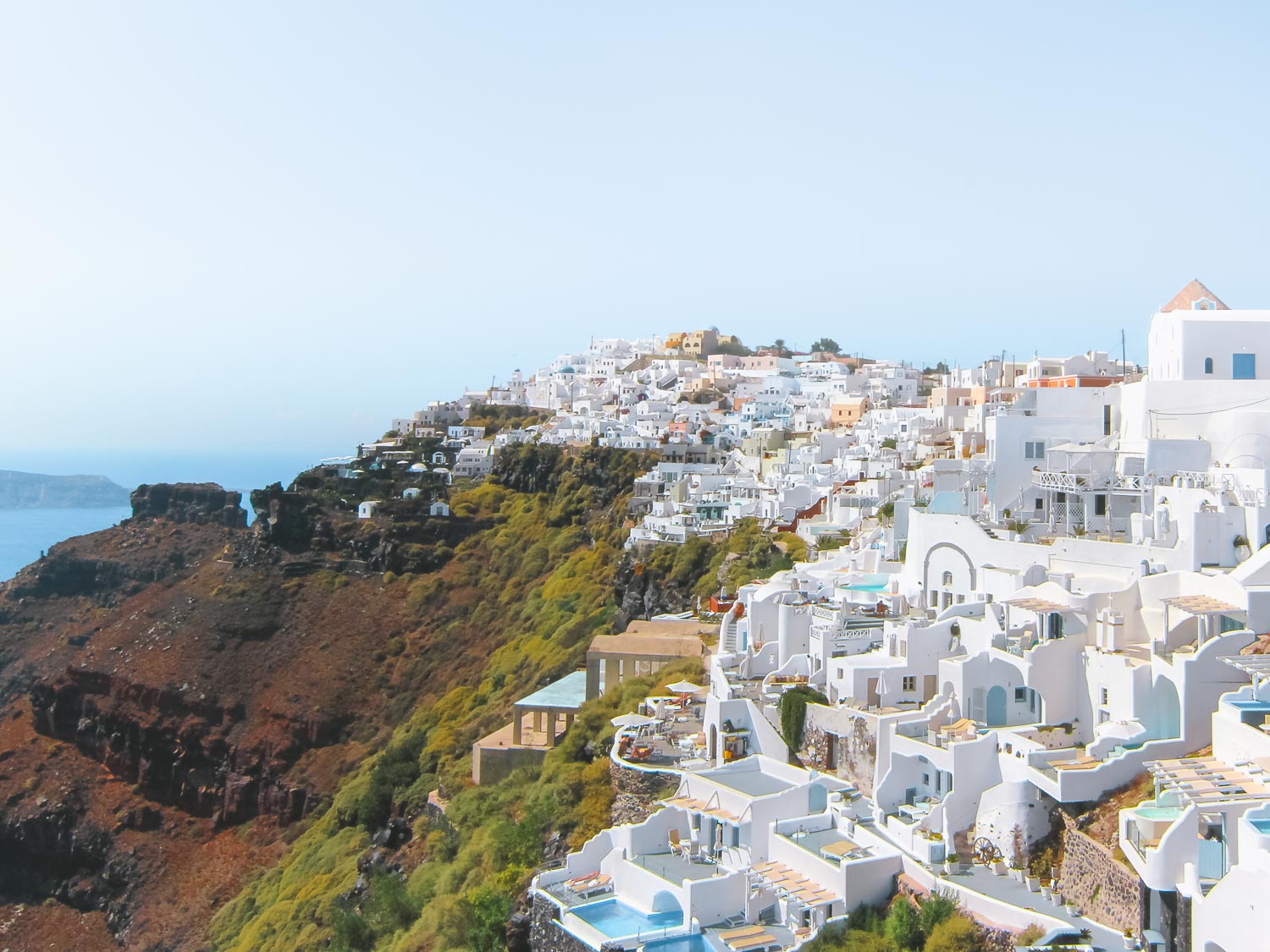
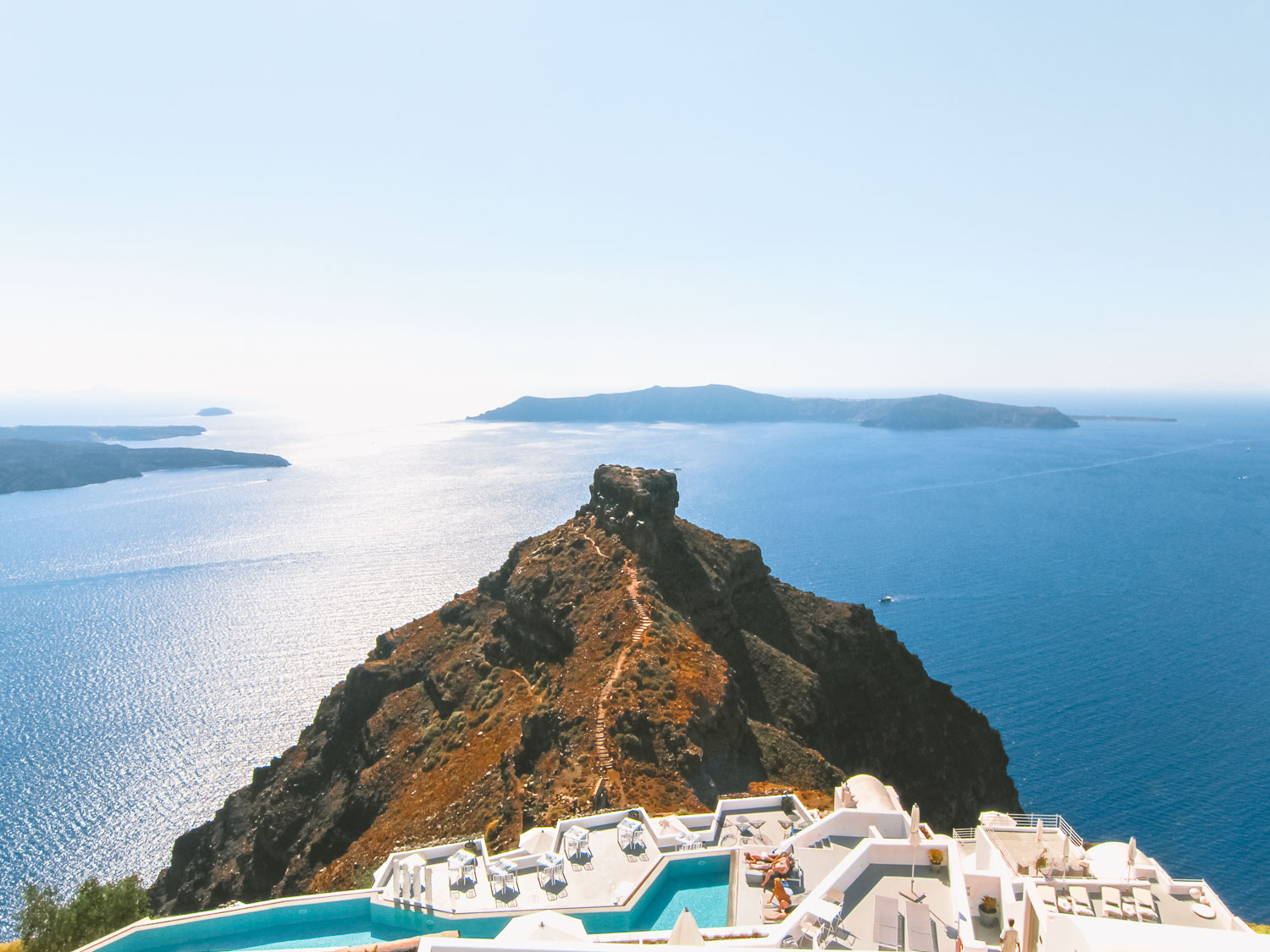
Imerovigli is hard to miss on the hike. There is an iconic elevated rocky formation right in front of the village named the Skaros Rock. This was once the largest settlement on the island but today only a small church remains at the base of the rock. The hike to the rock and back is roughly 0.8 miles. We decided to skip it and instead sought some refreshments in the town. Imerovigli looks very similar to Fira, but is much smaller and quieter. If nightlife is not something on your list, this is a good alternative to Fira.
The next 1.5 miles from Imerovigli to the church Profitis Ilias is still paved but is much less populated. Right as we left the main Imerovigli town, the building density suddenly dropped. On this path all the buildings are constructed on the right which provide an uninterrupted view of the crescent-shaped caldera and the beautiful azure waters below. Most buildings on this path are resorts with occasional mansions and instead of being stacked on the hill, they were laid right next to each other.
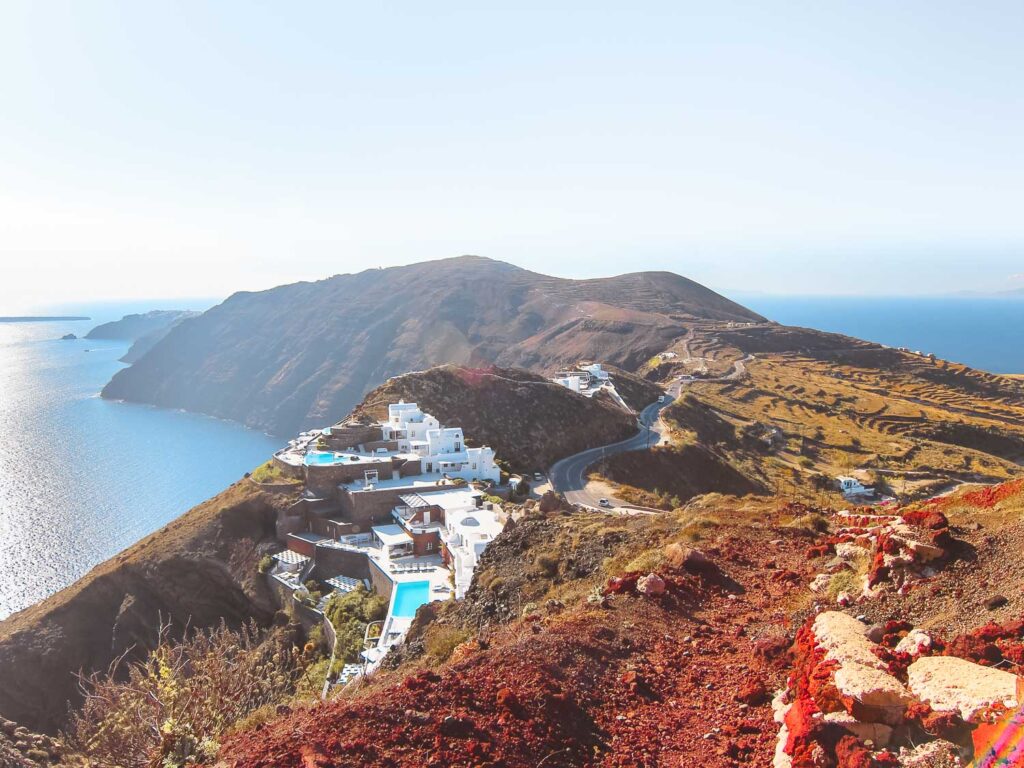
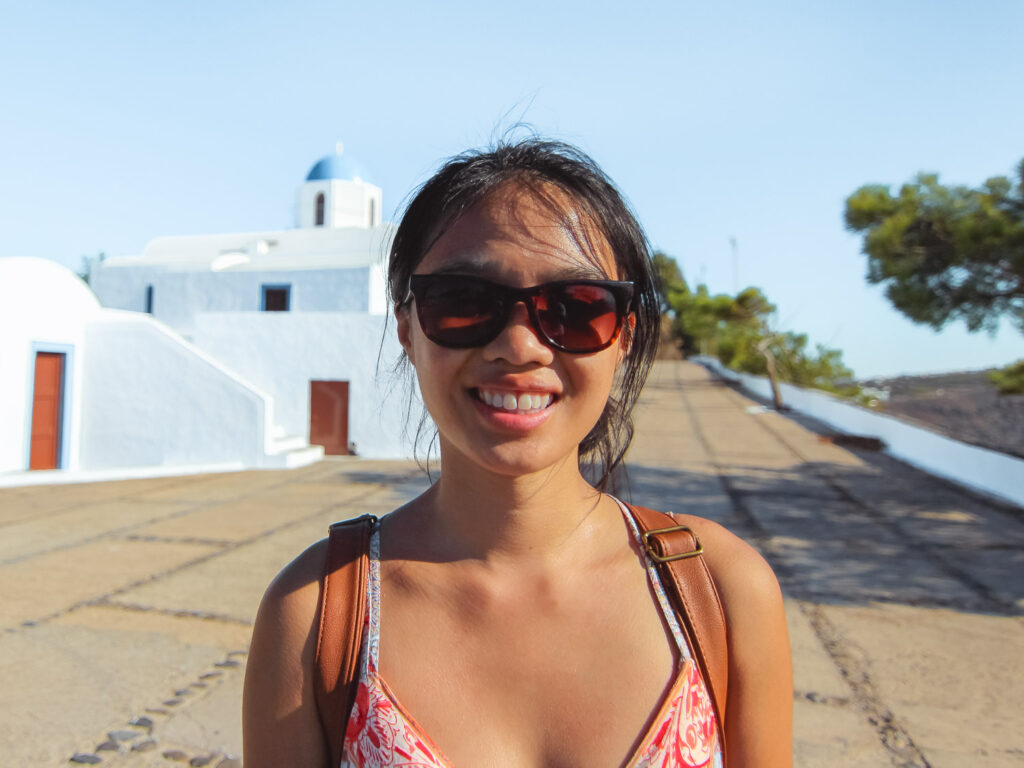
After Profitis Ilias, the hike is a dirt trail with red and block volcanic rocks all along the path. From the church we went downhill and joined the road, Epar.Od. Firon-Ias near San Antonio Hotel. After walking another 0.3 miles on the road, we came across a snack shop that sold refreshments and had some seating. This is the last rest stop before Oia. At the stop, we forked from the road and resumed our hike on the rocky, dirt trail. This part is the steepest part of the hike and is also very desolate. Tired and weary, we wished we had taken the bus when the trail had joined the road. It certainly didn’t help that we were wearing flip flops on this trail. As we got closer to Panagia, a Greek Orthodox church, we saw a couple of horses coming towards us. We paused and wondered if we should convert this to a horse tour, but instead powered on as we were almost at the top. It was 6:30 PM.
From Panagia, we could see all around the island, the arc of the caldera, the plains, and the town of Oia right in front of us. From here the hike is all downhill, and as we got closer to the town of Finikia, the dirt trail turned into a paved path again. The sun had followed us throughout the hike and now was right in front of us. As we got closer to Oia, the path got crowded and the cliffside was once again covered with picturesque buildings with perfect sunset terraces.
Oia is the second biggest town on the island and is also very touristy. The streets of Oia are lined with restaurants, art galleries, jewelry stores, and souvenir shops. But perhaps the biggest attraction of Oia is the sunset. Every evening tourists gather in throngs at the Sunset Serenade point to watch the sun cast its last rays of golden light on the picturesque slopes. We didn’t need directions, we simply followed where all the people were headed. We finally found ourselves at the Four Bells, between the Windmill and the Castle ruins. The entire place was full of people and finding the perfect spot was going to be a challenging endeavor. We were just happy that we didn’t miss the sunset.
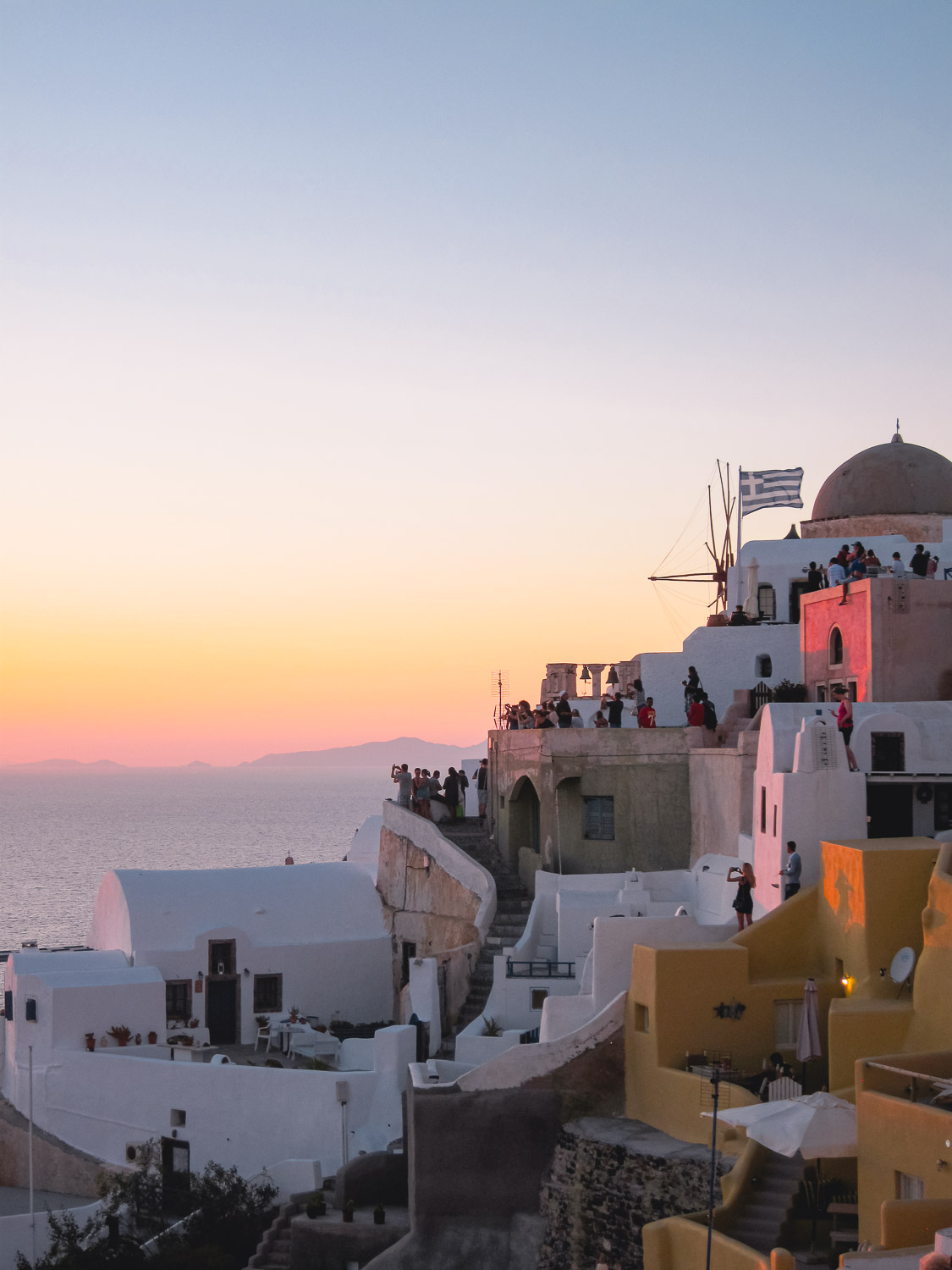
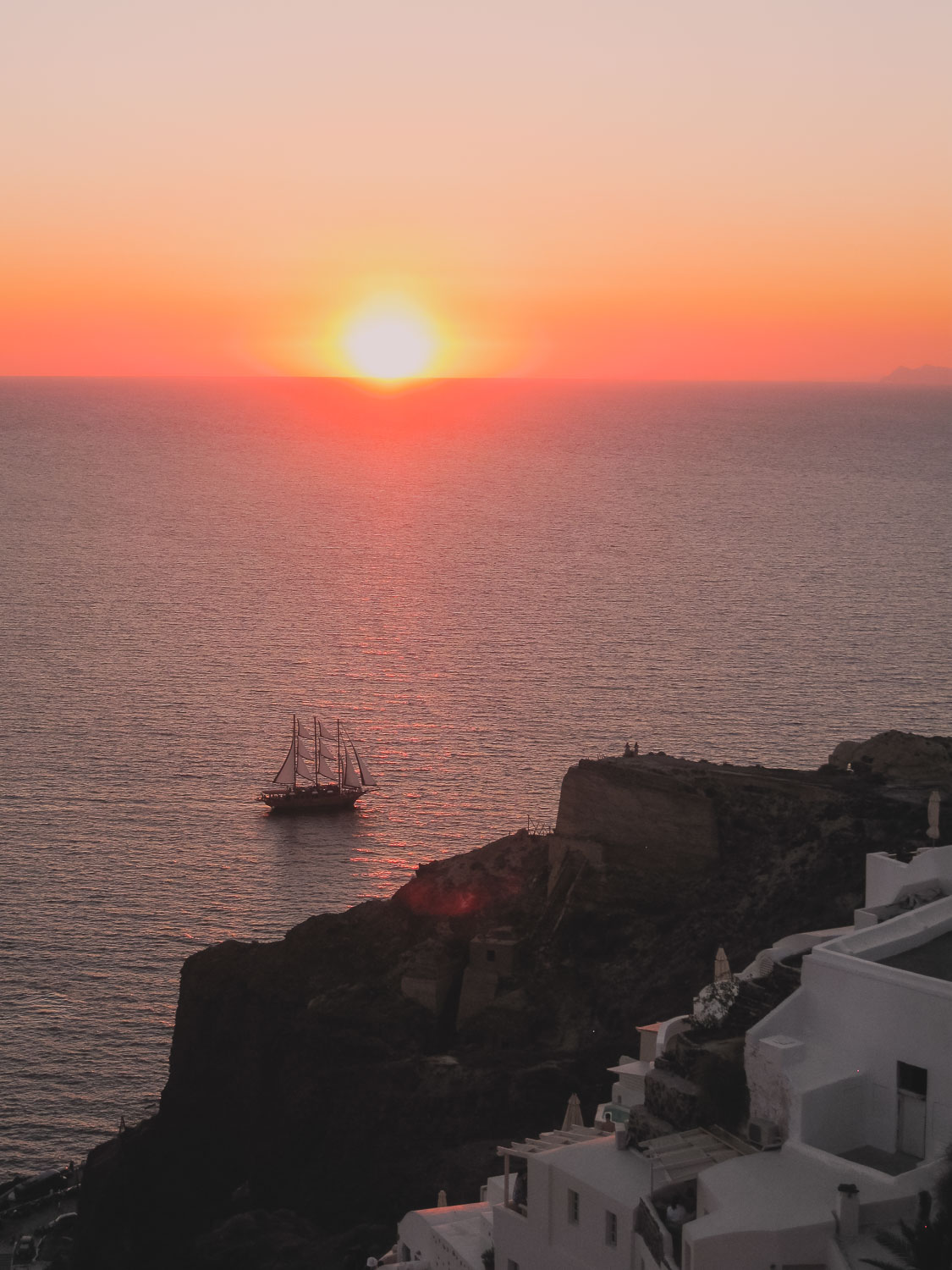
As the sun drew closer to the horizon, it grew redder, and cast a bright glow across the Aegean, lighting up all the sail boats in its path. Within seconds the sun was gone, completely below the water’s edge, leaving a soft purple-pink glow in the sky. After sunset, we wandered the streets, looking for places to photograph the town under the twilight.
As the sky got darker, we decided to find a place for dinner. Nearly every restaurant was fully occupied and we couldn’t find a place that could give us a wait time. We eventually ate at Thalami, a greek restaurant with views of the stacked cliffside. Tired from the hike we enjoyed a peaceful dinner over drinks, and then took the bus back to Fira, admiring the distance we had traveled on foot a few hours earlier.
DAY 7: SANTORINI
Our plans for the day was to explore the southern part of the island, mainly the Akrotiri archaeological site and Red Beach. It was bright and sunny when we woke up. We got ready and went towards Fira downtown to rent a scooter. First we tested out a Quad bike, but ultimately decided to go with a scooter. Fira downtown is extremely busy, not only is it the capital, but also the first stop for all cruise ship passengers. Luckily we were able to find a table at Cafe Classico, a seafood restaurant with views of Nea Kameni Island in the flooded caldera. During lunch we watched the ferries go and back forth between the cruise ships and the port of Fira, bringing more and more people to the island.
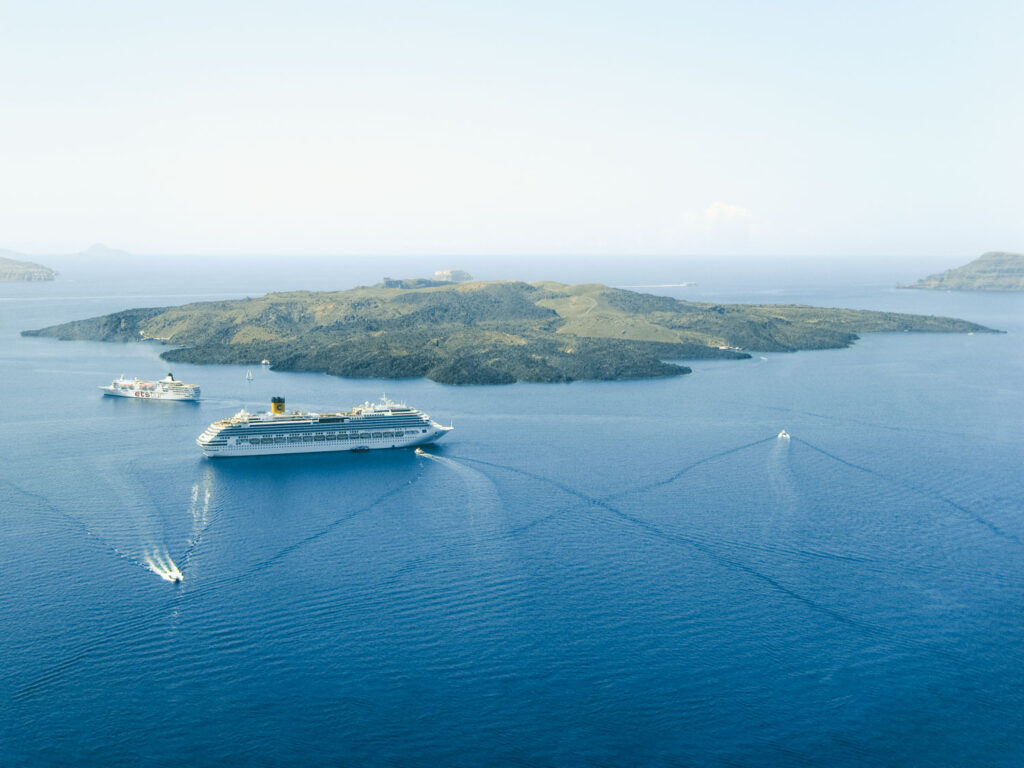
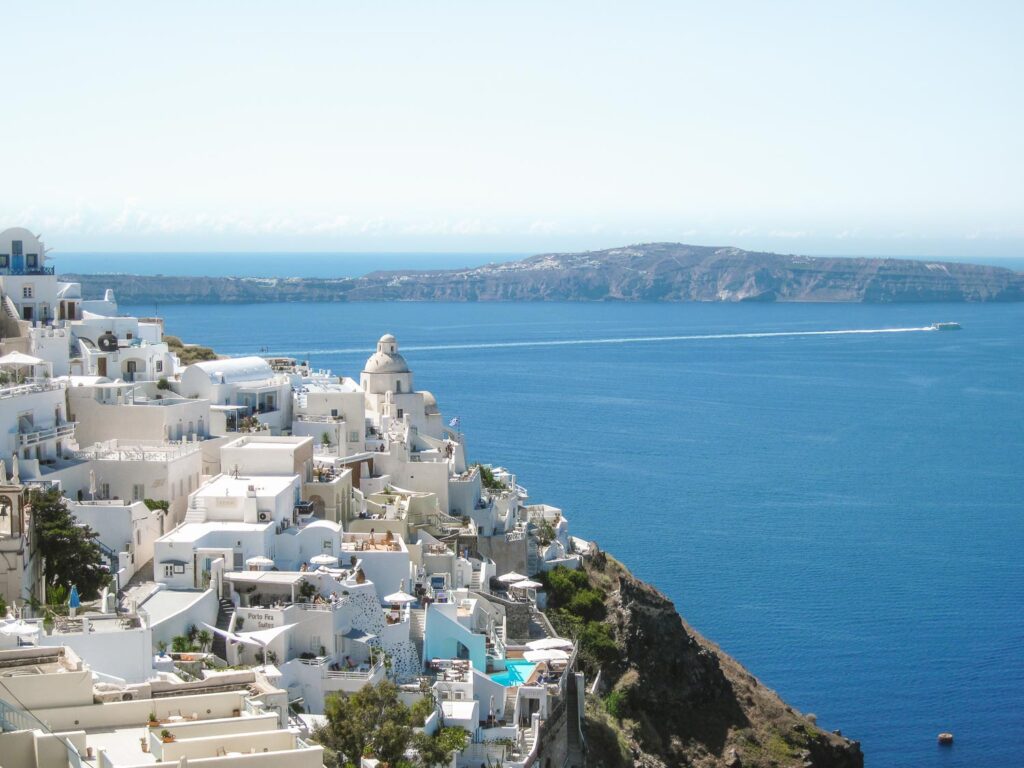
After lunch we left for Akrotiri. Renting a scooter was a great idea. It was liberating to go up and down the winding roads and feel the cool sea breeze on our face. As we got closer to Akrotiri we got a different view of the caldera, this time we could see the full crescent running from South to North. Akrotiri archaeological site is not far from the main town of Akrotiri and lies toward the southern edge of the island.
The prehistoric town of Akrotiri was a bronze age settlement by the Minoan civilization. After a huge volcanic eruption in 1600 BC, also known as the Minoan eruption, the entire town was covered in volcanic ash a few hundred meters deep. The eruption also led to the expansion of the Santorini caldera into what we know today. The ash cover over Akrotiri perfectly preserved the remains of the city and is often compared with the site of Pompeii. Walking over the stilted ramps, we could see the well preserved details of multi-tiered houses, the staircases, wooden doors, window frames, and most importantly the pottery inside. Some of these hand painted jars were completely intact and certainly didn’t look 3,500 years old. The excavations at Akrotiri have also drawn comparisons to Plato’s account of the fabled lost city of Atlantis. While we can never be certain, a visit to Akrotiri is quick and educational.
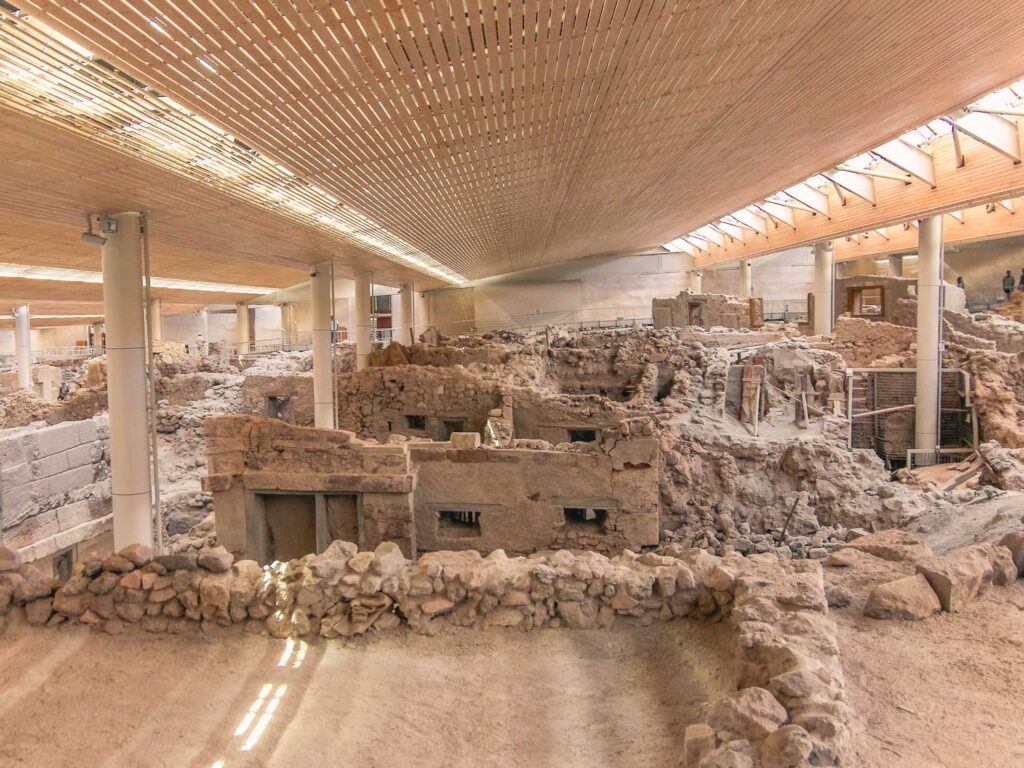
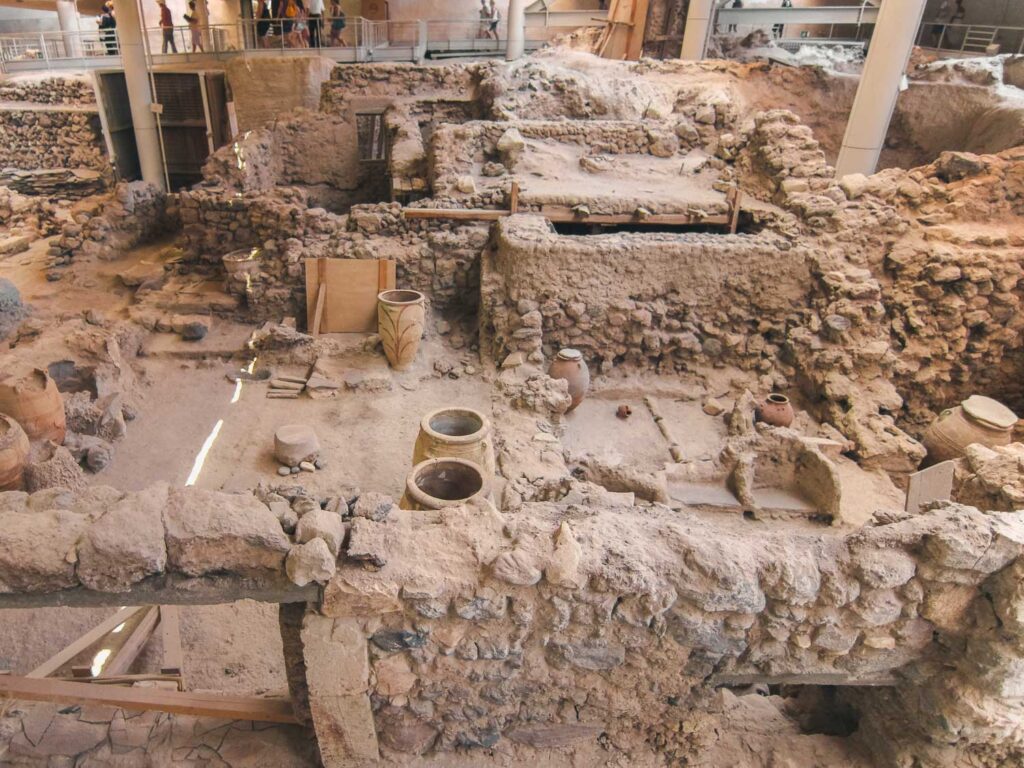
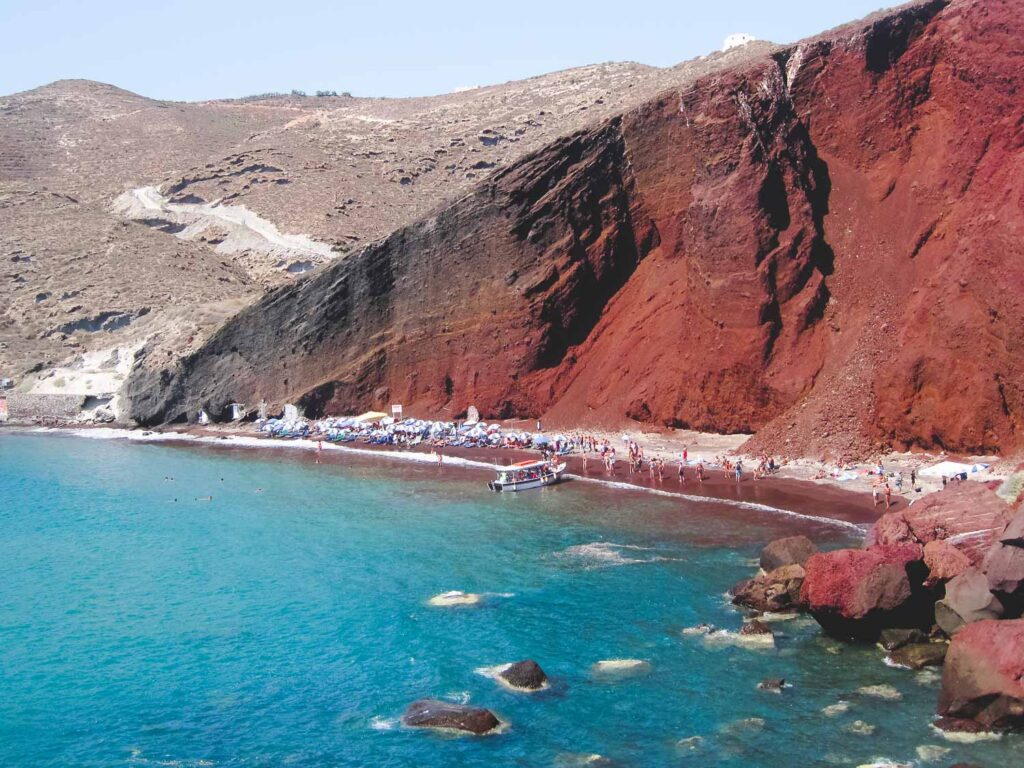
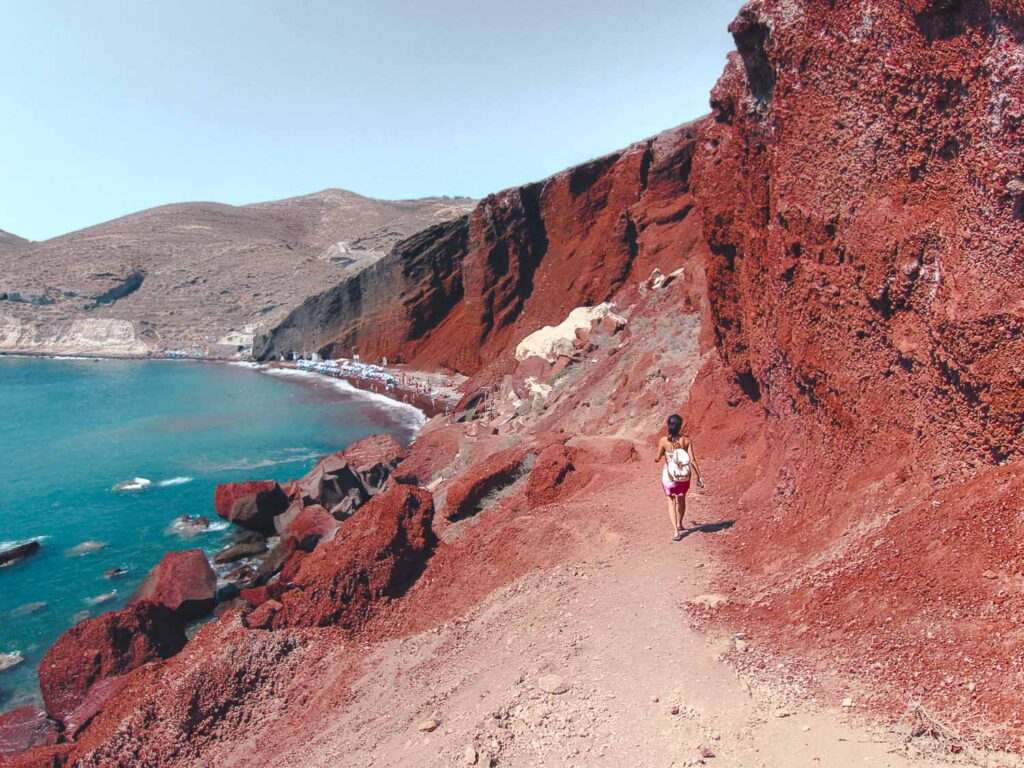
Right next to the Akrotiri archaeological site is another famous attraction, the Red Sand beach. This beach can be accessed after a short downhill hike from a parking lot at the end of the road. While the beach itself isn’t very big, the bright red volcanic cliff behind it gives the beach a dramatic look. These cliffs are also where the beach gets its dominant red color. We carefully hiked down the rocky trail and rented a couple of beach chairs with front row views of the Aegean. We spent the afternoon lazing in the sun and occasionally trading the sunbed for a dip in the sea. It was perfect. The only thing we could have done differently was bring water shoes since the sea bed was sharp and rocky. After hours in the sun, we hiked back to the parking lot and got slushies from a makeshift stall to cool us off.
After a quick shower at the hotel, we took the scooter for another spin, this time North towards Oia. It was far too easy and comfortable to explore the island on a bike so we soon made a loop and headed back to Fira for sunset.
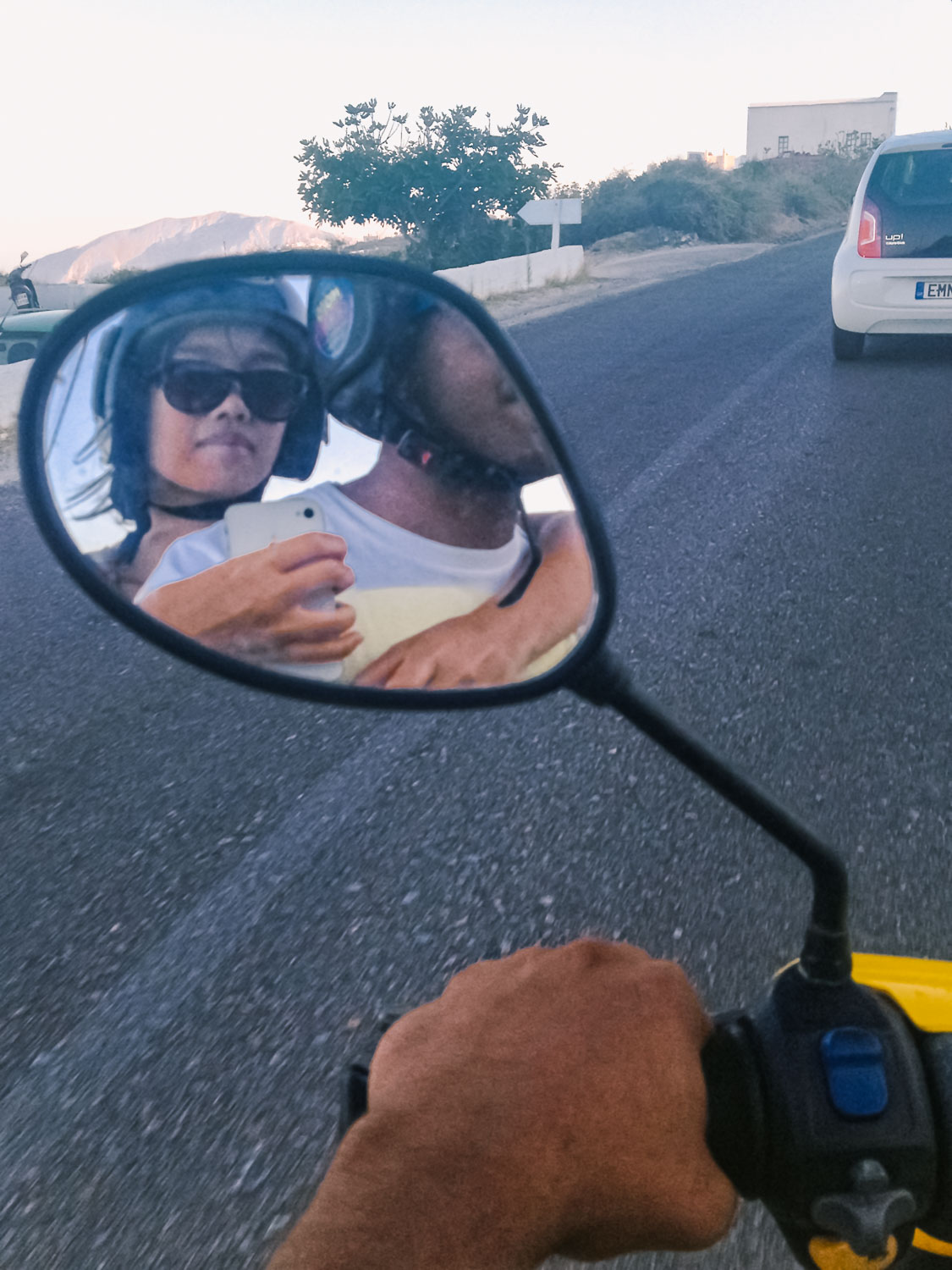
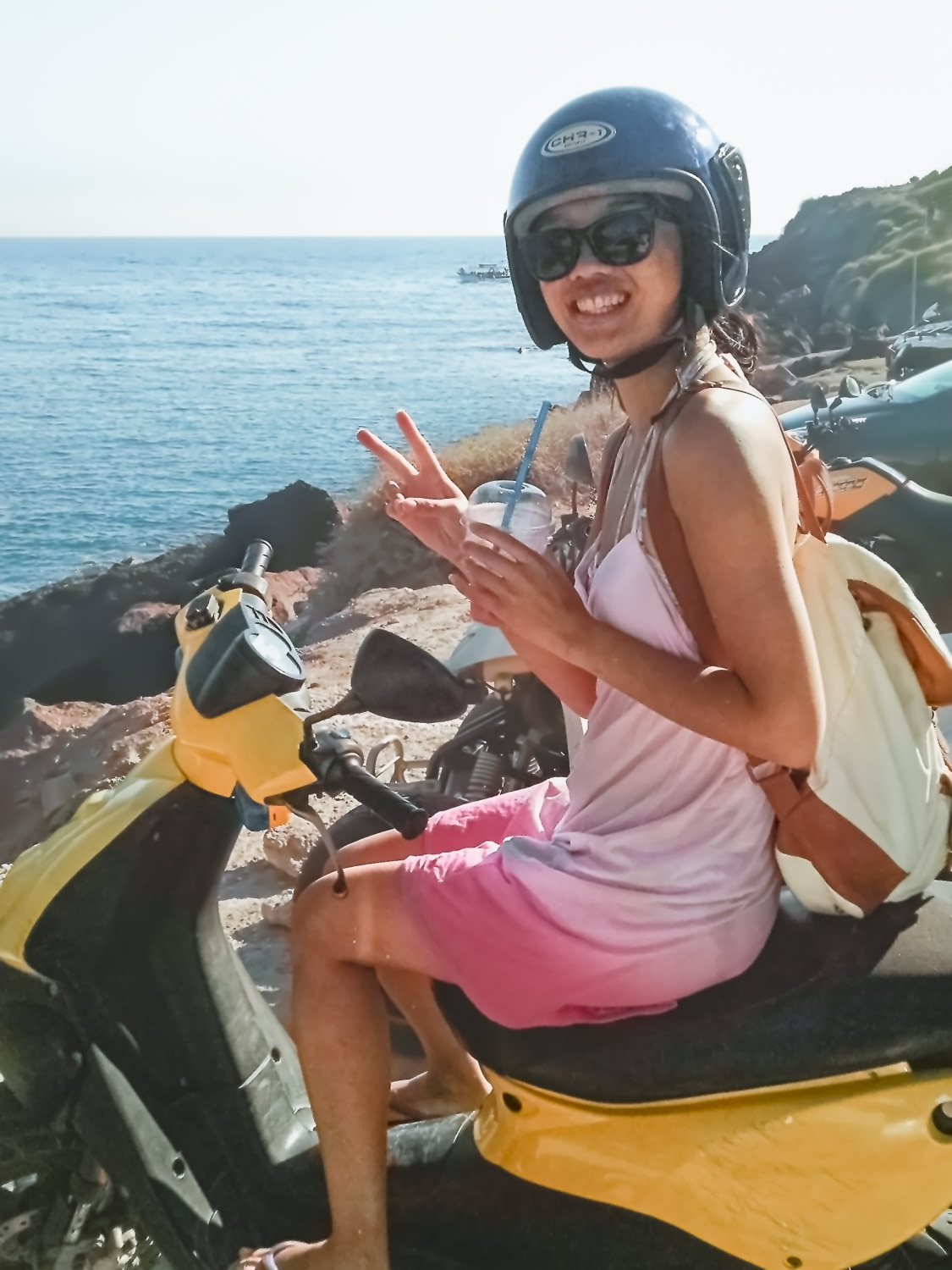
After a quick shower at the hotel, we took the scooter for another spin, this time North towards Oia. It was far too easy and comfortable to explore the island on a bike so we soon made a loop and headed back to Fira for sunset. We found a spot at the top of Karavolades Stairs that connects the Fira town to the old port below. It was the perfect spot. Instead of setting in the sea, the sun disappeared behind the Nea Kameni island, leaving a bright red sky and a prominent silhouette of the island. It was yet another spectacular show. As the crowds dispersed, we stayed a bit longer to admire the lights in the perfectly stacked cliffside.
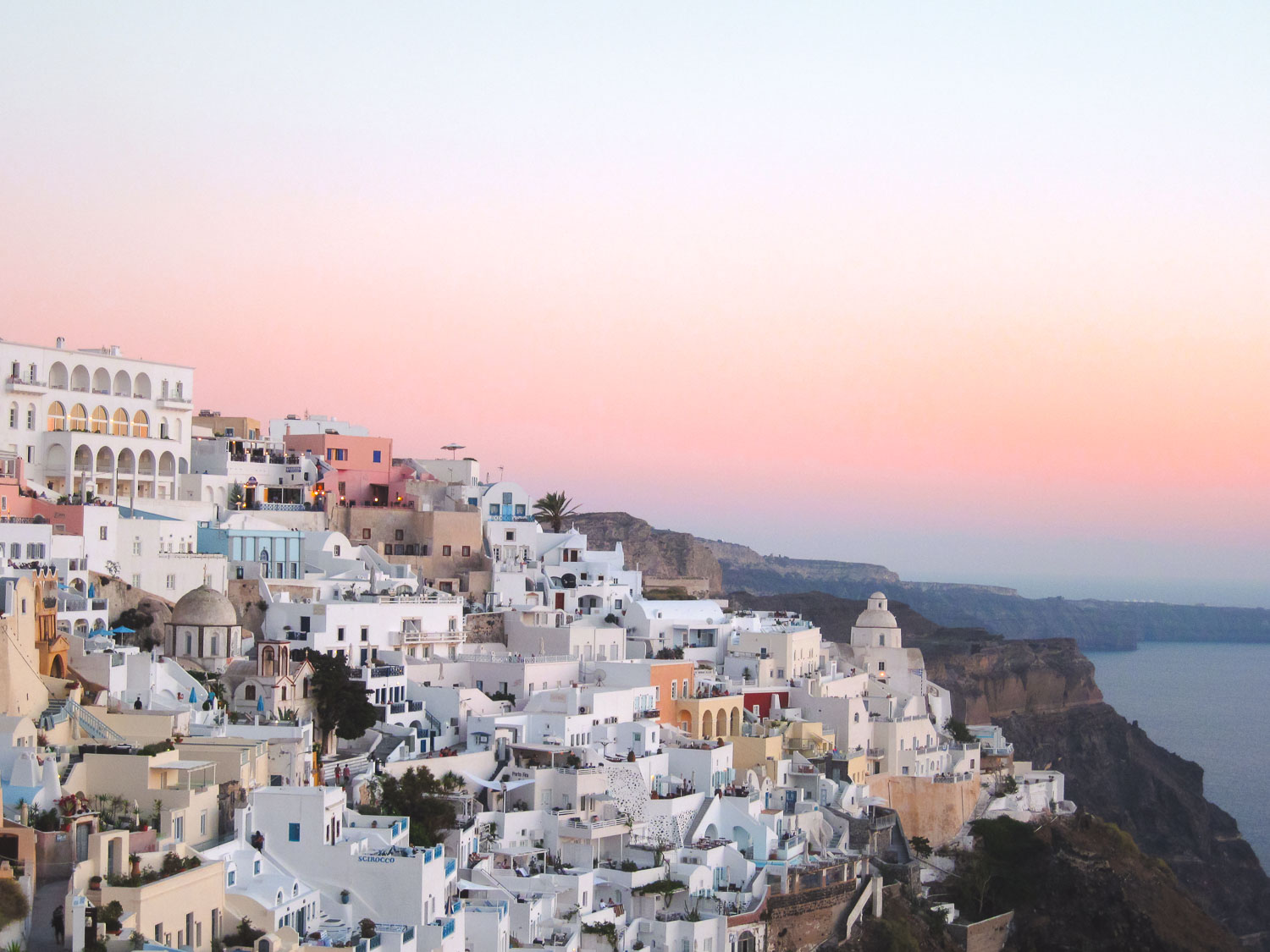
Fira was certainly less crowded than Oia in the evening and we were able to quickly find a table at the nearby Niki restaurant. After dinner, we visited Franco’s bar and ended our day lounging on its terrace, admiring the starry sky and sipping cocktails late into the night.
DAY 8: SANTORINI
This was the last day before we went back to our daily jobs, so all we wanted to do was relax. After getting breakfast at the hotel, we returned the scooter and took the bus to Kamari Beach. A short 20 mins bus ride later, we found ourselves in Kamari Downtown, a block away from the beach. Kamari Beach is a black volcanic sand and pebble beach that stretches from the airport on the north to the Mesa Vuono mountains in the south.
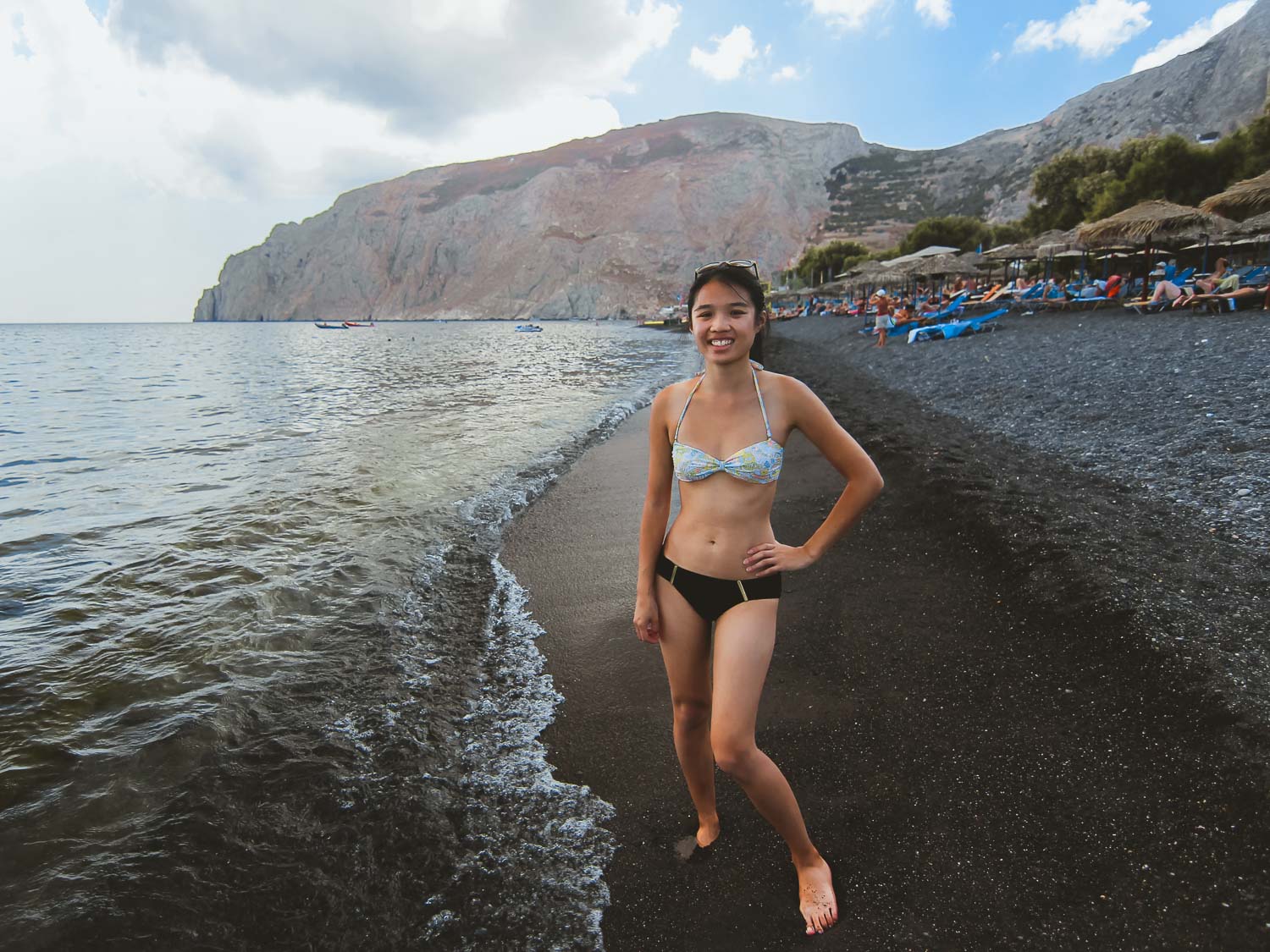
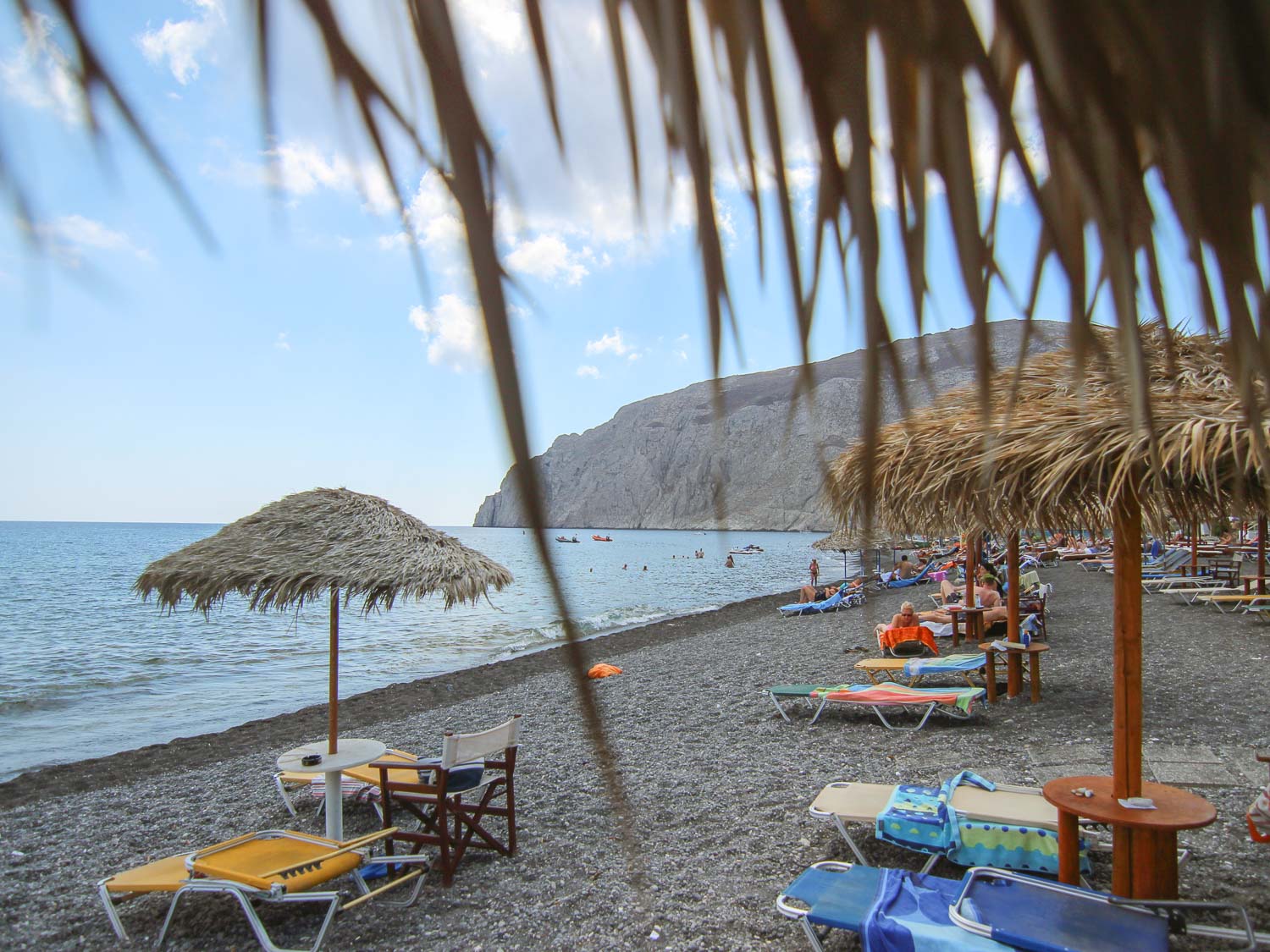
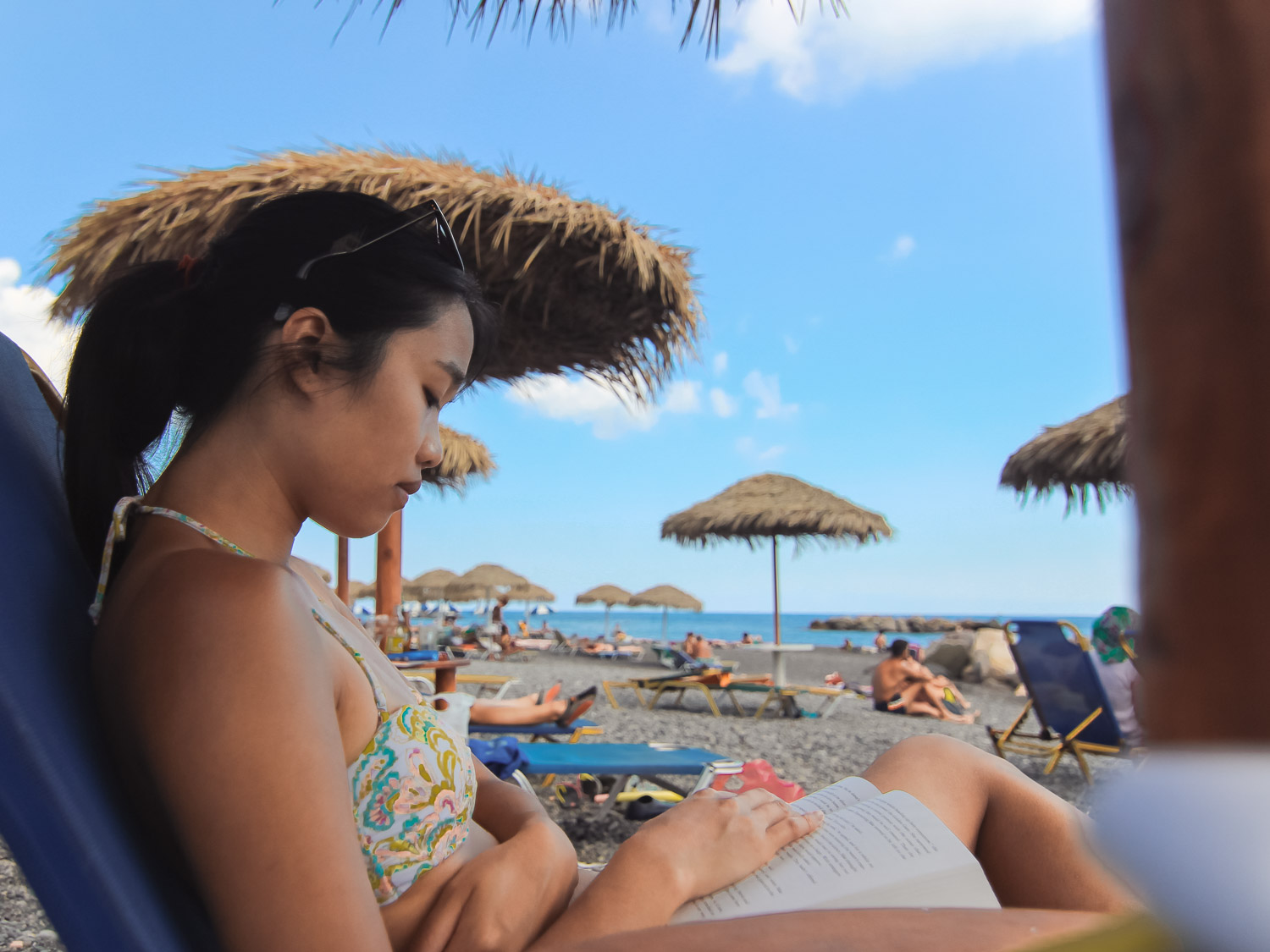
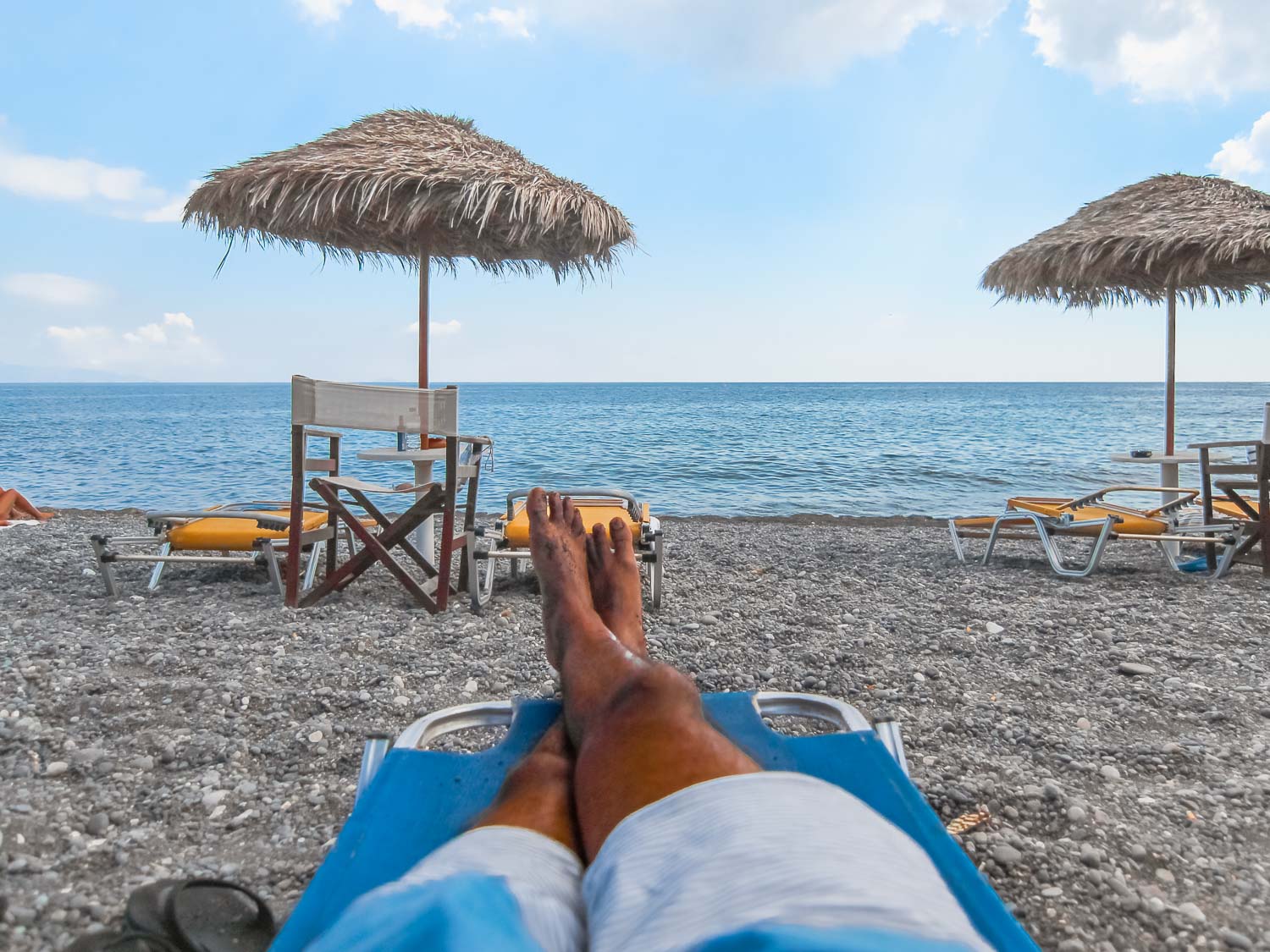
This beach is certainly more developed and neatly covered up by beach chairs and thatched roof umbrellas arranged in perfect lines.
We rented a couple of beach chairs and ordered some piña coladas to start us off. We spent the next few hours napping, reading books, and watching the calm gentle waves. The water temperature was perfect and the black sand near the shore was much finer than we thought. From the shore we also had an uninterrupted view of the imposing Mesa Vuono mountains, which once was the site of the Ancient city of Thera, established by Spartans. We were too lazy to check it out and instead spent our time on the beach. Later in the afternoon, we ate lunch at the nearby Mango Restaurant, one of the many beach shacks and restaurants along the beachfront. The rest of the day was more lazing around, more drinks, and occasional trips to cool off in the sea. After a long day at the beach, we returned back to our hotel for a quick shower.
In the evening we decided to go back to Oia to see Amoudi Bay. After arriving in Oia, we walked the busy streets and occasionally stopped to browse for souvenirs or photograph the iconic blue church domes.
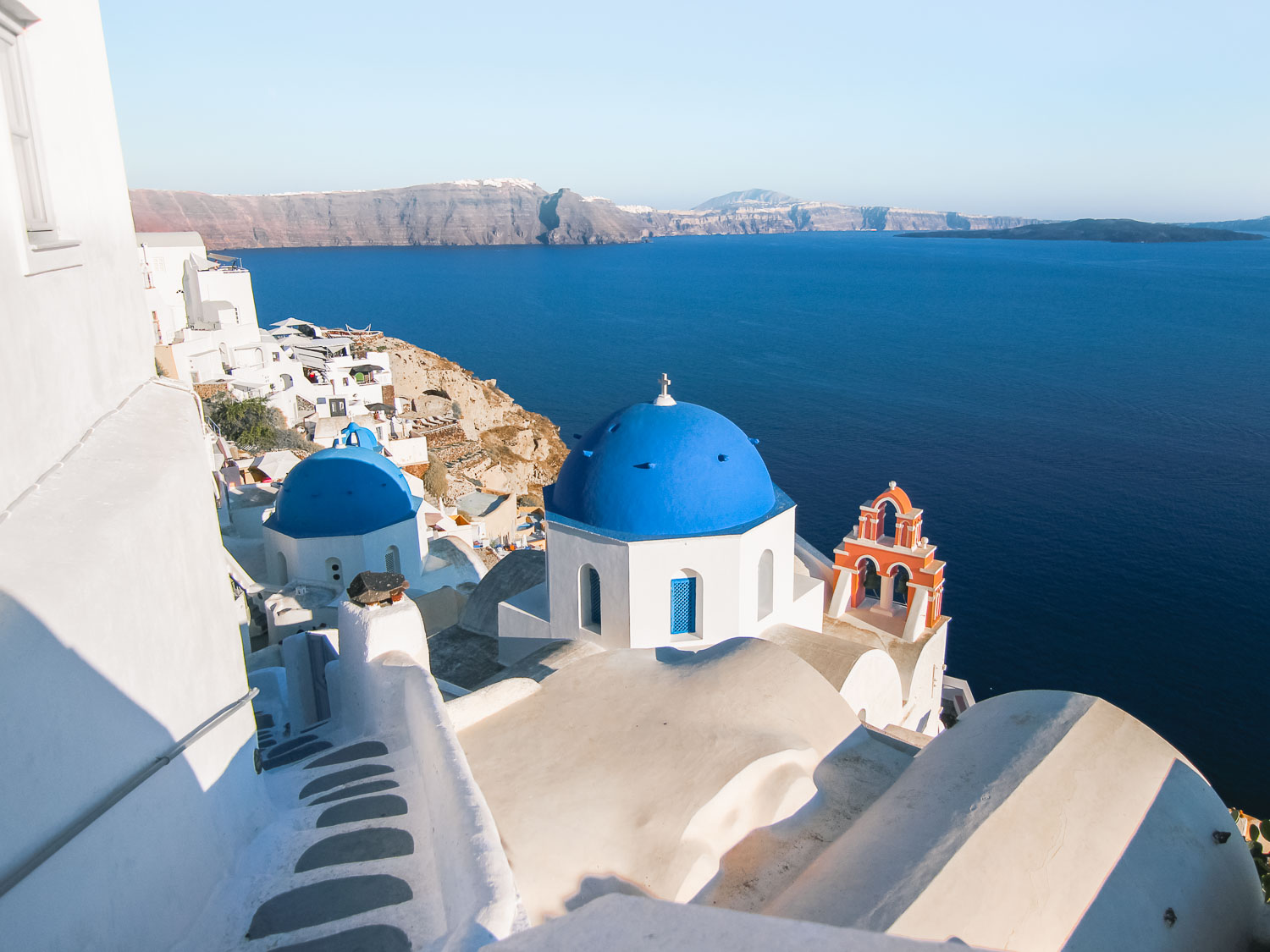
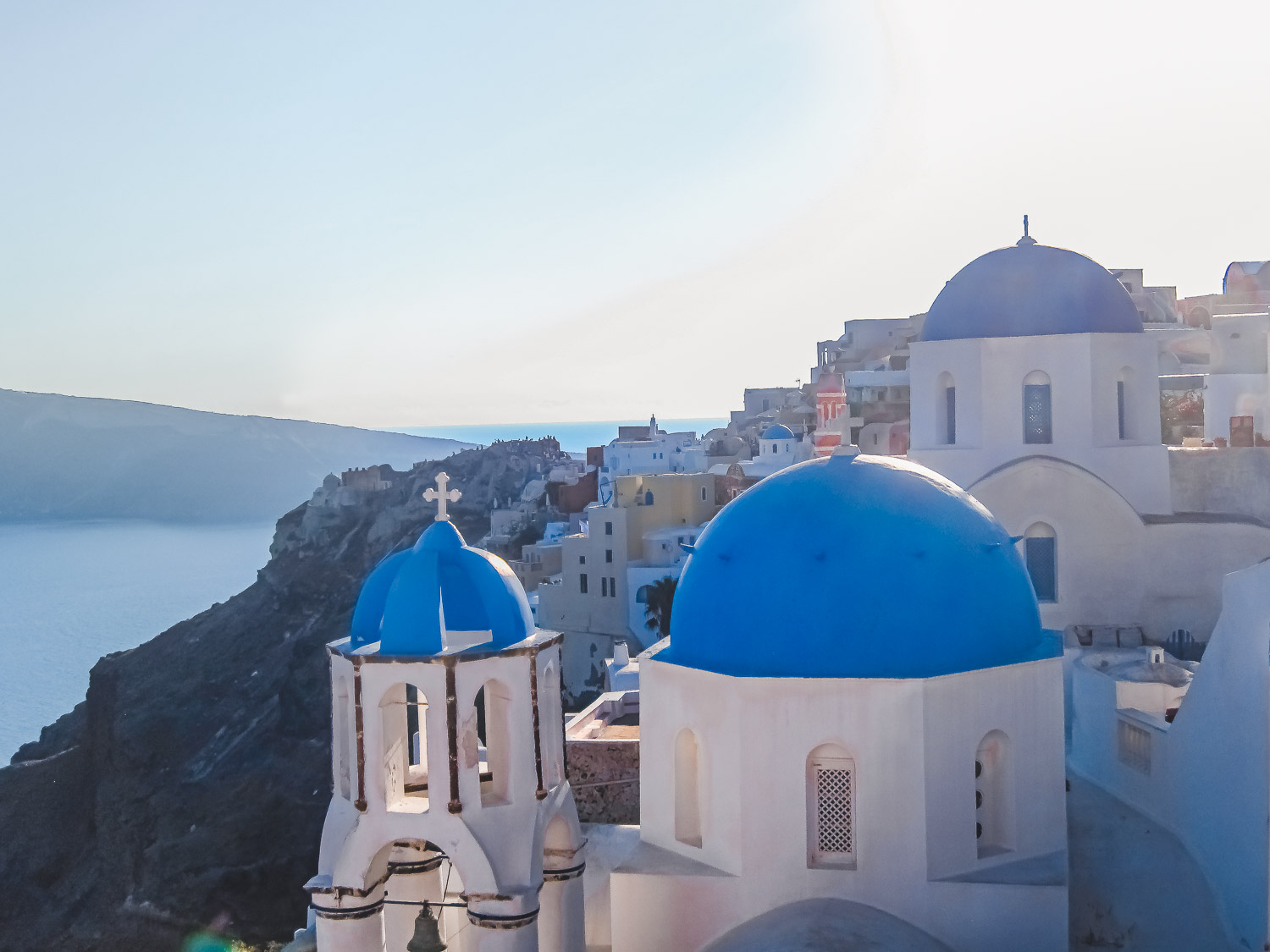
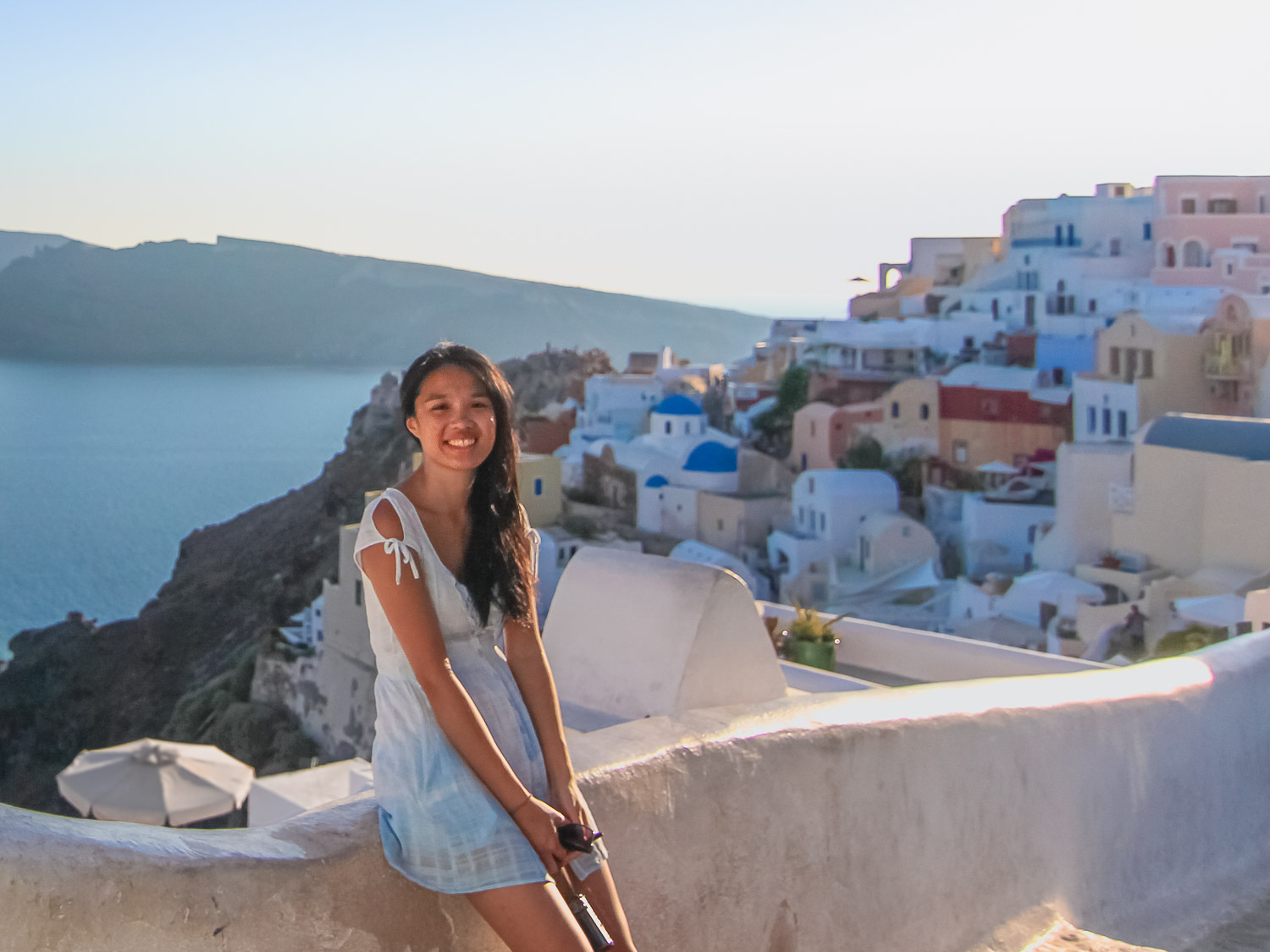
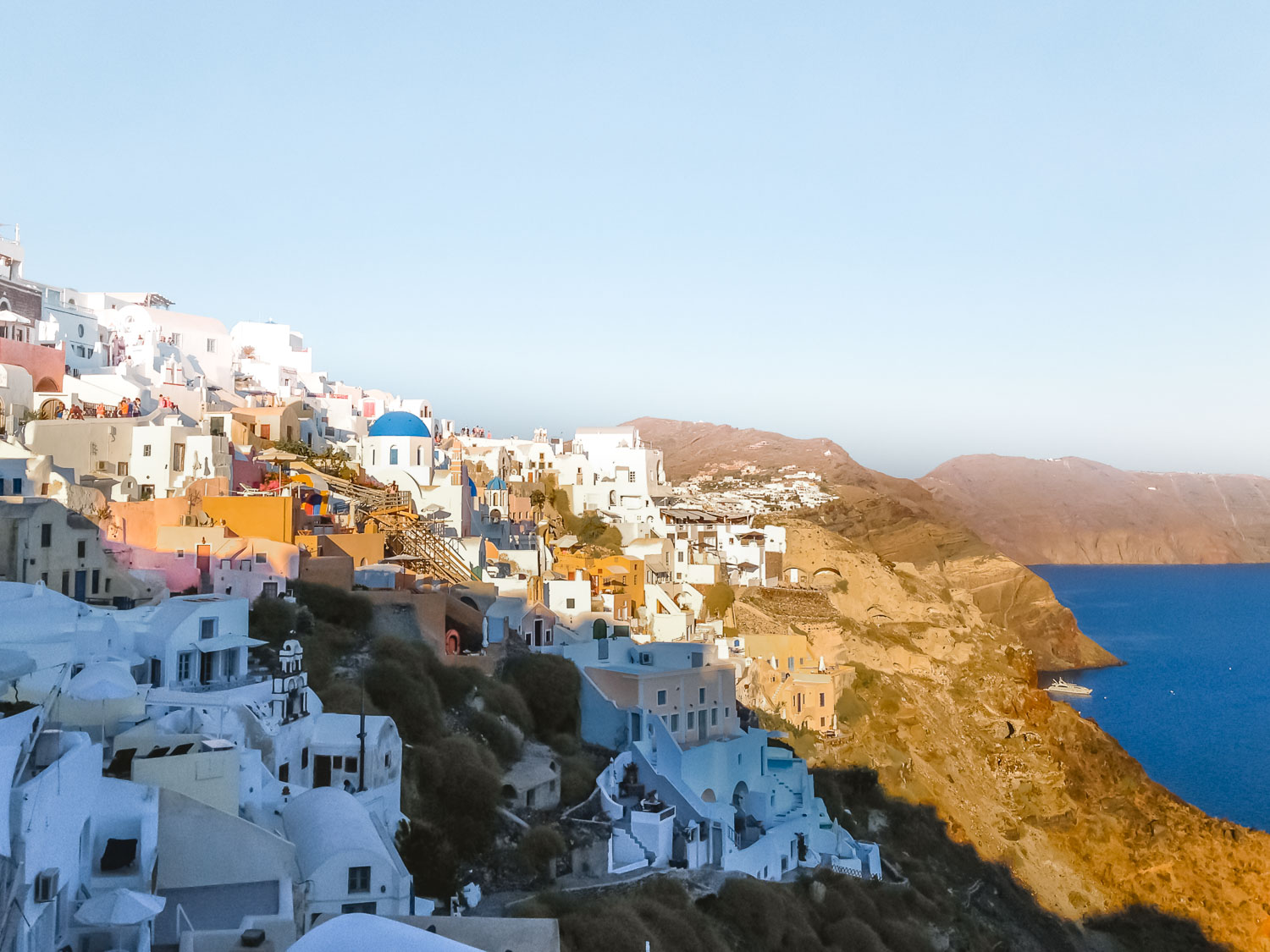
We slowly made our way towards the Sunset Serenade point and found an open terrace on the ruins of Castle of Oia. From the terrace we had a much clearer view of the entire cliff, the stacked venetian villas and among them – the picture perfect windmill. The stage was set and the crowds started to fill in. In no time all levels of this “theatre” were occupied and ready for the sunset spectacular.
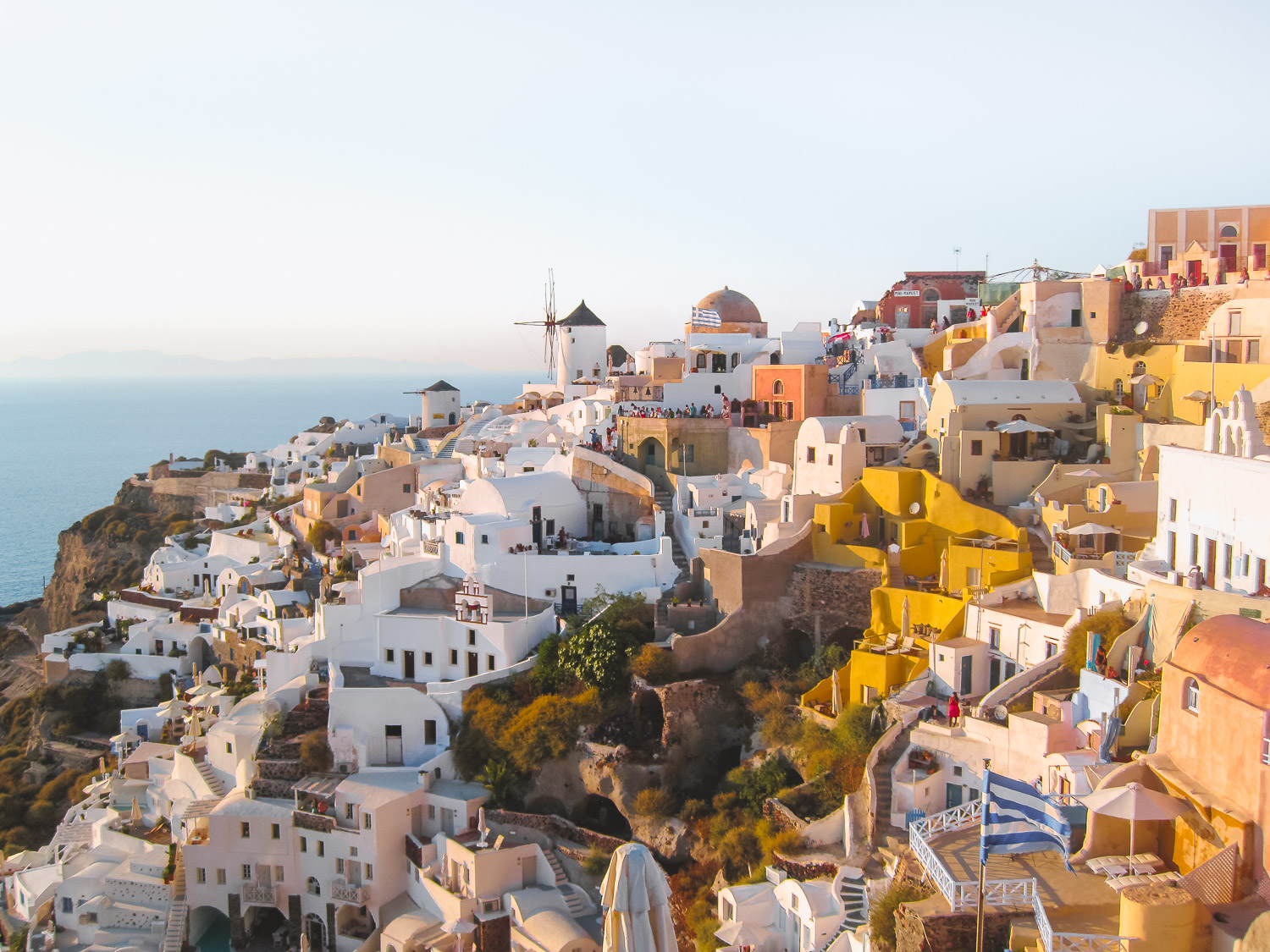
After taking a couple of photos from the top, we descended 200 stairs down the cliff, arriving at Amoudi Bay. Amoudi bay is a small harbor below Oia that is often used by sailing tours as a staging area. Already famous for the romantic sunsets, the bay was further popularized by The Sisterhood of the Traveling Pants 2 and Lara Croft: Tomb Raider – The Cradle of Life.
When we got to the bay there were only a handful of people on the waterfront. There are a few restaurants on the bay that offer alfresco dining, but none had open tables. It was after all, prime time. We sat by the water watching the sun slowly inch towards the sea. The warm rays of the sun had turned the turquoise waters into shimmering gold and the cliff above appeared more red than ever.
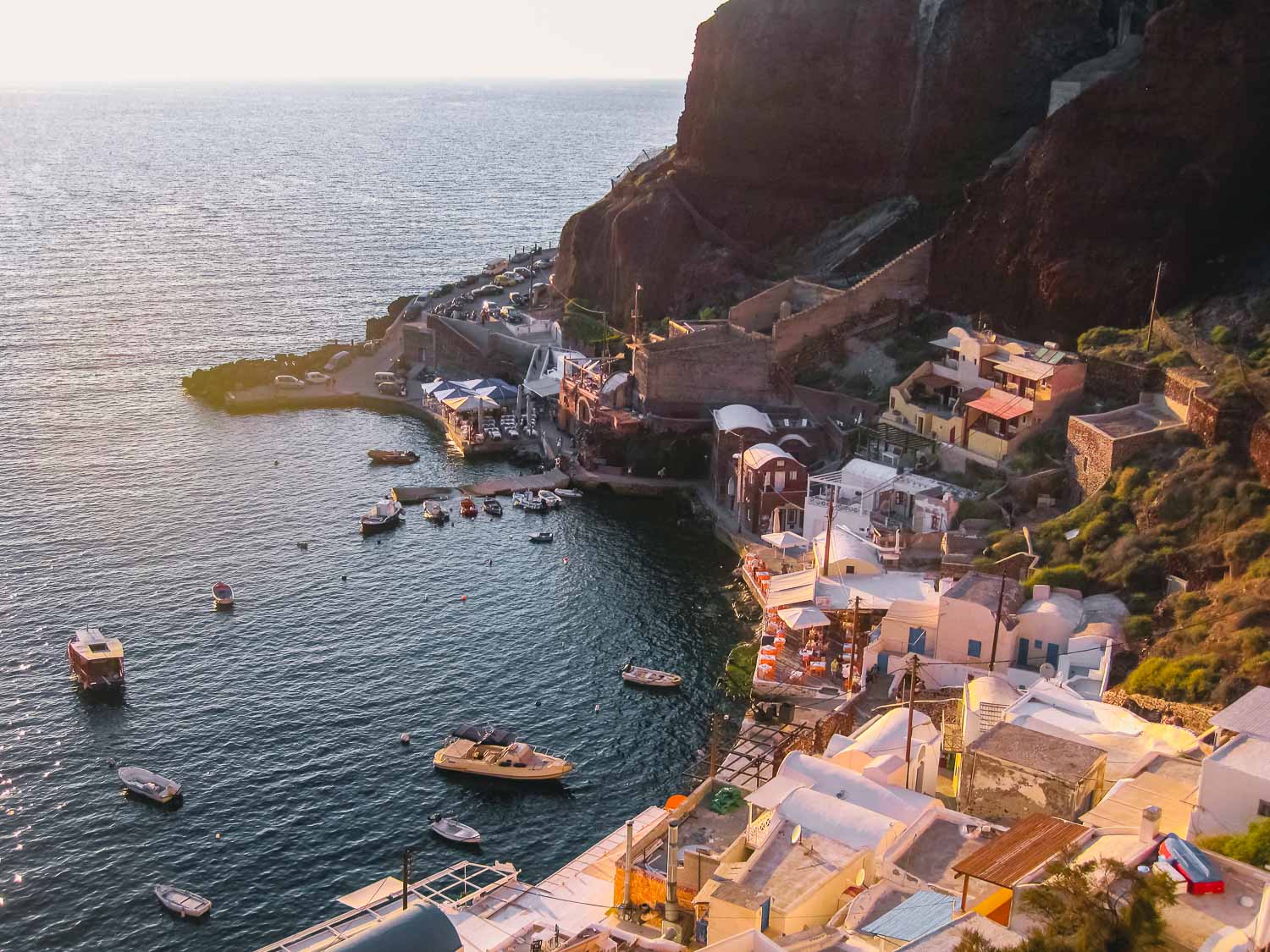
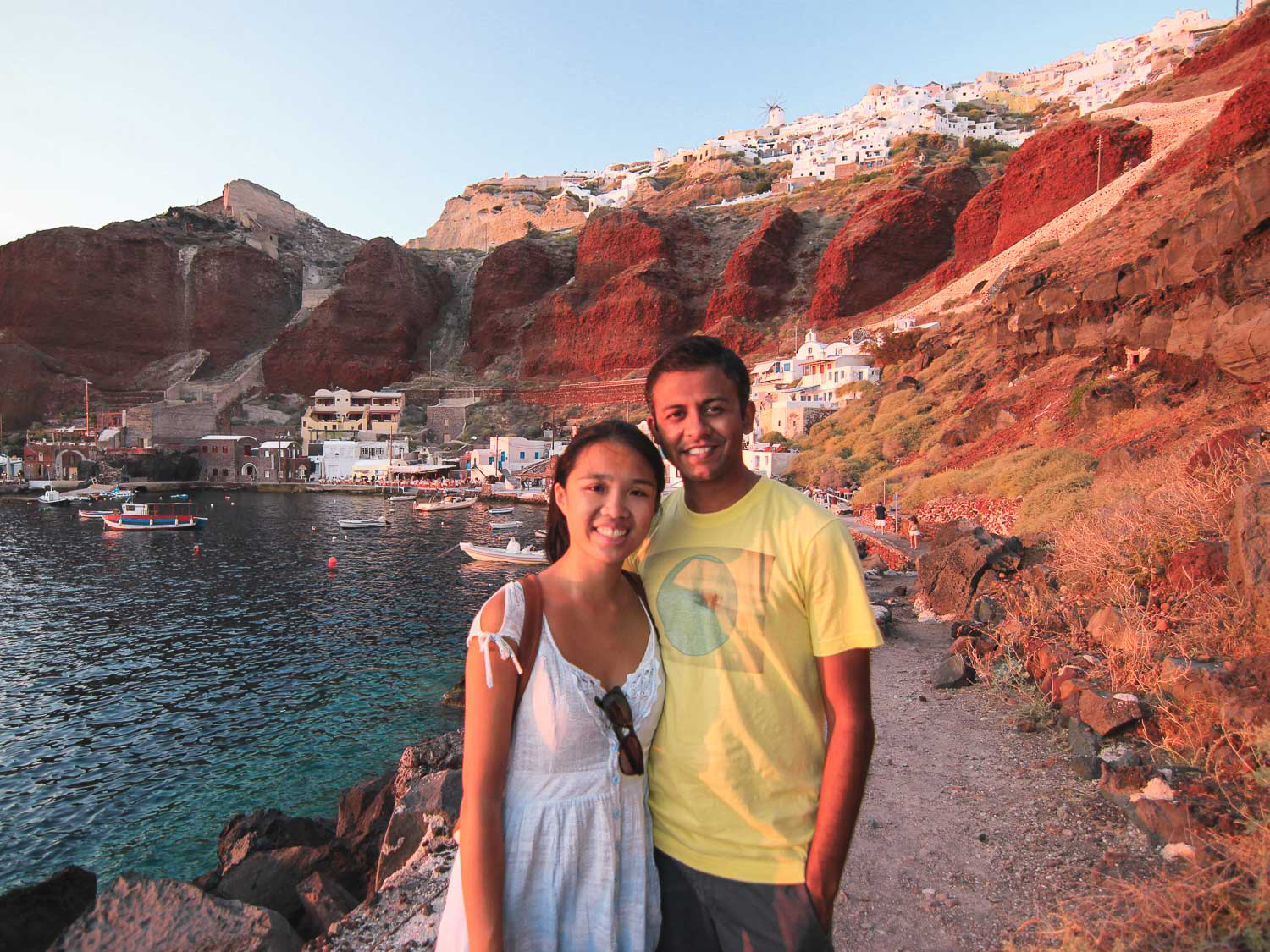
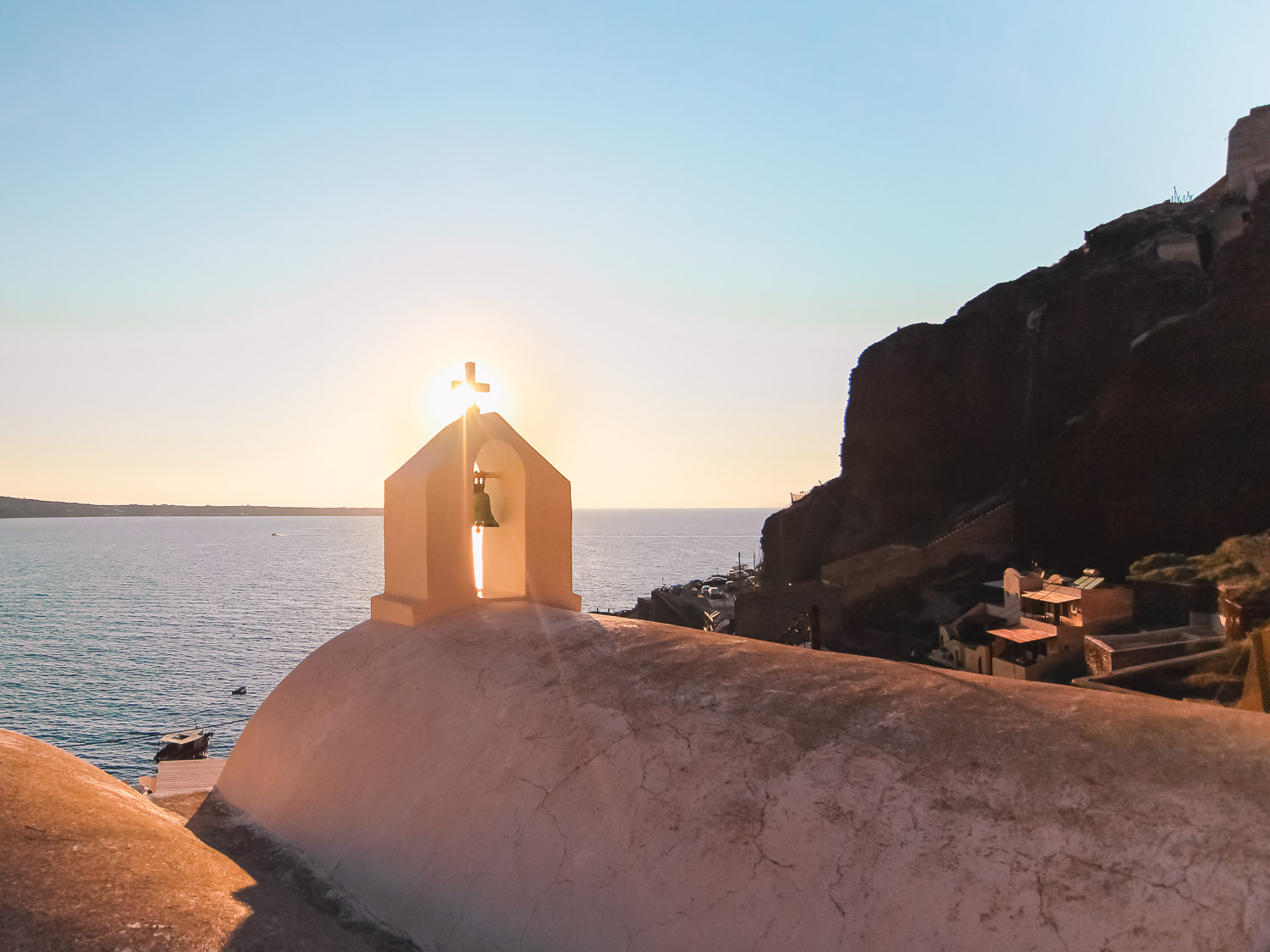
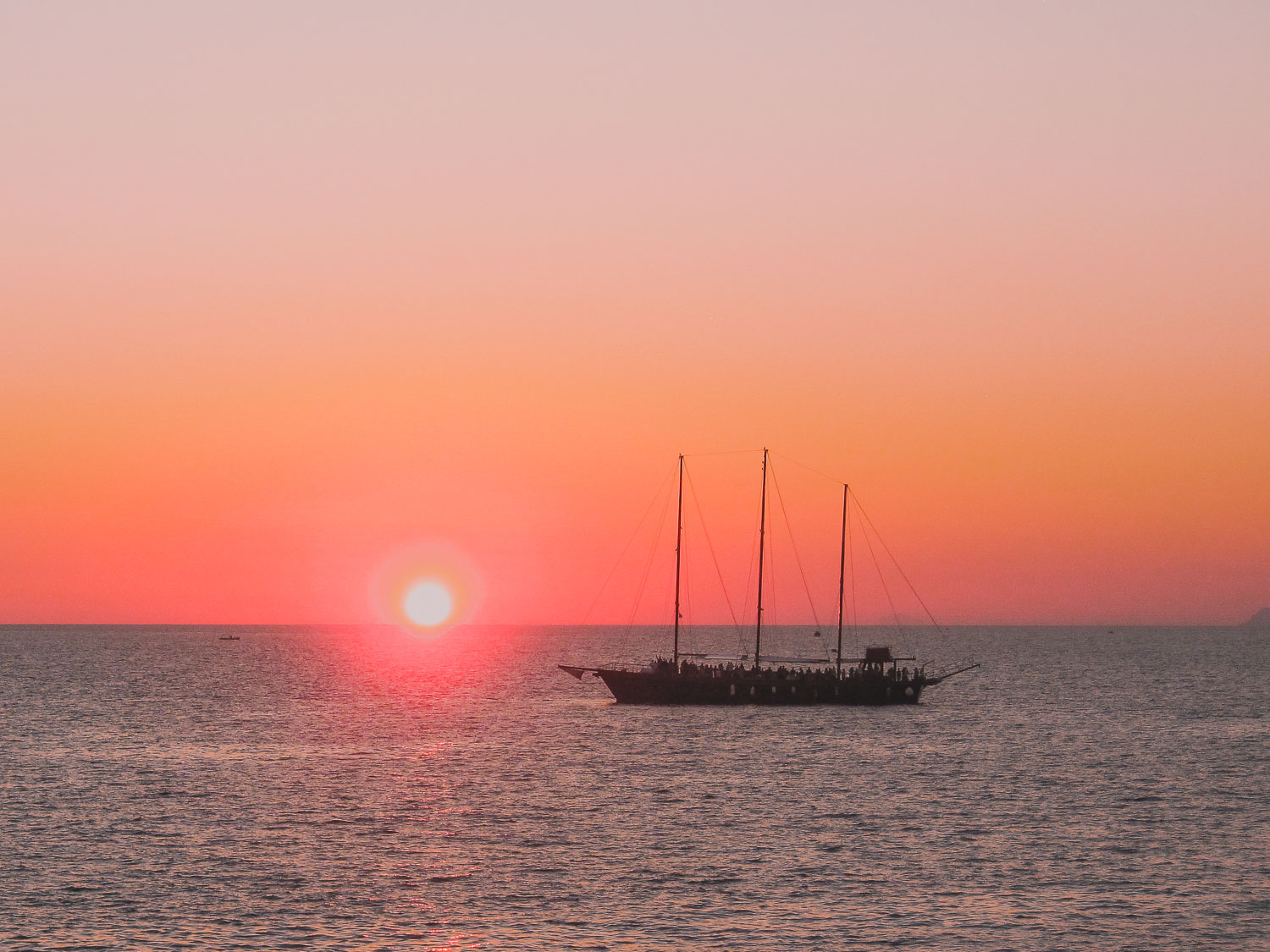
Sitting there watching this perfectly coordinated show, we couldn’t help but think about all the amazing experiences we had during the trip.
After sunset we asked a few locals for a mule ride up the cliff but unfortunately they were already done for the day. Thankfully we had company from other travelers, which made the climb back up less arduous. On the top it was busy as usual. We found a quiet place for our last Greek dinner and made sure to get in some more baklava at Melenio Cafe.
DAY 9: HOME
The next day we boarded our early morning flight to Athens and after a brief stopover were on our way to New York. Our short trip to Greece was a great introduction to its rich history, iconic landscapes, and the current economic reality. With more time we would have liked to explore the islands of Mykonos, Crete, and Zakynthos, but it will have to wait for another time.
